Editor’s note: TPG’s Gene Sloan accepted a free trip from Carnival Cruise Line to sail on Carnival Venezia. The opinions expressed below are entirely his and weren’t subject to review by the line.
Carnival Venezia is the Carnival ship you book in lieu of a trip to The Venetian in Las Vegas — or maybe the Italy area of Epcot at Disney World.
From a real gondola “sailing” down the middle of its main dining room to a pool deck built to look like a Venetian boulevard, Carnival Venezia boasts a Venice-themed design that makes you feel like you’ve stolen away to the iconic Italian destination. The theming carries through to just about everything on board, from the handmade Italian gelato on offer at JavaBlue Cafe to the Italian liqueur-infused concoctions found at many bars.
Like all Carnival ships, Carnival Venezia is a vessel aimed at travelers looking for an affordable, fun and lively cruise vacation. But it’s one with an Italian twist — one so strong that you suspect there’s a backstory, and indeed there is.
Carnival Venezia was never meant to be in the Carnival fleet. It was originally built for an Italy-based cruise line.
But now that it’s part of Carnival, it seems to fit right in.
Overview of Carnival Venezia
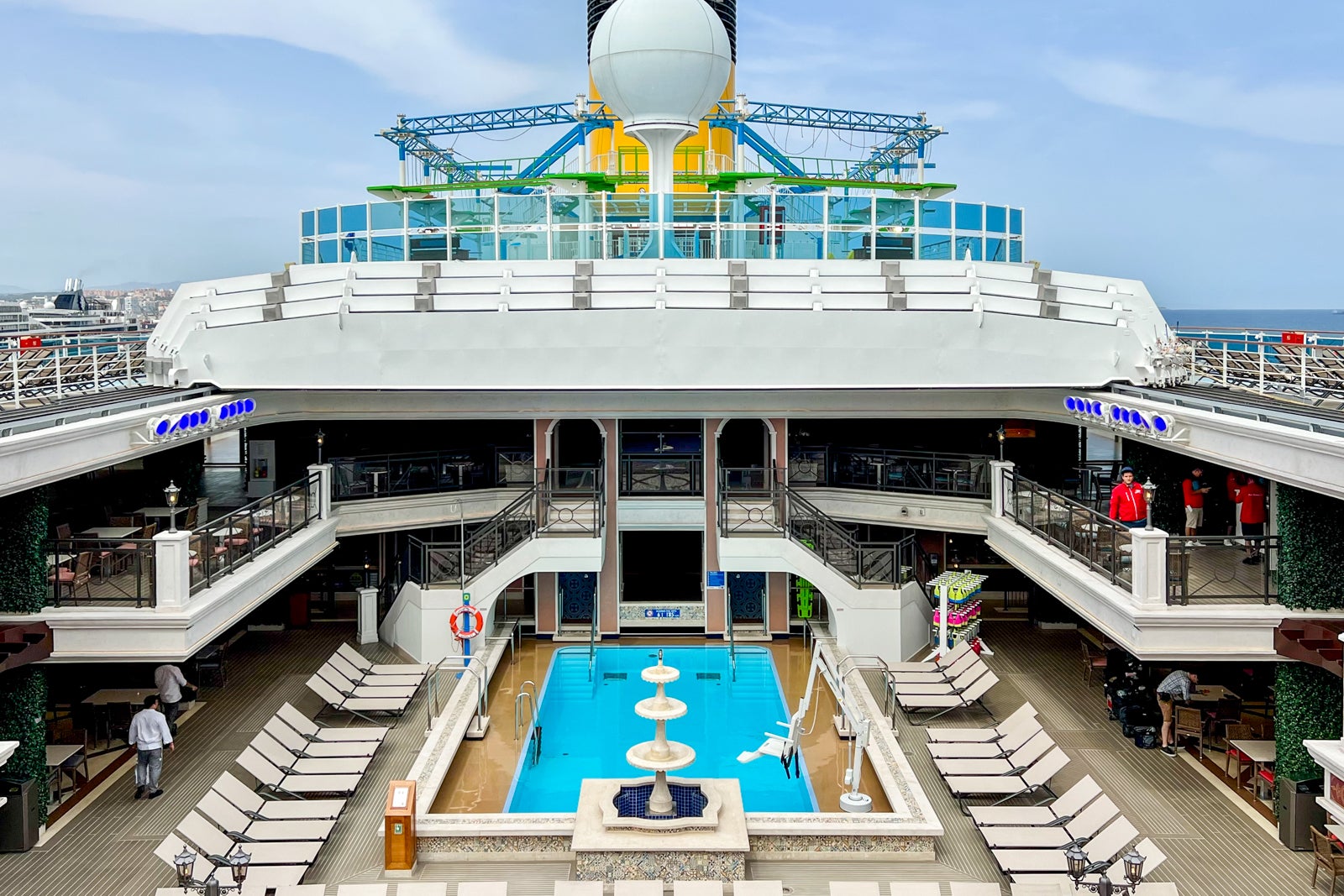
Carnival Venezia is the newest ship in the Carnival fleet, having joined the line in May 2023. But, as noted above, it’s new with an asterisk. The 4,090-passenger vessel was originally launched in 2019 for a different line — Italy-based Costa Cruises — and is already 3 years old.
Carnival Corporation, which is the parent company of both Costa and Carnival, transferred the ship between the two brands in 2023 due to shifting demand for cruises in the markets where the two lines operate.
This makes Carnival Venezia something of an outlier in the Carnival fleet. While it underwent an overhaul in dry dock to add many of Carnival’s signature venues, it retains much of its Costa-aligned, Italian-themed design.
For cruise news, reviews and tips, sign up for TPG’s cruise newsletter
This includes, notably, many public spaces that offer design nods to the palaces lining Venice’s Grand Canal. (Venice is the inspiration for much of the ship’s theming.) It also still boasts its original and distinctive yellow-and-blue Costa funnel (there’s no Carnival “whale tail” on this ship).
In short, Carnival Venezia combines elements of both Costa and Carnival ships — enough so that Carnival originally planned to call the ship a “Costa by Carnival” product to differentiate it from the rest of the Carnival fleet. Carnival has since switched to marketing Carnival Venezia as a vessel that offers “Carnival Fun Italian Style.”
All that said, as I saw in late May while sailing on Carnival Venezia’s first voyage under the Carnival banner, it’s a ship on which Carnival fans will probably feel right at home, despite its Costa roots. The Carnival and Costa brands have many similarities, and their ships are often built on the same platforms. While Carnival Venezia is considered a “Venezia-class” ship, it shares the same basic structural design and layout as Carnival’s three Vista-class vessels (Carnival Panorama, Carnival Horizon and Carnival Vista). If you’ve been on those ships, you’ll find the ship’s flow and location for venues strikingly familiar.
As is typical of Carnival (and Costa) ships, Carnival Venezia is an affordable, fun-focused vessel aimed at budget-minded vacationers looking to let loose and have a good time. It’s loaded with eateries, bars, showrooms and lots of upper-deck activity zones, including pool areas, a water park, a ropes course and a sports court.
What I loved about Carnival Venezia
Fun Ship vibe
Carnival Venezia may not be the fanciest cruise ship afloat. You won’t dine on foie gras and caviar or sleep on 1,000-thread-count sheets. But few vessels have such a fun vibe.
I loved that I could careen down a ripping waterslide, scramble across ropes more than 100 feet above the sea, practice my putting on a minigolf course and soak in a hot tub, all in advance of a night of bar-hopping, live music and not-for-your-kids late-night comedy.
This is true of pretty much every Carnival vessel, of course. This is the Fun Ship line, after all. But that doesn’t make it any less true for Carnival Venezia. It’s hard not to have a good time on this ship.
Italian theming
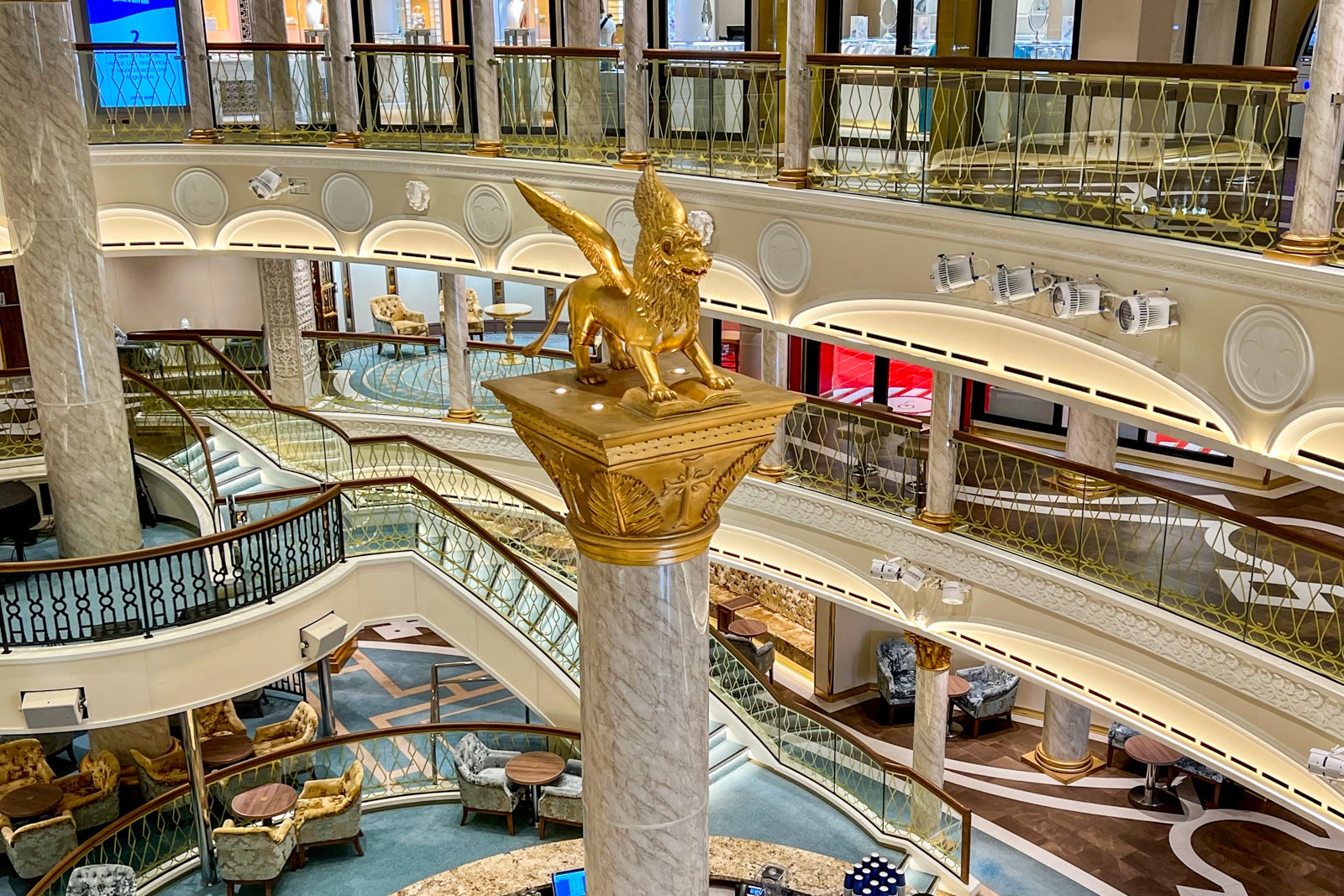
The Italian theming on Carnival Venezia was so strong when Carnival took over the ship from Italy-based Costa that, instead of stripping it away, Carnival chose to lean into it. When it sent the ship into dry dock in 2023 to become Carnivalized, the biggest new thing it added from scratch was … a high-end Italian restaurant.
It also doubled down on the Italian vibe with new Italy-themed drinks at multiple bars, including the new Italian liqueuer-focused Amari bar. The captain’s reception is themed as a Venetian masked ball, with the crew handing out Venetian masks for passengers to wear.
The theming is a little over-the-top in places. The golden lion of St. Mark, a symbol of Venice, looming over the ship’s central atrium on a giant faux-marble column sets the tone. But I found it wonderful in the way that Las Vegas resorts can be wonderful.
Carnival Venezia is a make-believe zone that whisks you away from your mundane, everyday life. There’s no mistaking you are on vacation here — if not in Italy, at least in a faux version of Italy. Be warned, Venetian Resort. You have new competition.
The drinks
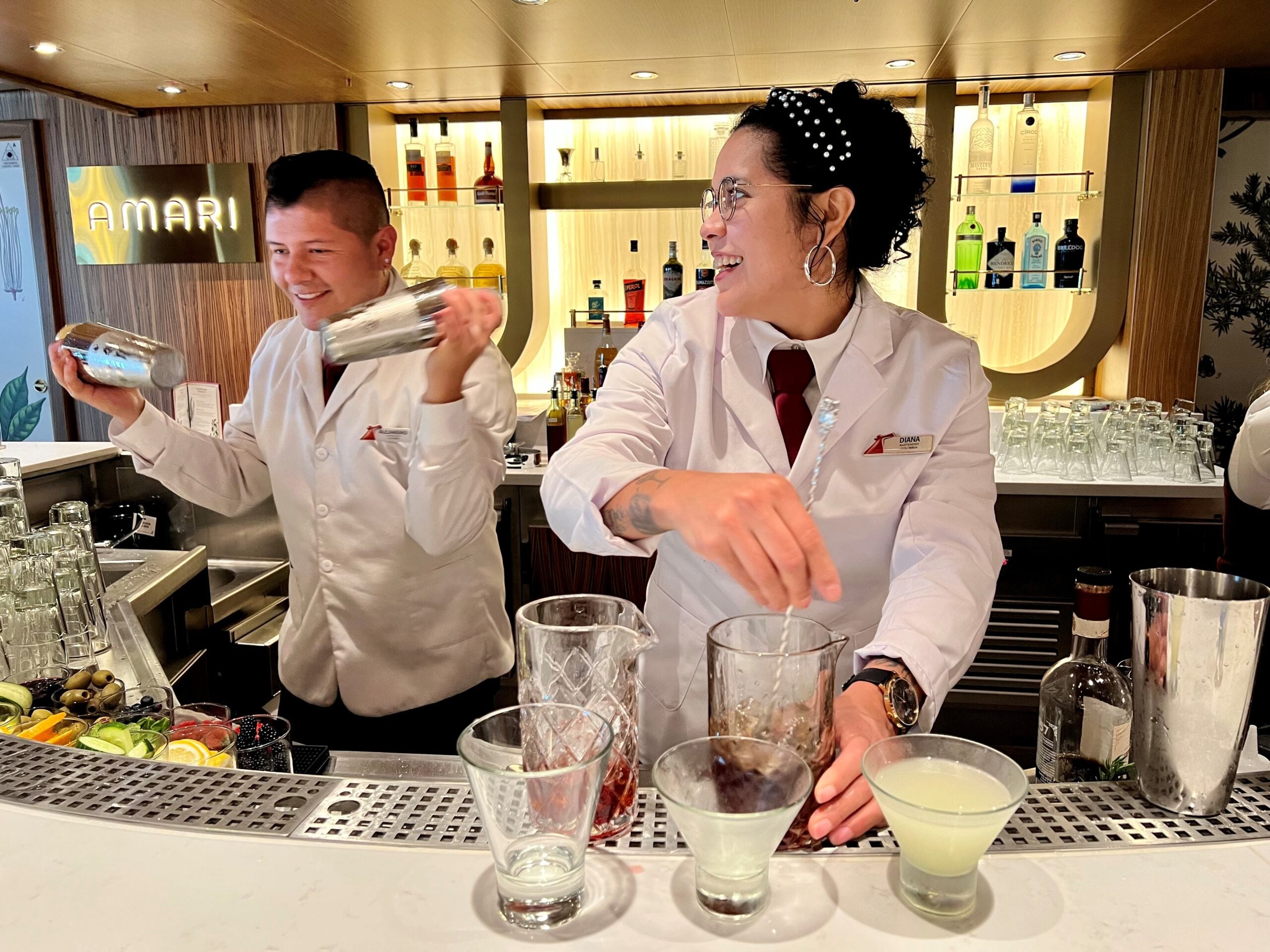
Carnival has jumped into the mixology craze in a big way with Carnival Venezia — but with an Italian twist. At many of its main bars, you’ll find creative concoctions made with unusual Italian liqueurs and bitters that you probably didn’t know existed.
In the name of research, I ordered up one oddball creation after another at the Italy-themed Amari bar, from the Bitter Guiseppe (a Manhattan-like drink infused with Cynar, an Italian bitter aperitif) to an Amalfi Martini made with Italy-made limoncello and limoncino — and, for the most part, loved them.
Related: Why the coolest new bar in North America may be on a Carnival ship
For the Middle America crowd that is a mainstay on Carnival ships, the cocktails are a fun and playful diversion from the typical pre-dinner drink routine typically centered on ho-hum concoctions like vodka tonics and American light lagers. When in Rome (or fake Venice), as they say.
What I didn’t love about Carnival Venezia
The Lido pool
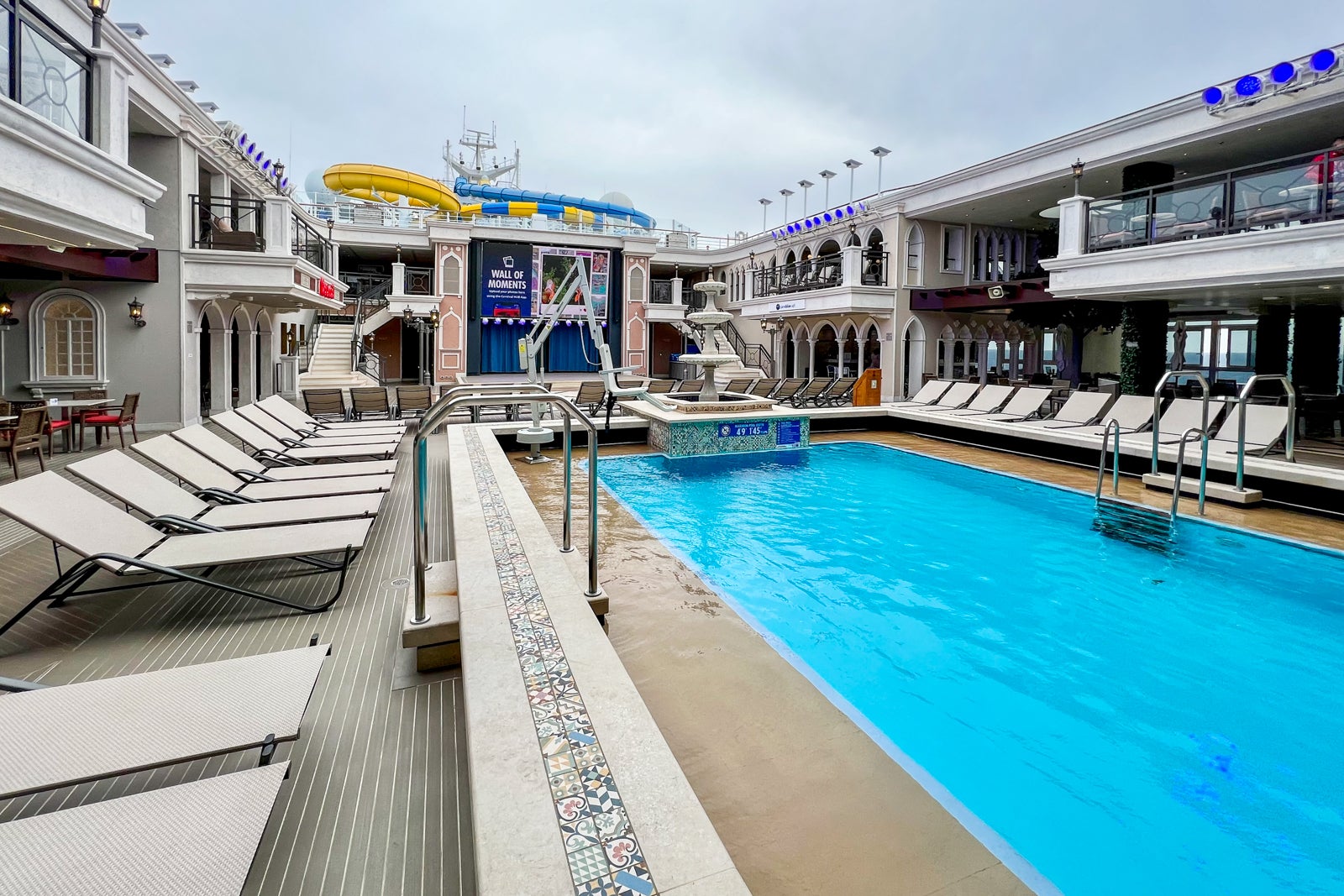
As noted above, Carnival Venezia was originally built for Italy-based Costa. But it was a Costa ship designed for a specific group of travelers: residents of China. The ship was originally to sail in Asia for the Chinese market, offering Chinese travelers a taste of cruising Italian style. The result is that it has one of the most convoluted main pool decks that I have ever seen — one that would have worked for the Chinese market but is flawed for an American crowd.
Specifically, the pool area has little open-to-the-sky lounge space for sunbathing. This was by design, as Chinese travelers, in general, do not sunbathe. They prefer to be shielded from the sun, and that sort of environment is what Costa delivered around the ship’s main pool.
The Lido pool, as it’s called, is surrounded by Venetian villa-themed “buildings” that house lots of covered lounge and eating areas — places you can sit and have a coffee covered from the sun (the area has an unusually large coffee bar for a Carnival ship, the JavaBlue Cafe) or scarf down a burger from the nearby Guy’s Burger Joint. There are two full decks of these covered, sunless areas around the pool, and if that weren’t enough, the area is topped with a glass magradome that can be closed to completely shield the area from the elements.
Even when left open, this magradome has enough apparatus associated with it that it noticeably eats away at the space available for sunning, though to be fair there is quite a bit of sunning space with lounge chairs at other areas of the ship’s top deck.
The cabin service
It’s not entirely fair to judge any part of a ship’s service based on its first sailing when the crew is still getting used to each other and the layout and procedures of a new vessel. That said, it’s fair to say that service provided by cabin attendants in general on Carnival ships isn’t quite what it used to be as the line cuts costs — something that will be true for Carnival Venezia six months from now as much as it is today.
My visit to Carnival Venezia in late May marked the first time I had sailed on Carnival since the line reduced cleaning service for cabins to just once a day from twice a day, which happened in 2022. Given the low price point of the typical Carnival cruise, it’s hard to argue that one should expect twice-a-day room cleaning. Still, this was always one of the big wows that set Carnival (and other cruise lines) apart from similarly priced land-based resorts. You got a room steward who seemingly was always there, keeping your room spick-and-span.
I met my room steward in passing in the hallway, and he seemed pleasant enough. But I didn’t feel the connection with him that I have in the past with some Carnival room stewards. And perhaps because I had my “Snoozin” do-not-disturb sign out a bit while working in my room, I went a full day and night at one point without my room being cleaned at all, which is something that never used to happen in the old days of twice-daily service.
Carnival Venezia cabins and suites
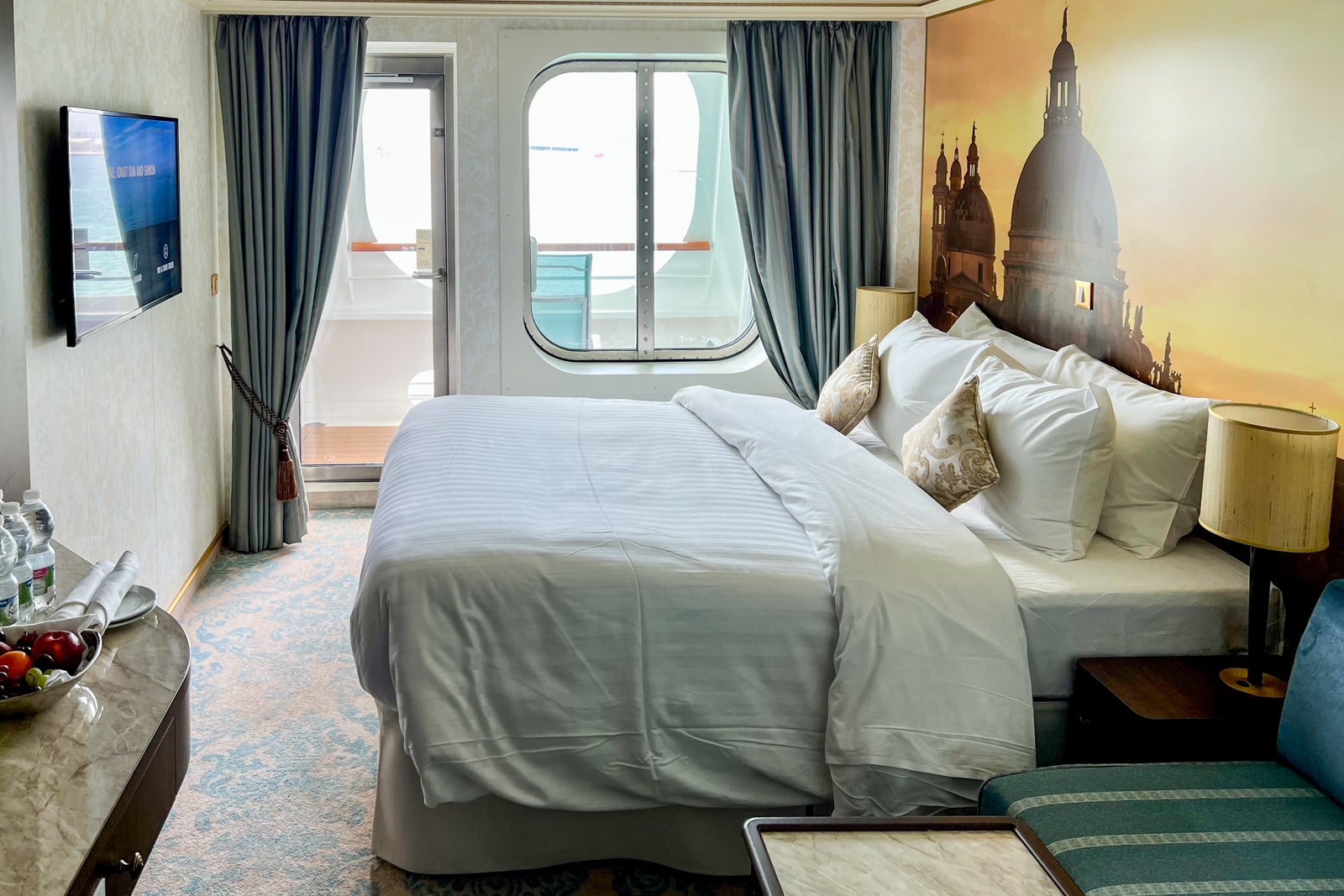
Carnival Venezia has 32 cabin and suite categories — a daunting number. But finding the right cabin category for you isn’t as complicated as that number might make it seem. Many cabin categories on Carnival Venezia are essentially the same, with the exception of where the rooms are located.
My cabin was a cove balcony cabin. Near the bottom of the ship on Deck 2, these are the least expensive balcony cabins on Carnival Venezia, in part because they have balconies that aren’t quite as open and light-filled as standard balcony rooms. Because they are near the ship’s waterline, the balconies are built with more protective steel than is normal, creating a somewhat enclosed “cove” effect.
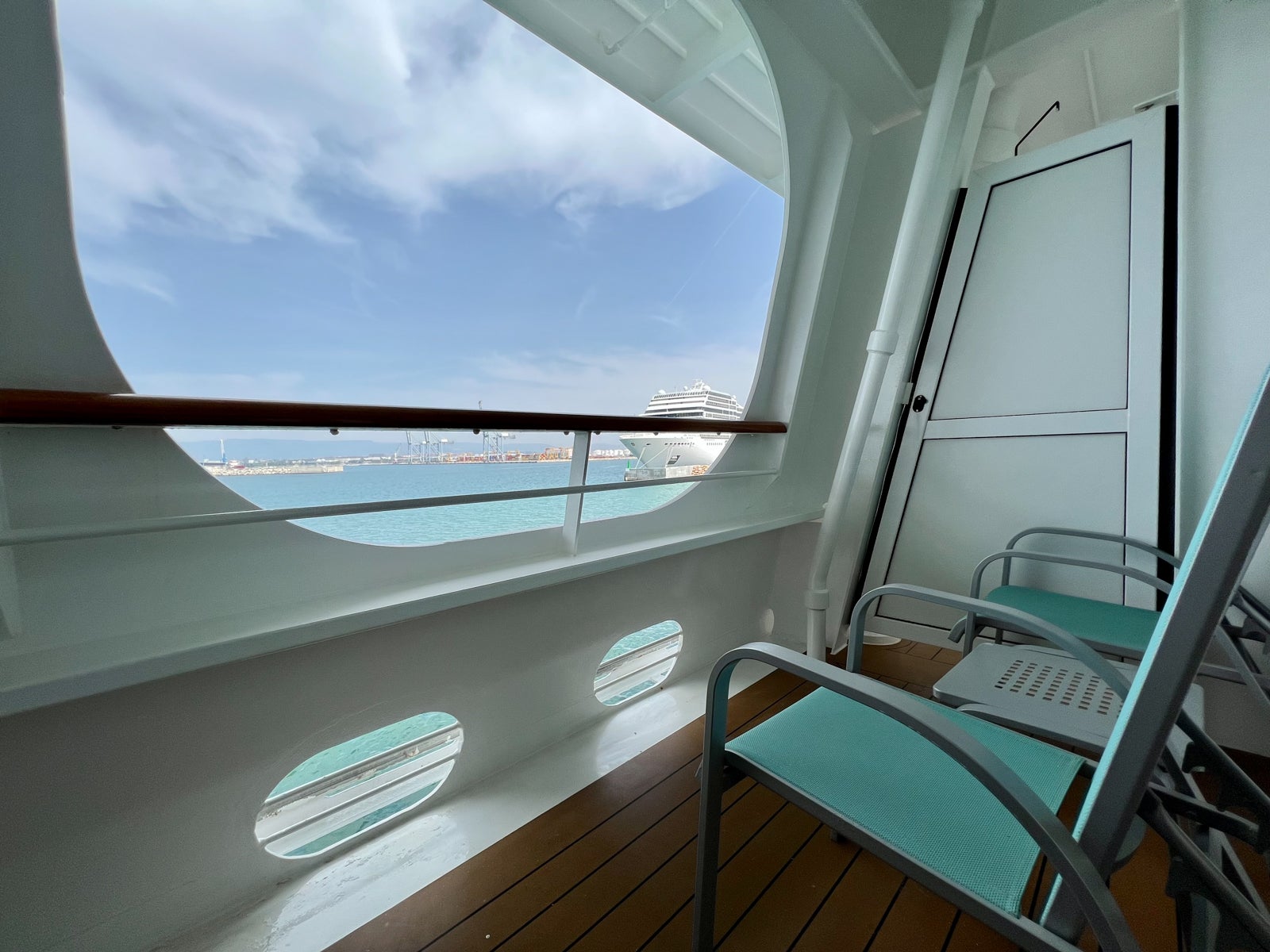
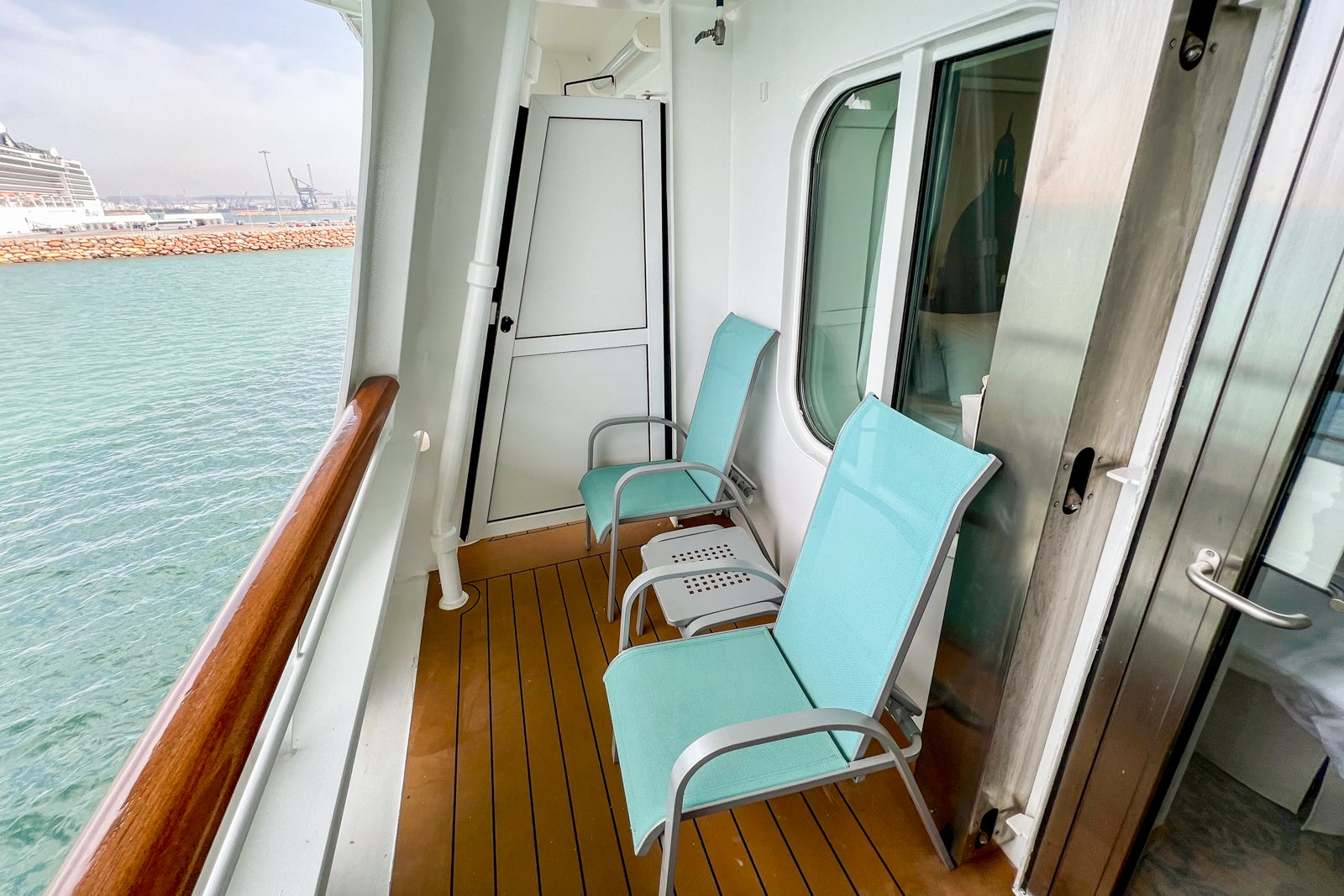
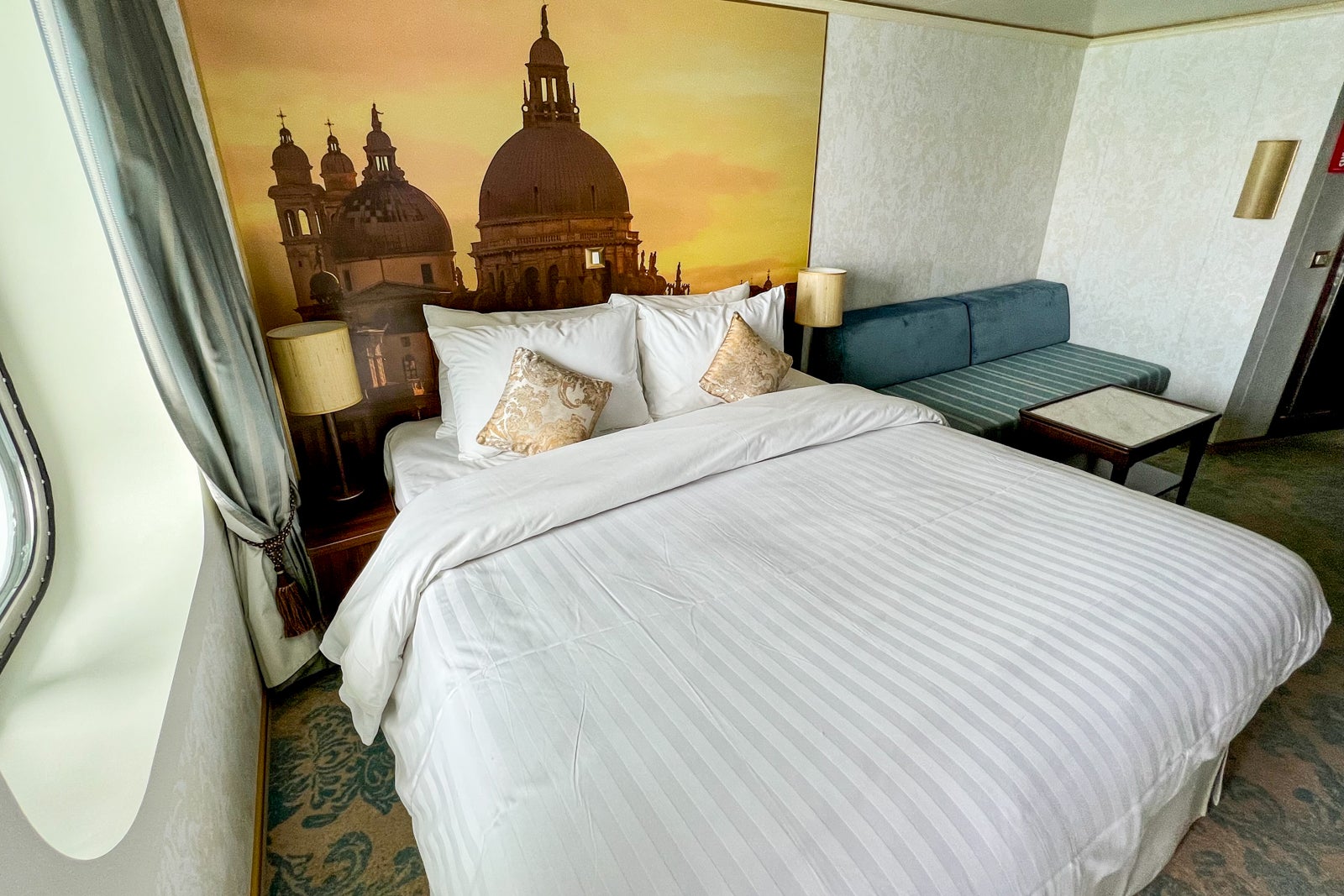
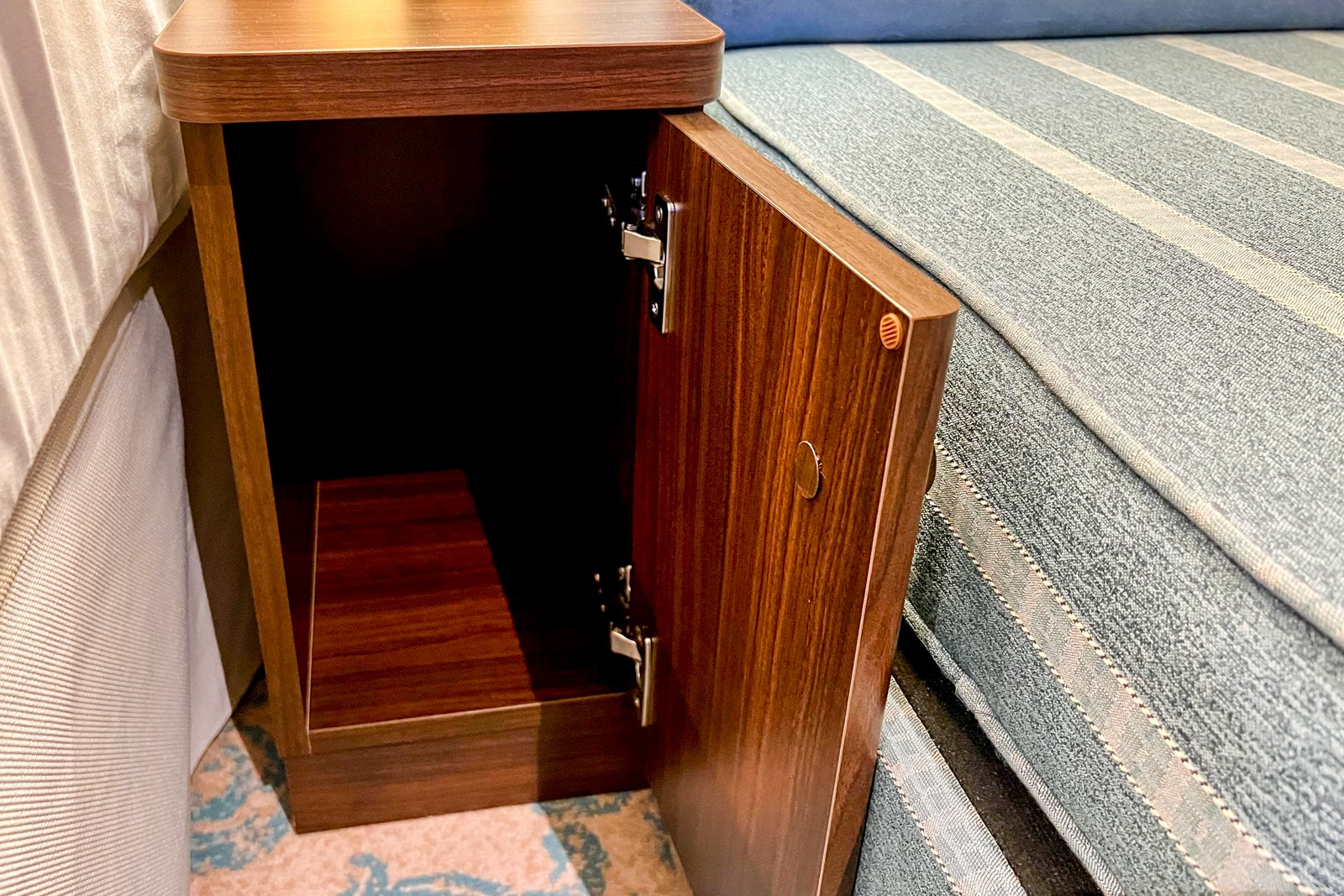
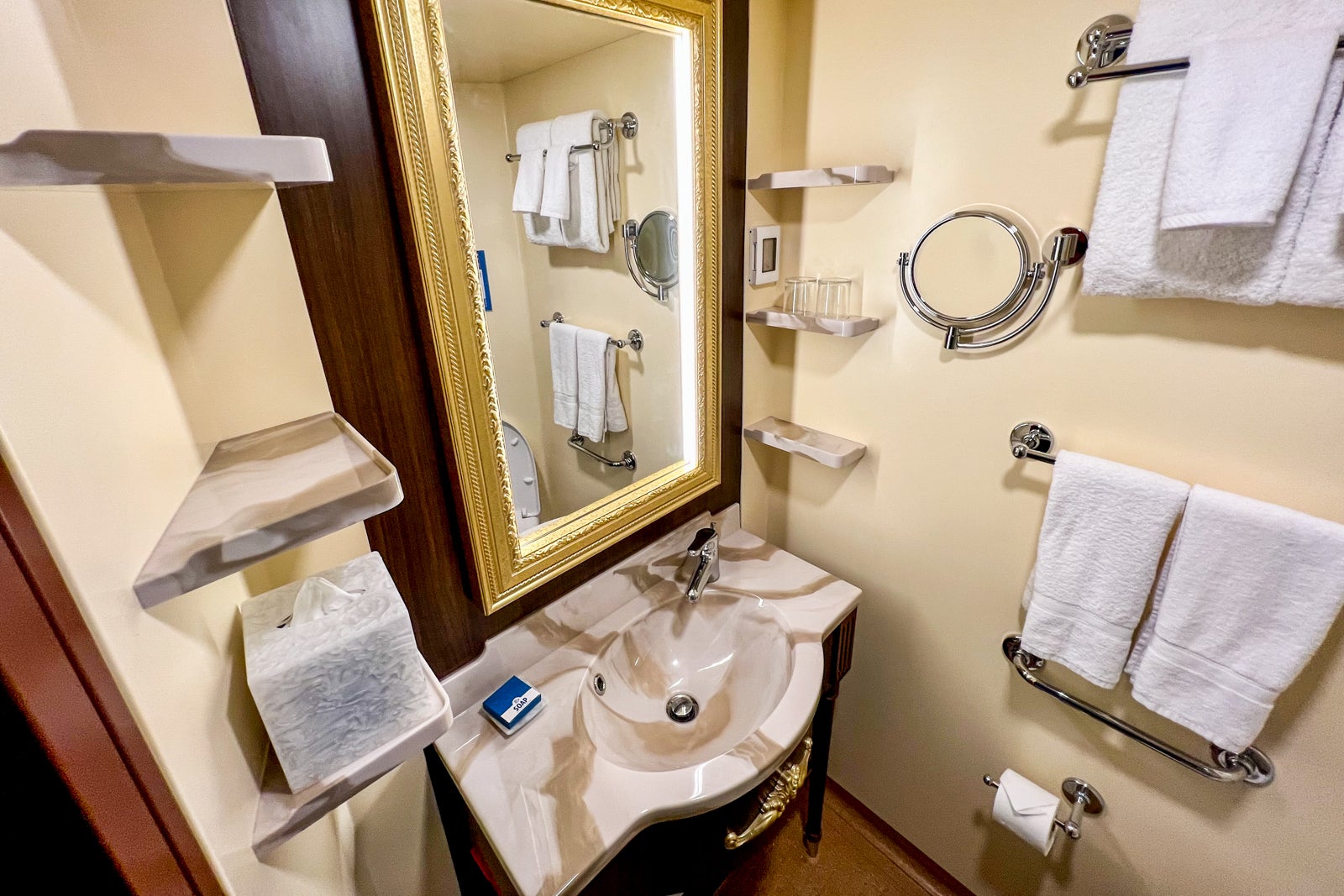
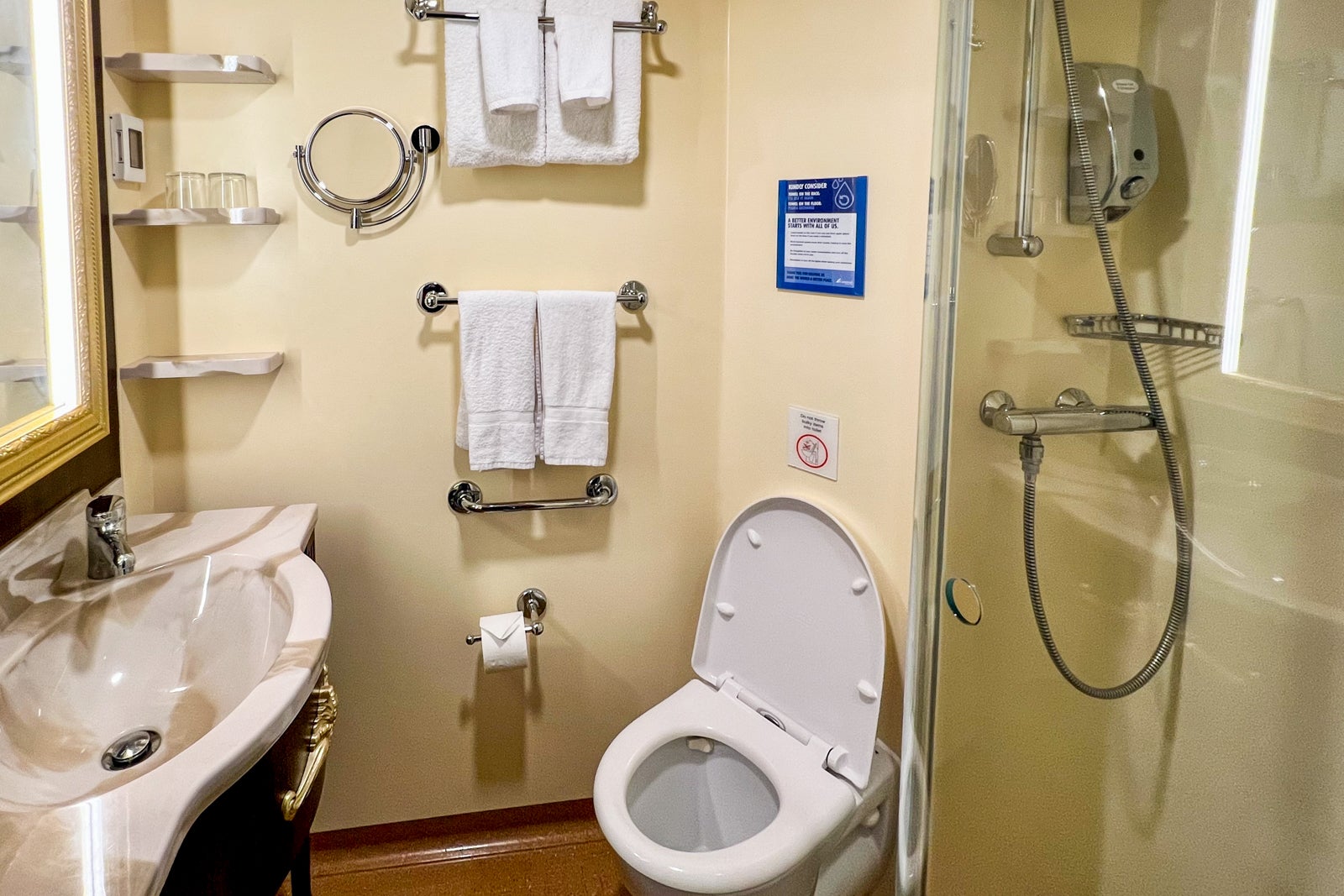
Other than that, cove balcony cabins (of which there are 110) are identical to the far more common standard balcony cabins that account for the greatest segment of Carnival Venezia accommodations (794 out of 2,045 cabins), all of which are located much higher on the ship.
Both standard balcony cabins and cove balcony cabins have the same interior space (185 square feet) with identical furnishings — a queen bed that can be split into two single beds; a built-in desk area with a miniature refrigerator; a seating area with a sofa and small table; built-in closets; and a bathroom.
Cove balcony cabins are priced a little lower than standard balcony cabins because, in theory, their unusual balcony configurations and low-on-the-ship locations make them less desirable. But to me, the more-enclosed nature of the balcony isn’t a major drawback, and the closer-to-the-waterline location of the cabins is a plus, not a minus.
I love lounging on cruise ship balconies that are close to the waterline. You get more of a sense of the ship’s movement through the waves and can sometimes spot waterbirds gliding just above the water.
There’s a magical connection to the sea that one only gets from staying in a cabin near the waterline. You won’t find that when you’re lording it over the ship in a high-priced cabin or suite on Deck 12 or 14.
For the most part, I was happy with my cove balcony cabin on Carnival Venezia. Clearly, it won’t win any awards for style. Its relatively bland white-and-cream walls and neutral, blue-accented carpeting are designed to fade into the background. The bedding is perfectly adequate for the Carnival price point but nothing memorable, with somewhat cheap-feeling polyester pillows topped with cotton pillowcases.
Still, my cove balcony cabin overall had a bit of an elevated feel compared to cabins on some Carnival vessels, and it ticked all the boxes for a cabin on a budget ship. There was ample storage for two in the floor-to-ceiling built-in closets, which notably were deep enough that my dress jackets and shirts could fit straight in on a hangar without having to be pushed to the side when it came time to close the door — something that isn’t always the case even on higher-end ships.
While the nightstands next to the bed were so small and narrow that they seemed like afterthoughts, both did have built-in lamps for reading at night, and one side of the bed was nicely equipped with two USB ports. (Memo to Carnival: In a perfect world, you’d want these on both sides of the bed!)
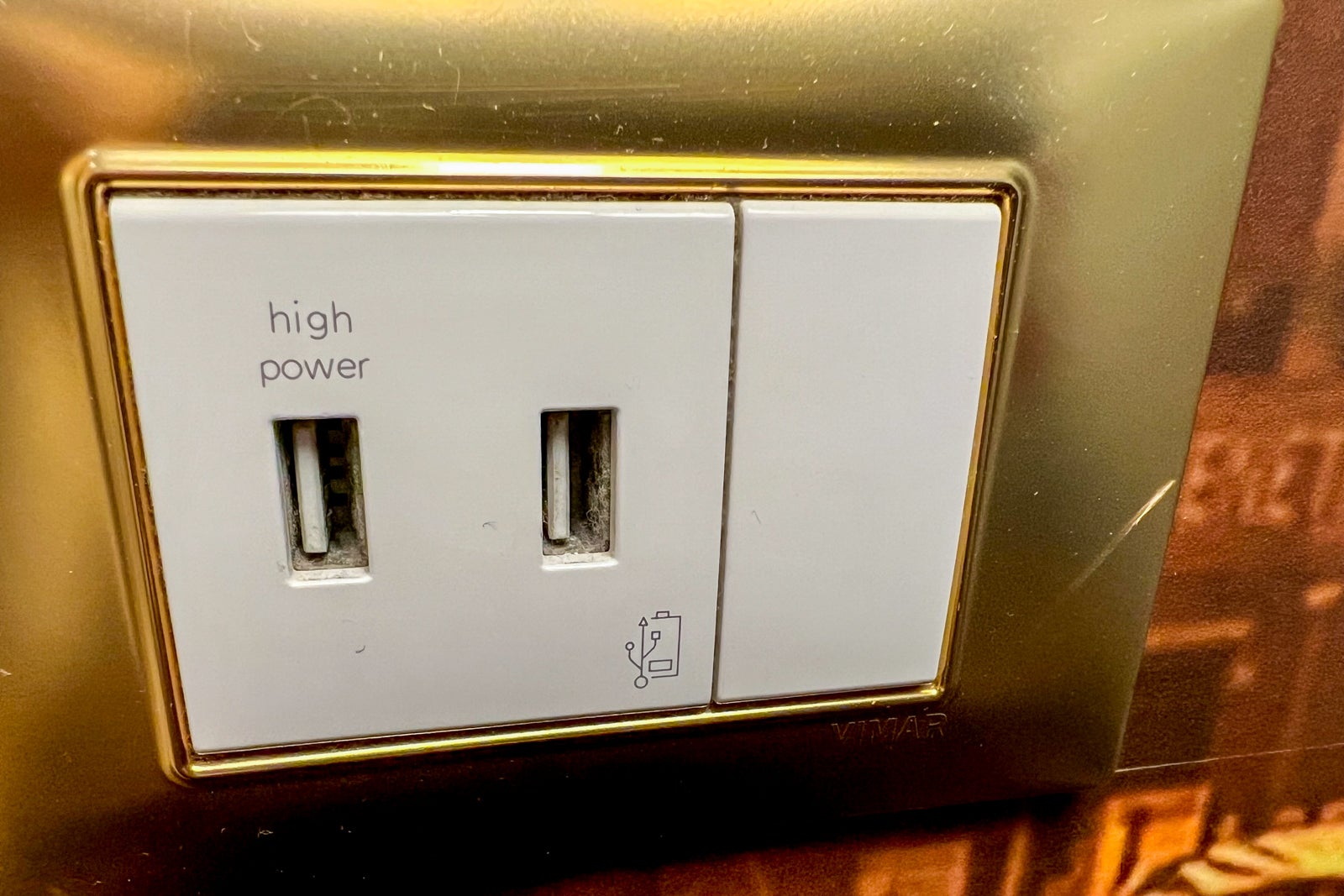
Two more USB ports are located across the room at the built-in desk area, which also has two U.S.-style 120V plugs, a European-style 230V plug and a completely superfluous and destined-never-to-be-used “type I” 220V plug. I suspect the latter is a throwback to when the ship was scheduled to sail in China. I had to Google it to figure out what the heck it was.
As is typical for Carnival ships, the cabin bathroom is functional, if not particularly stylish or upscale in feel. You won’t find marble-topped sinks or elegantly tiled showers with sleek Hansgrohe fixtures at this price point. However, the fiberglass-molded shower space has (just) enough room so you don’t hit the wall when soaping, and there is ample storage space for toiletries on three open shelves located on each side of the vanity. (The vanity, it should be noted, has faux Venetian wood cabinetry and a golden mirror, in keeping with the ship’s Italian styling.)
My biggest quibble with the bathroom, besides it being eminently bland, is its overall color scheme. It has brown textured fiberglass floors and light yellow walls that I suspect will become dated over time. It already looks a bit dowdy.
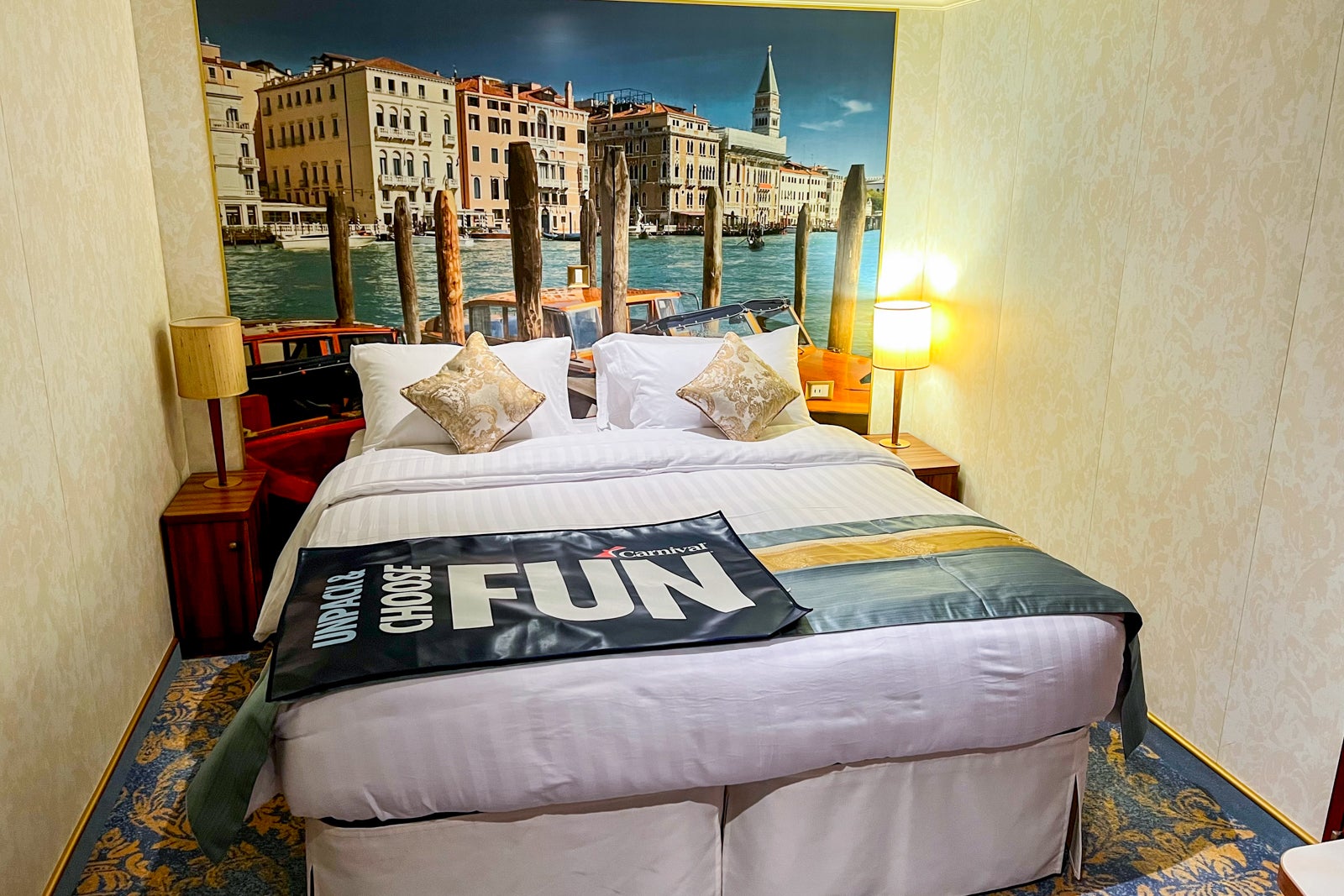
On a more positive note, Carnival Venezia is one of the rare Carnival ships that doesn’t have air vents carved into cabin doors — something that often makes cabins on Carnival ships less soundproof than cabins on competing lines. This is one area where inheriting a vessel from sister line Costa was an advantage.
Other Carnival Venezia cabin tidbits:
- There are red “Snoozin'” cards to hang on your door when you don’t want to be disturbed, which strikes us as a bit of an old-school way to do a do-not -disturb notice. Many cruise lines in recent years have switched to more sophisticated electronic systems that let you push a button inside your room to turn on a do-not-disturb light outside your door.
- Every cabin has a small hair dryer in a drawer in the desk area and a personal safe in the closet.
- There’s a flat-screen television on the wall with movies on demand that, in many cases, are free. Carnival normally only charges for some first-run movies at a current rate of $6.99 per movie.
Those who want something a bit more exclusive than a standard or cove balcony cabin can book one of the 77 so-called Terrazza Carnavale cabins at the back of the ship. These rooms come with exclusive access to a private outdoor sunning area with lounge chairs, hot tubs, cabanas and a bar called the Terrazza Carnevale.
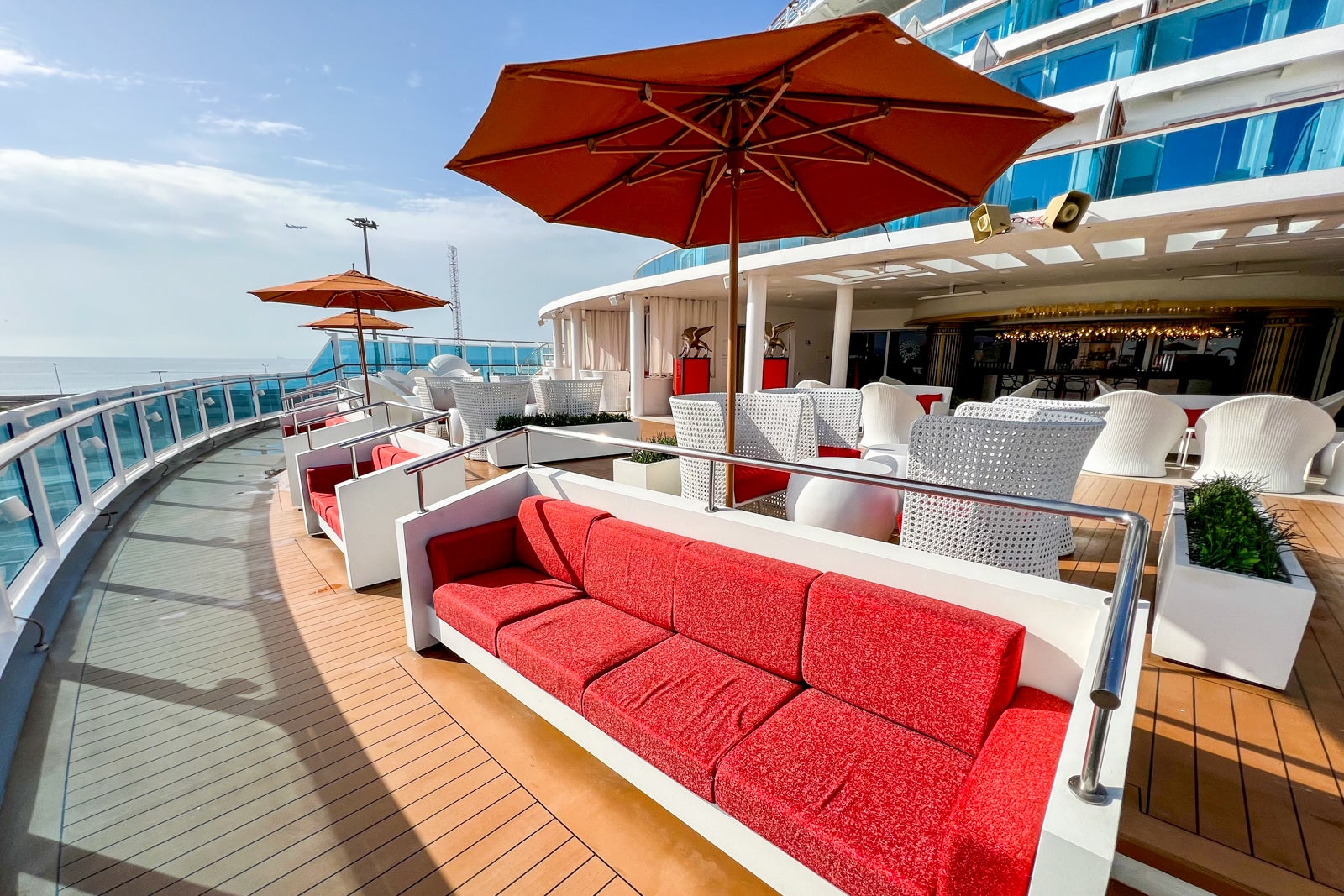
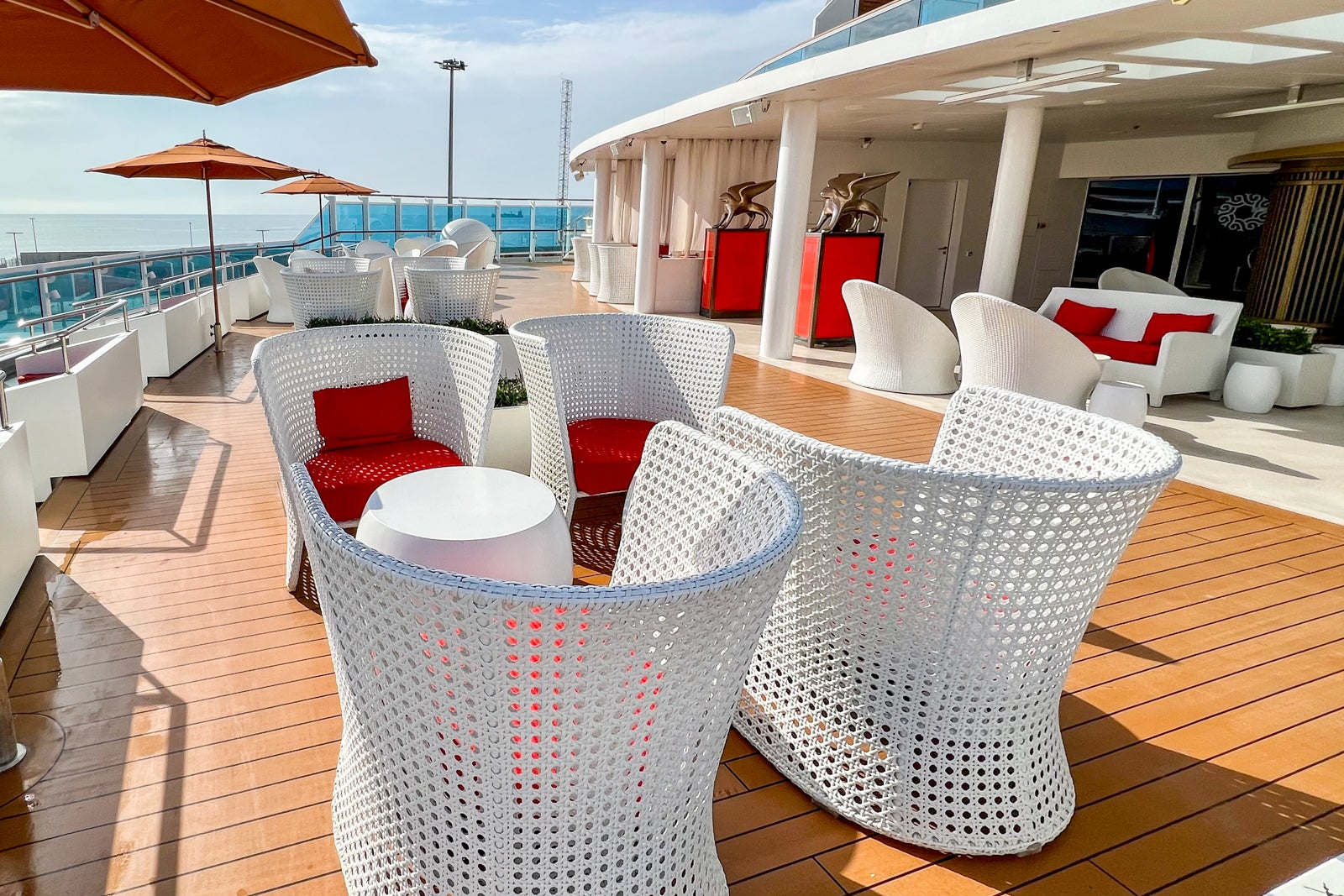
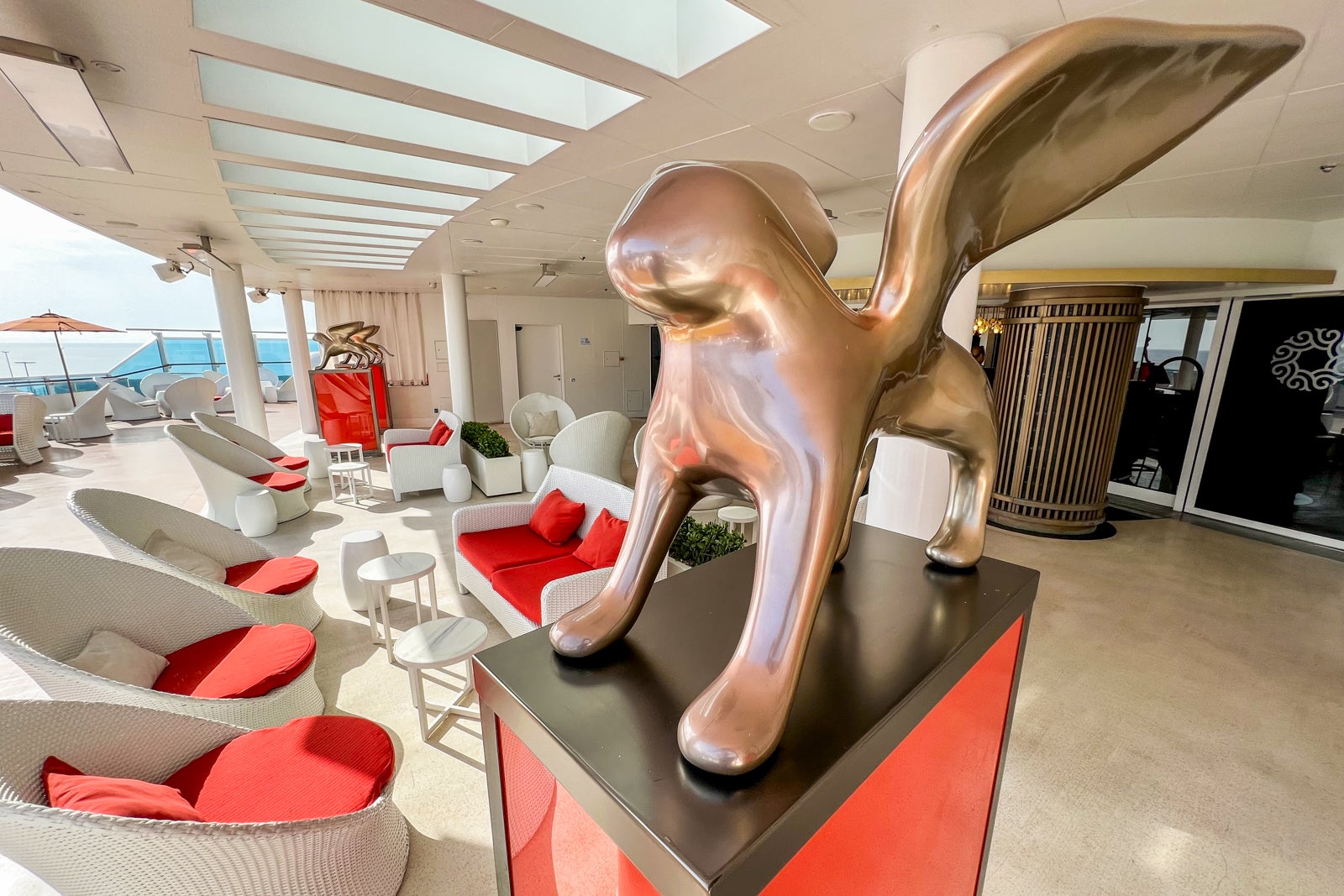
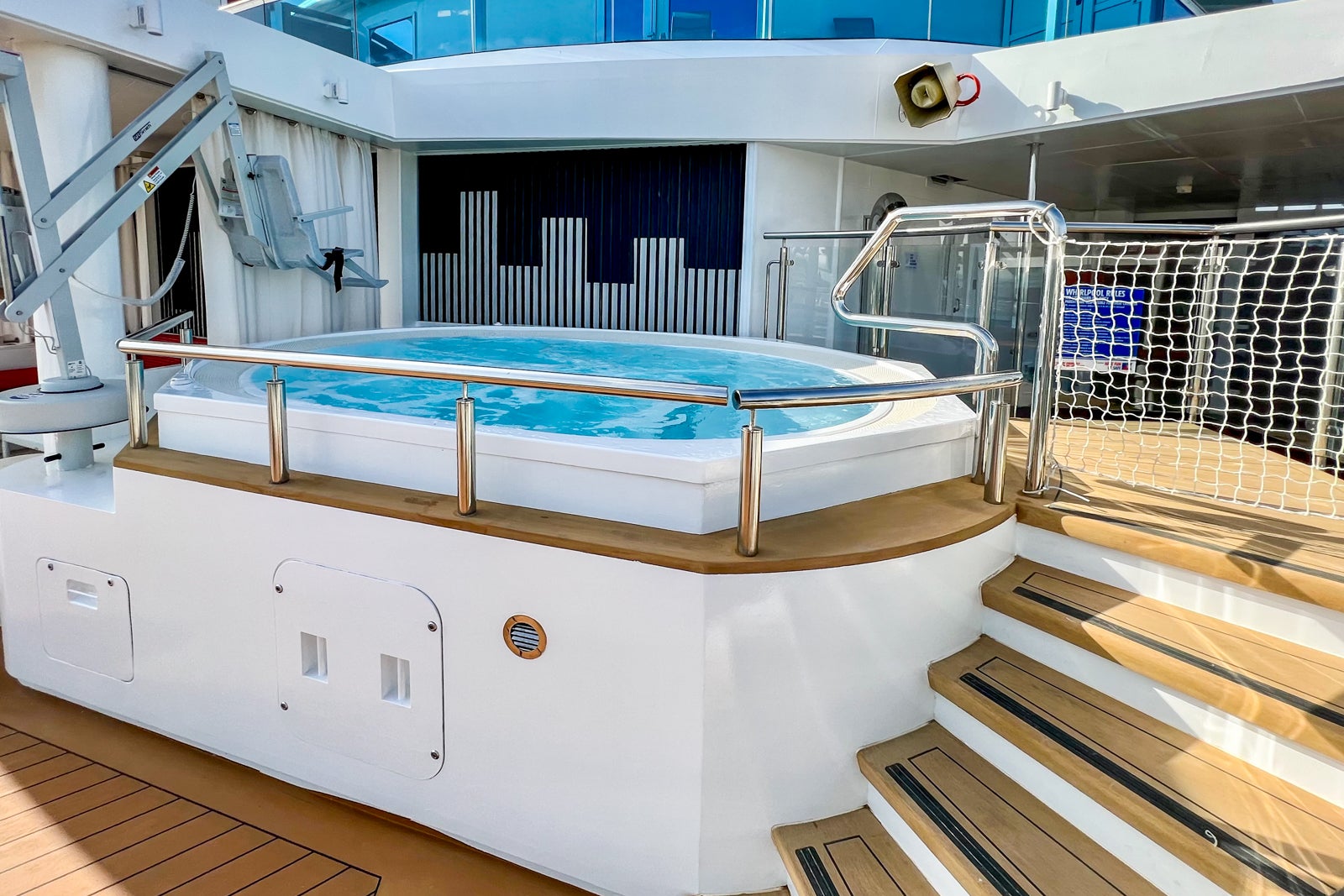
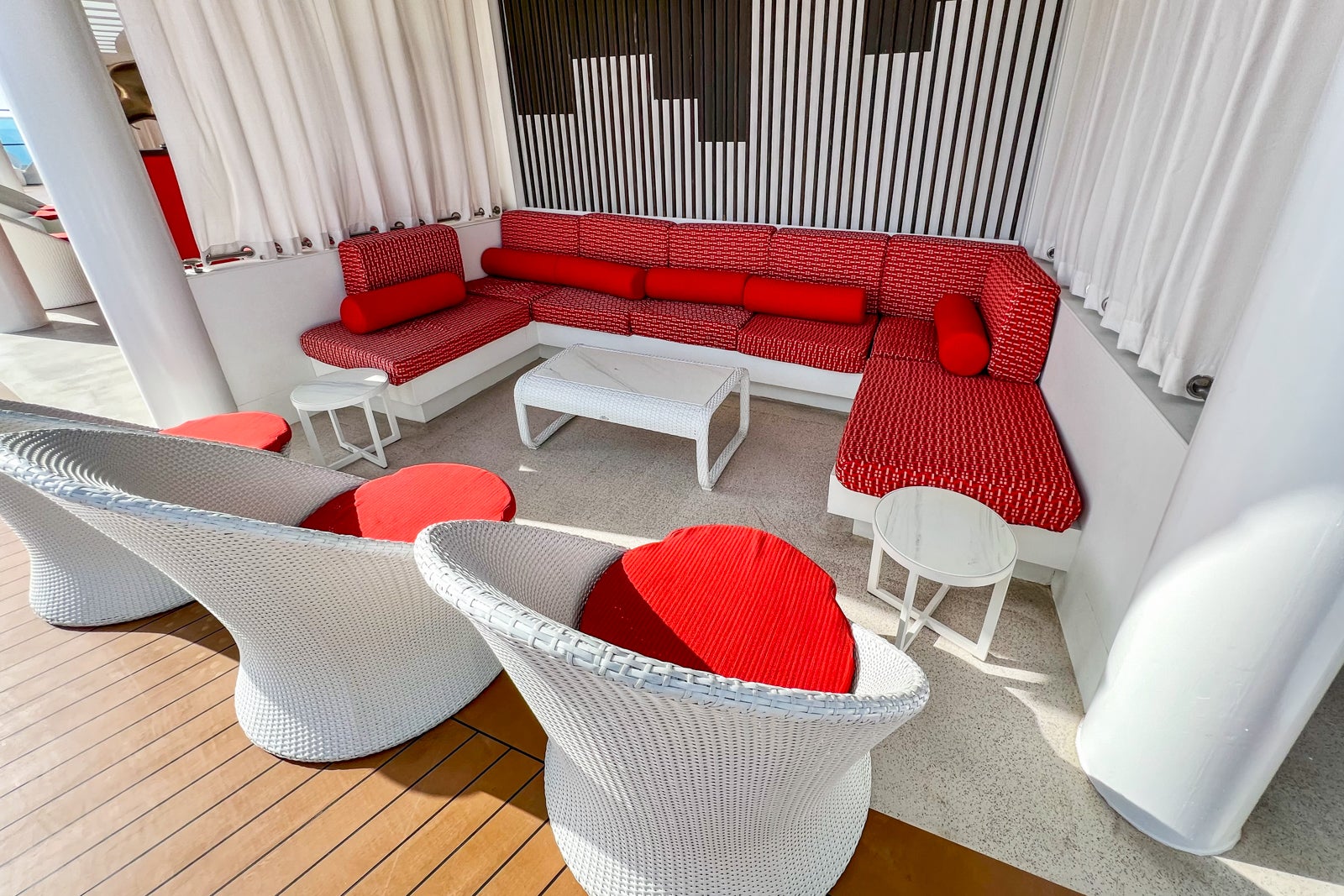
In addition, passengers staying in Terrazza Carnevale cabins get exclusive access to daily continental breakfast in the adjacent Carnevale Lounge; a specially curated brunch on select sea days, with a complimentary spritz or mimosa; and a private sailaway event with live music at the Terrazza Carnevale.
There are five types of Terrazza Carnavale cabins, all in the same general area at the back of the ship near the Terrazza Carnevale Lounge area. These include 26 aft-facing cabins across decks 6, 7, 8 and 9 that have extended curving balconies looking out over the back of the vessel and eight so-called Premium Vista balconies at the back corners of the ship that have extremely large, wrap-around balconies.
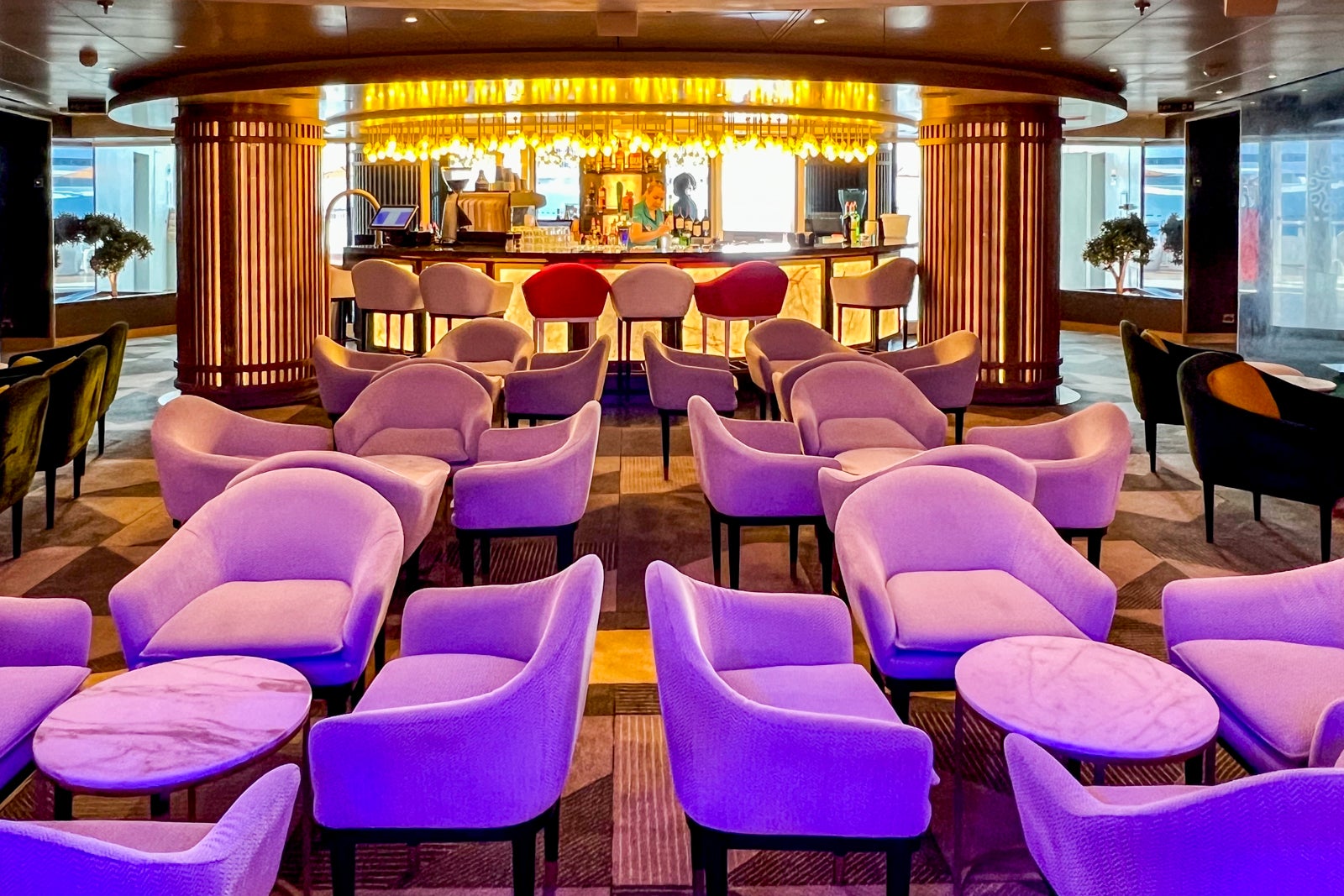
In addition, this Terazza Carnevale area of the ship has 27 Cabana cabins that have extended “cabana” balcony areas with lounge chairs and hammocks for lounging. Fourteen interior cabins are also part of this exclusive Terrazza Carnevale area.
Passengers must be 12 or older to stay in a Terrazza Carnevale cabin and enter the area’s private outdoor lounge.
Carnival Venezia also has 20 suites, all the same in size and amenities. Dubbed the Ocean Suites, these accommodations aren’t really suites in the true sense as much as larger-than-normal balcony cabins. Most measure 275 square feet, not including 65-square-foot balconies, and have a single bedroom with a sofa and table across from the bed, plus a larger-than-normal bathroom.
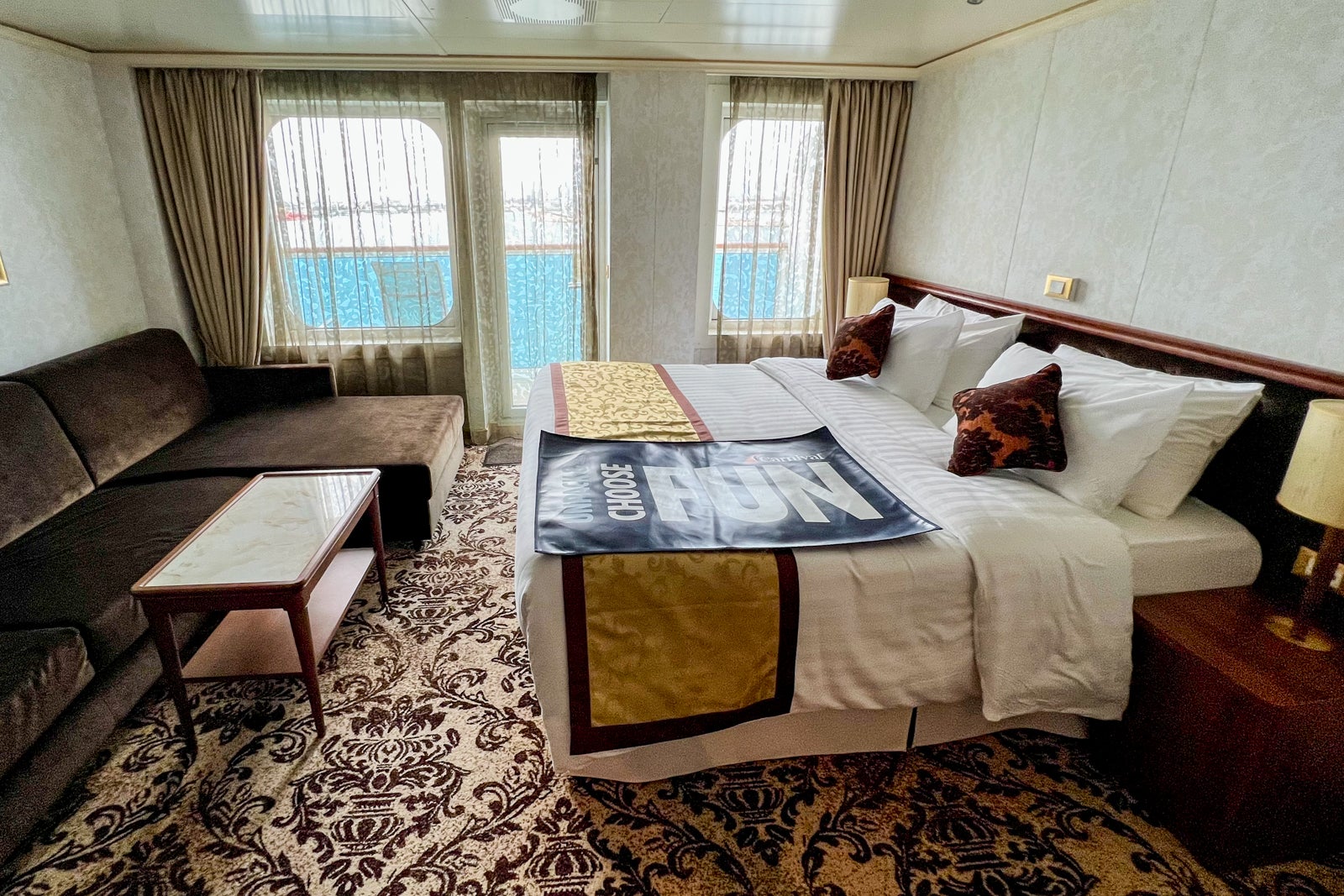
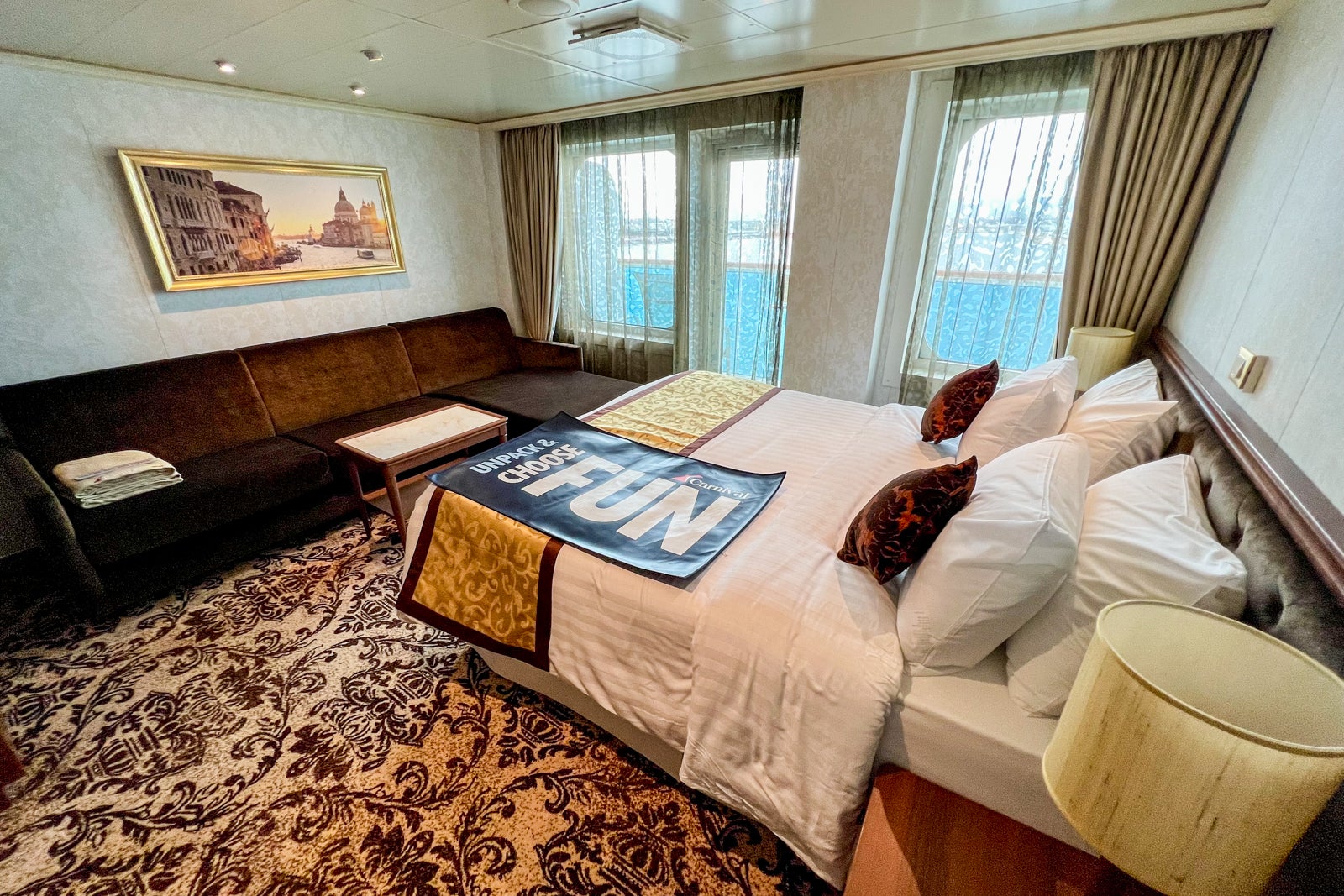
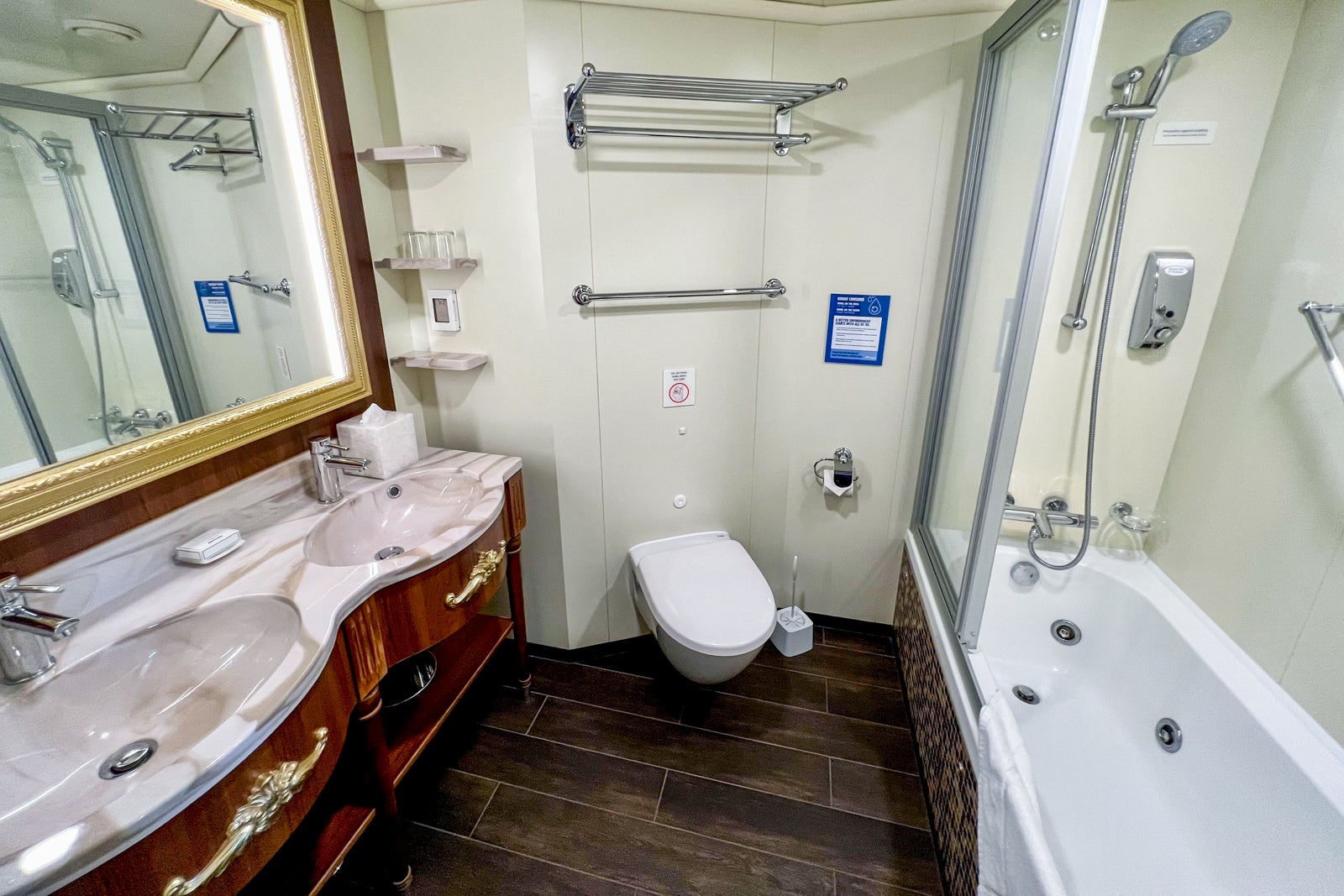
Focused mostly on budget-minded travelers, Carnival has never been known for the wide array of large and pricey suites found on some competing big-ship lines.
Carnival Venezia restaurants and bars
As is typical for Carnival ships, Carnival Venezia is packed with dining options — some included in the fare, some at an extra charge. It’s got oodles of bars, too.
The vessel has two main dining rooms and a casual buffet eatery where meals are included in the fare. In addition, you’ll find several included-in-the-price quick bite options and five extra-charge eateries serving everything from steaks to sushi.
In general, Carnival cuisine isn’t high-end and — given the line’s focus on vacations at an affordable price point — it’s not meant to be. But Carnival is a line that long has underpromised and over-delivered when it comes to its food offerings, and you may be surprised by what you find.
Restaurants
While I only was on Carnival Venezia for five nights, I was able to hit just about every food outlet on board — something that isn’t easy given how many there are. On a typical seven-night cruise, you’ll have enough options to never get bored.
It’s a good idea to make reservations for the ship’s five specialty restaurants as soon as you can, as they tend to fill up quickly.
The biggest eateries on the ship, and the spots where you’ll eat at least a few, if not most, of your dinners, are its two main restaurants, the Canal Grande Restaurant and Marco Polo Restaurant.
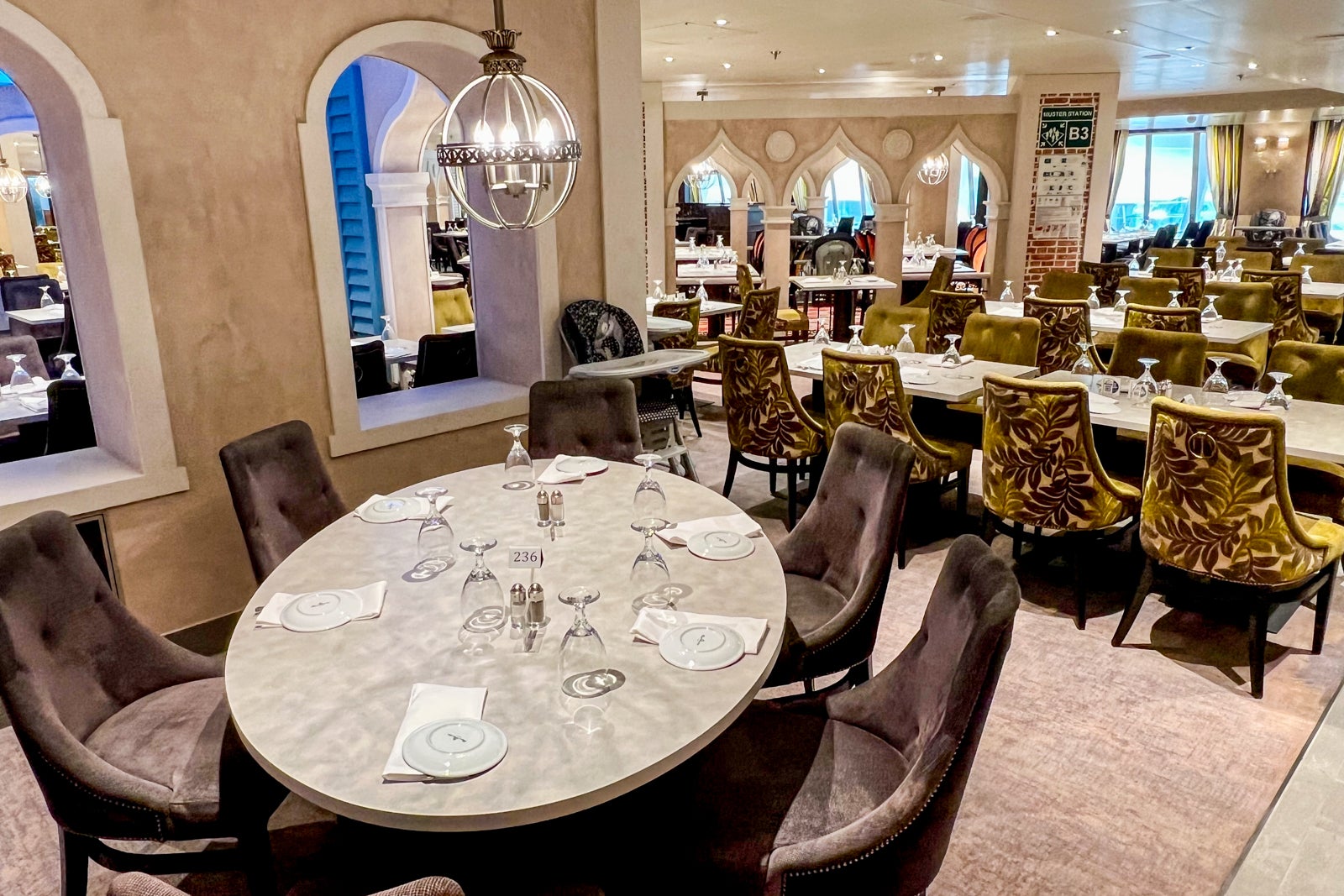
At the back of the vessel and spanning two decks, the Canal Grande Restaurant is the main restaurant for passengers who sign up for Your Time dining — the type of dining where you can show up whenever you want. The smaller Marco Polo Restaurant, at the center of the ship, is reserved for passengers who choose Traditional dining — the type of dining where you sit at a designated table at a fixed time.
As is always the case with Carnival sailings, you choose one or the other type of dining in advance of your cruise, and then you are assigned the appropriate main restaurant. Note that this choice only applies to dinners in these main restaurants. If you want to go to any of the extra-charge eateries, the casual buffet (called Lido Marketplace) or a quick-serve outlet for dinner, you can go whenever you want, no matter whether you’ve chosen Your Time or Traditional dining. Breakfast and lunch are also open seating during listed hours.
The Canal Grande Restaurant and Marco Polo Restaurant serve the same cuisine, but it is the come-anytime Canal Grande Restaurant, where I ate, that has by far the most spectacular setting — spectacular either in a good or a bad way, depending on your take on over-the-top theming.
Designed to appear like its tables are lining a canal in Venice, the soaring, two-deck-high venue has a real Venetian gondola “floating” in a faux waterway down its center, with faux brick bridges over the canal and a faux blue sky above. To which I say: fabulous. I love it. But, also, I’m half Venetian, so I may be wildly biased.
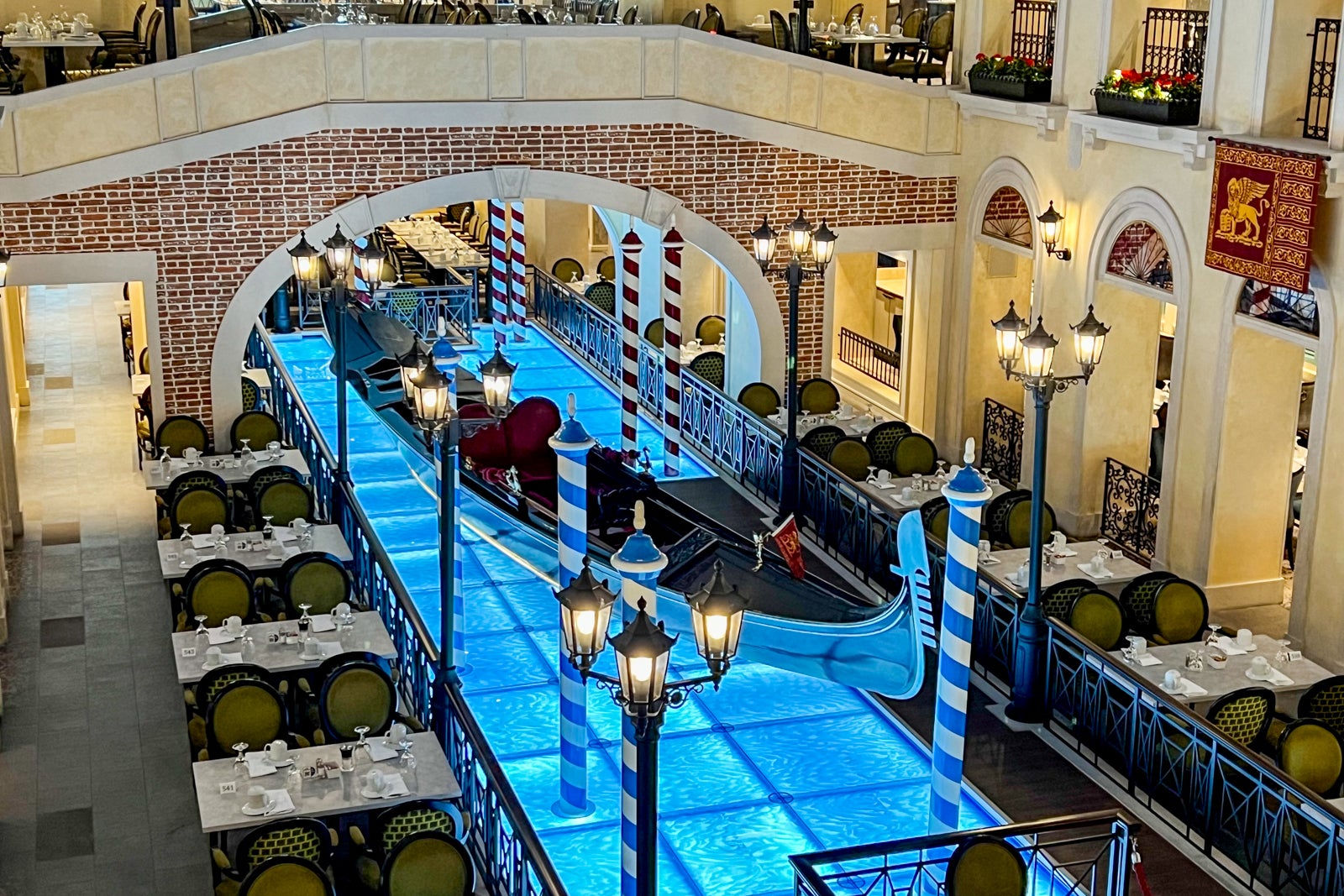
The dinner menu at the Canal Grande Restaurant typically offers six main courses from a dizzying mix of cuisines — on the night I ate there, the choices included an Asian-inspired sweet and sour shrimp dish, an Italian lasagna plate and a vegetarian Indian platter. Several “from the grill” choices, such as grilled salmon or chicken breast, are available every night.
While it was early days for the eatery when I visited, I found the food quality and delivery all over the map. A calamari fritti appetizer I ordered was so depressing in its appearance, chewy and tasteless as to be almost upsetting. However, my main course of grilled salmon came out perfectly soft and seasoned.
One of my tablemates also had the hilarious situation of ordering a burger for his son where he specified no ketchup or mustard, “just cheese,” only to be served a bun with just cheese on it — and no meat. As noted, it’s early days, and the crew still is learning.
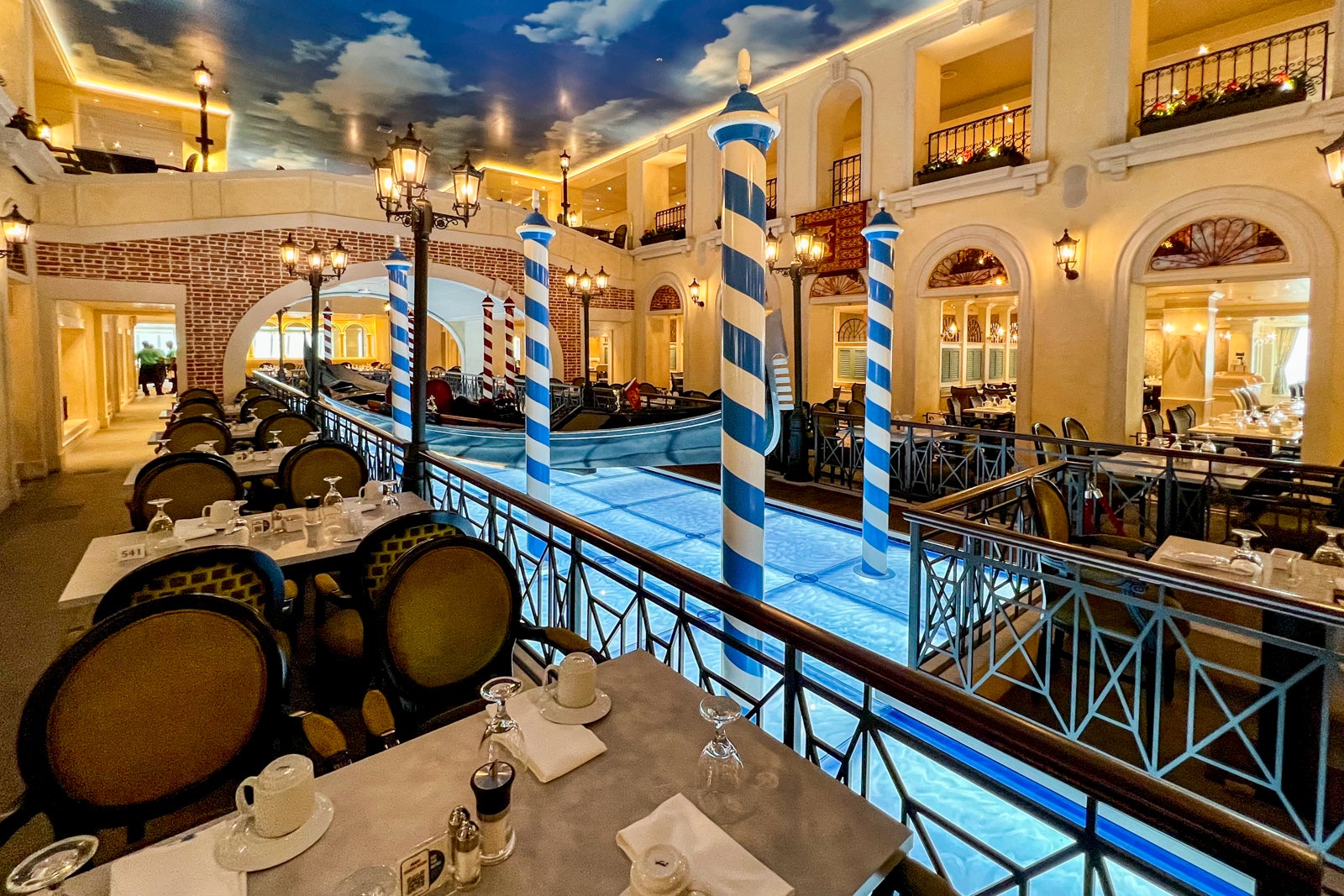
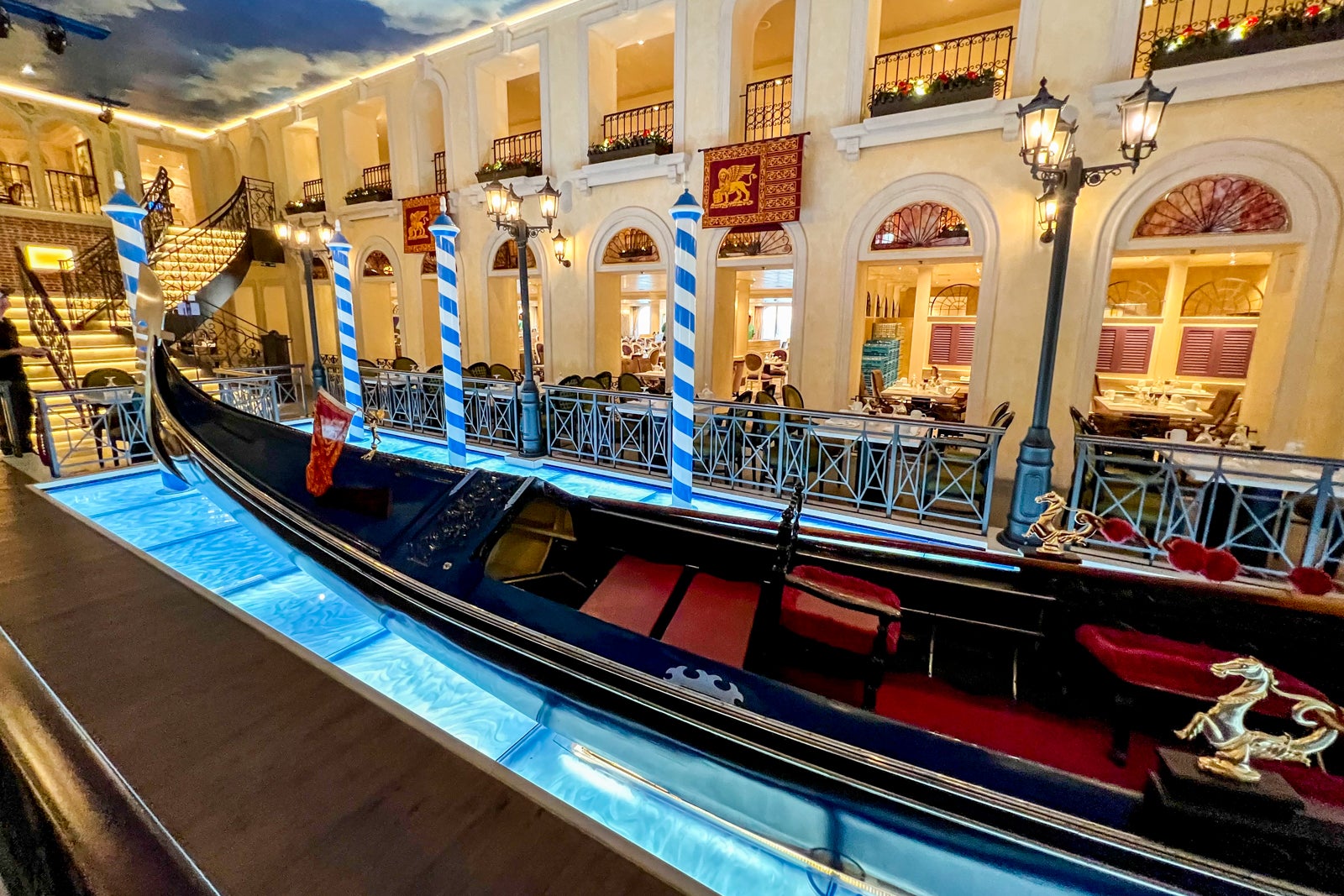
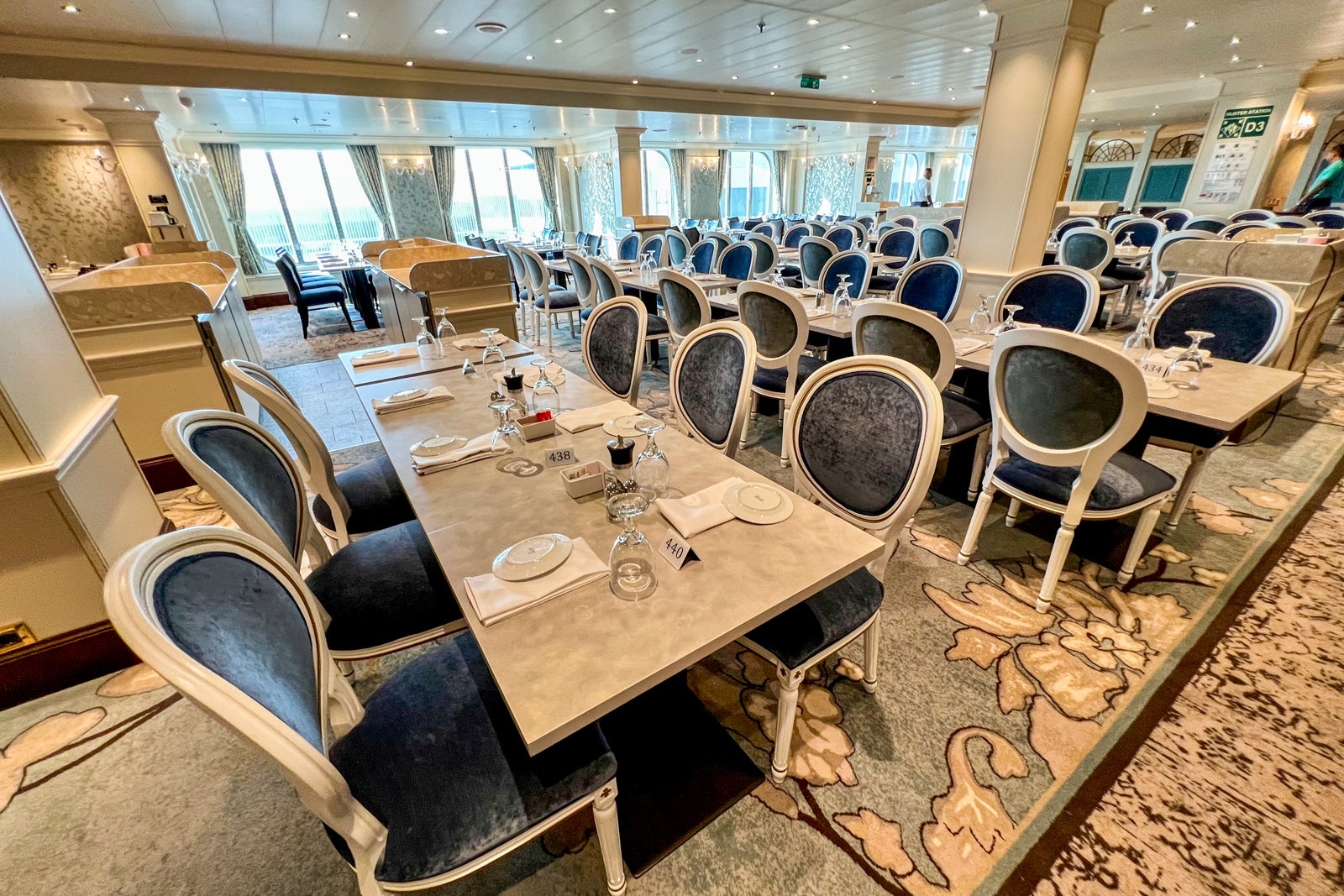
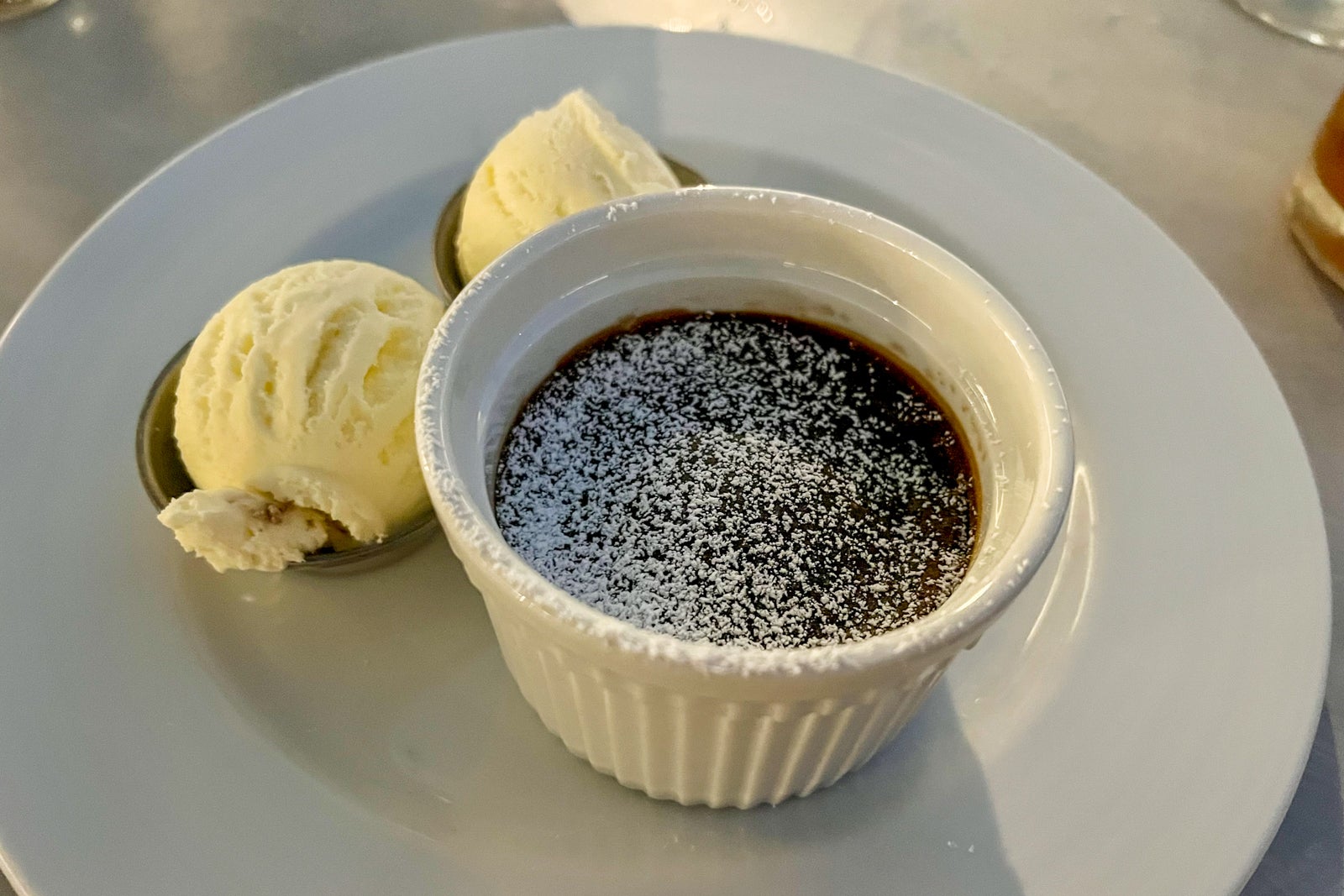

The Lido Marketplace is Carnival Venezia’s included-in-the-fare buffet venue, and it’s always buzzing. Carnival fans love their Lido buffets. The venue is at the top of the ship between the main Lido pool and the back-of-the-ship Burano pool. Its decor evokes an outdoor Italian cafe of the sort you’d find in the square of a small Italian village, with faux trees, leaf-lined columns and casual cafe chairs.
At breakfast, the Lido Marketplace offers up all the staples in big trays along the buffet line, including scrambled eggs, eggs Benedict, hard-boiled eggs, pancakes, sausage and bacon. There are made-to-order omelet stations, too. Lunchtime brings a wide variety of options, including a salad bar and a hot sandwich grill turning out grilled ham and cheese sandwiches, Reubens, meatball subs and the like.
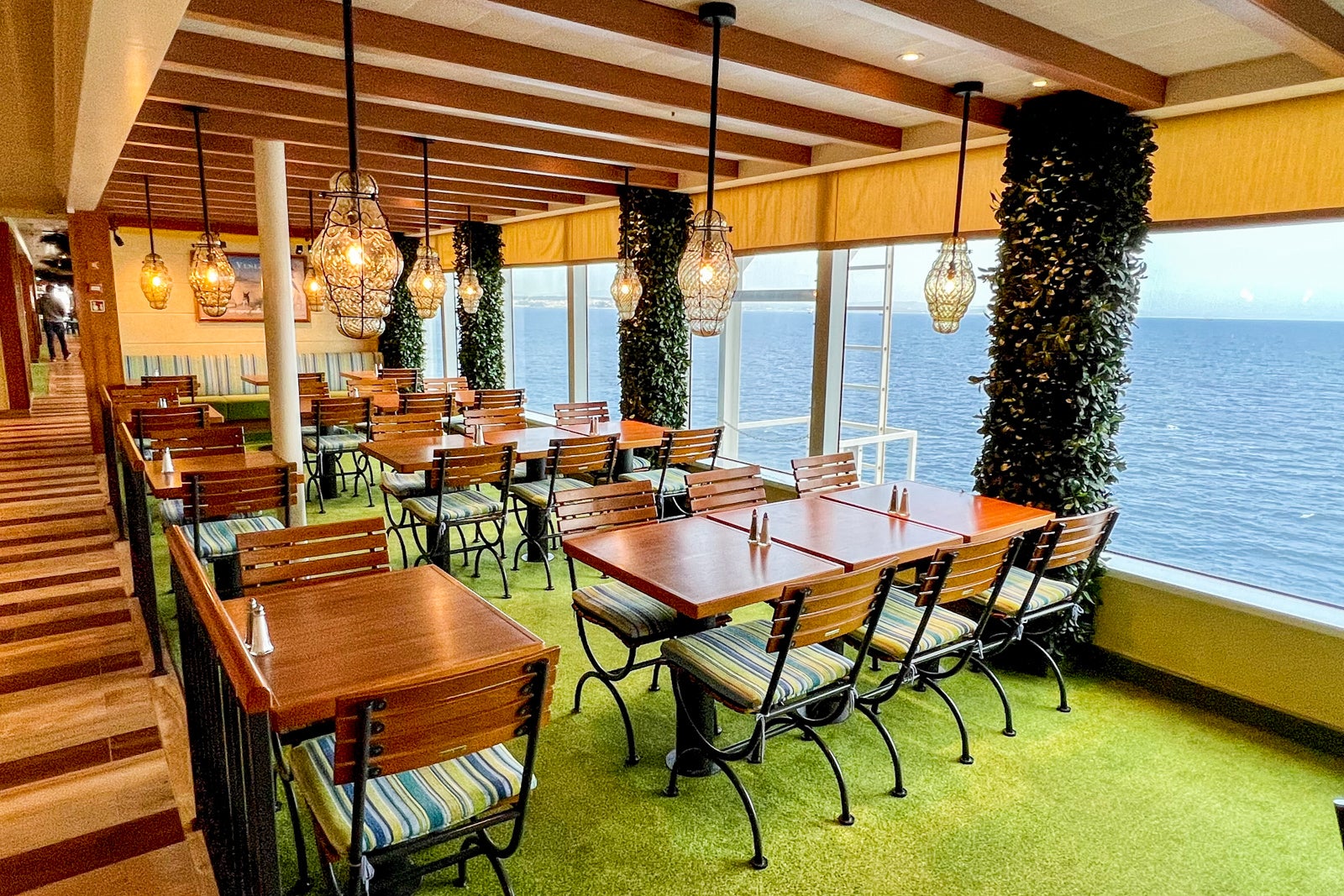
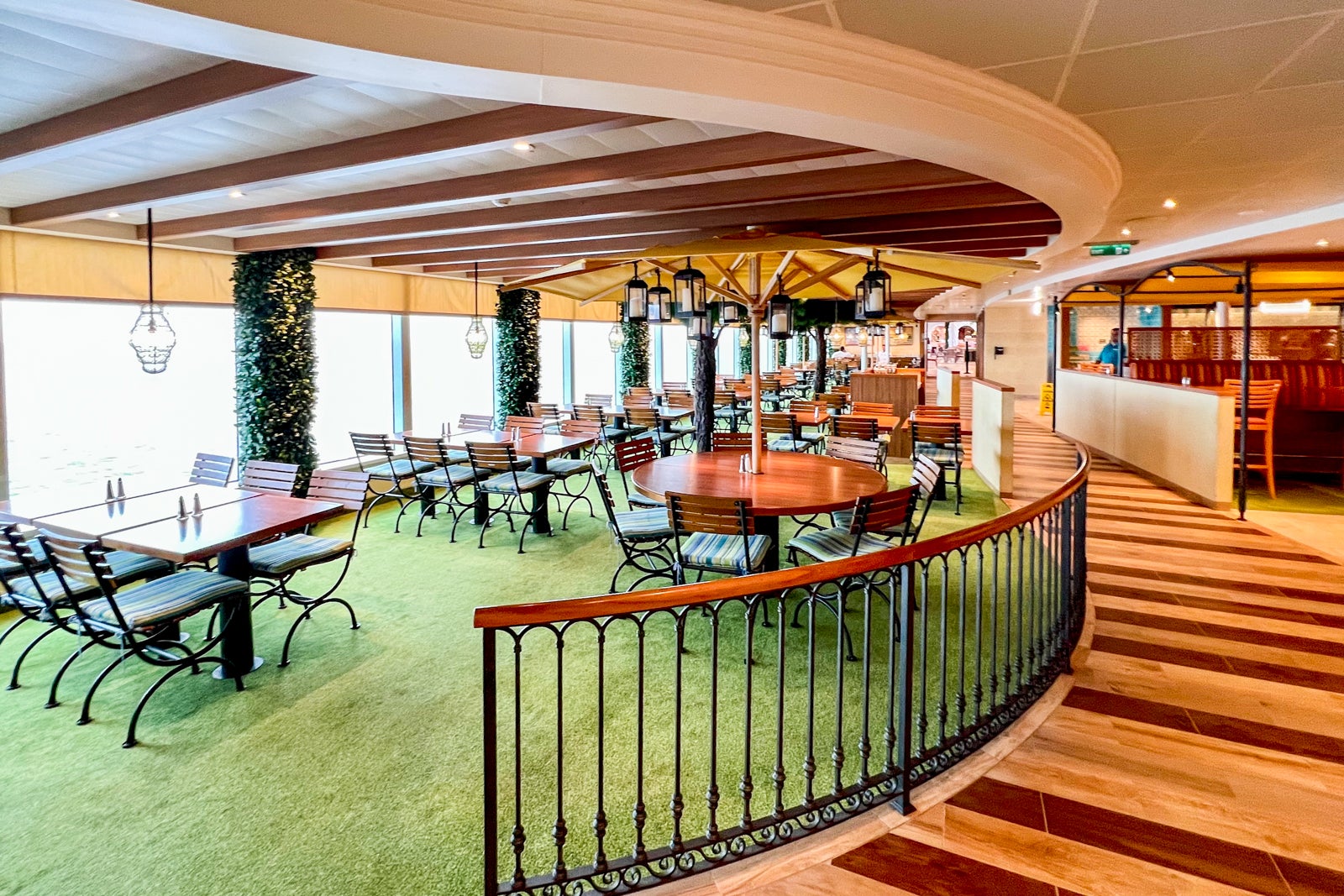
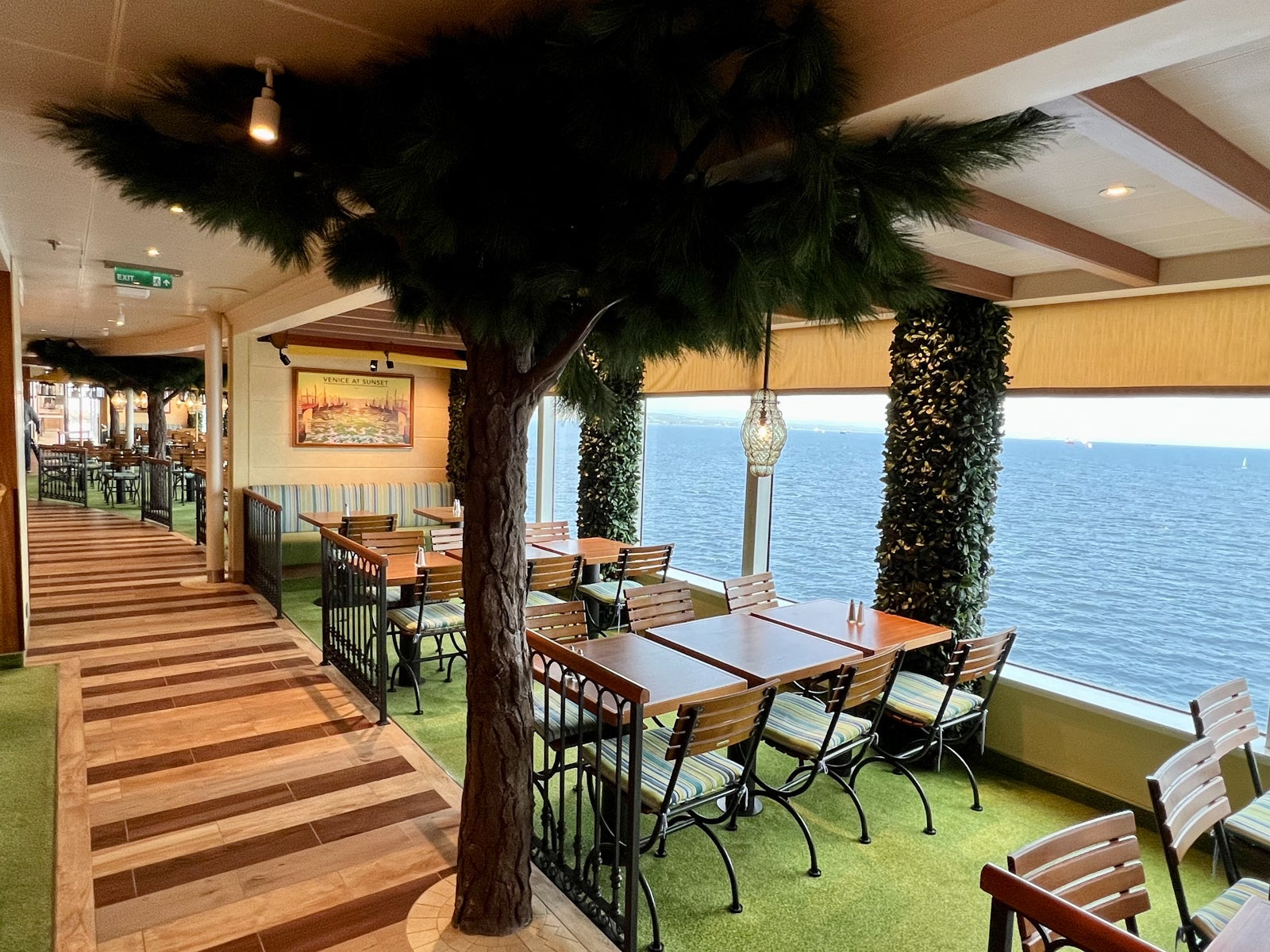
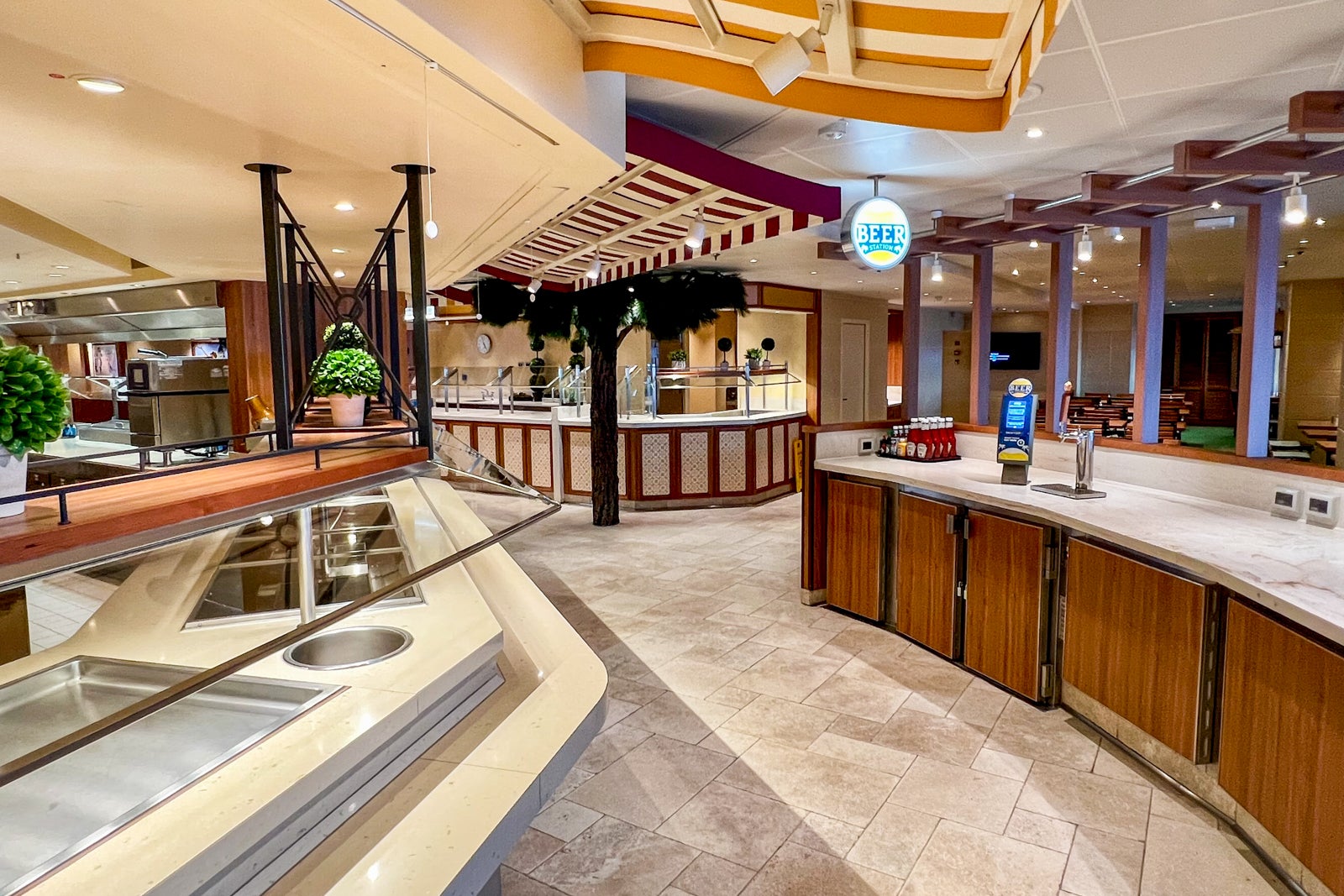
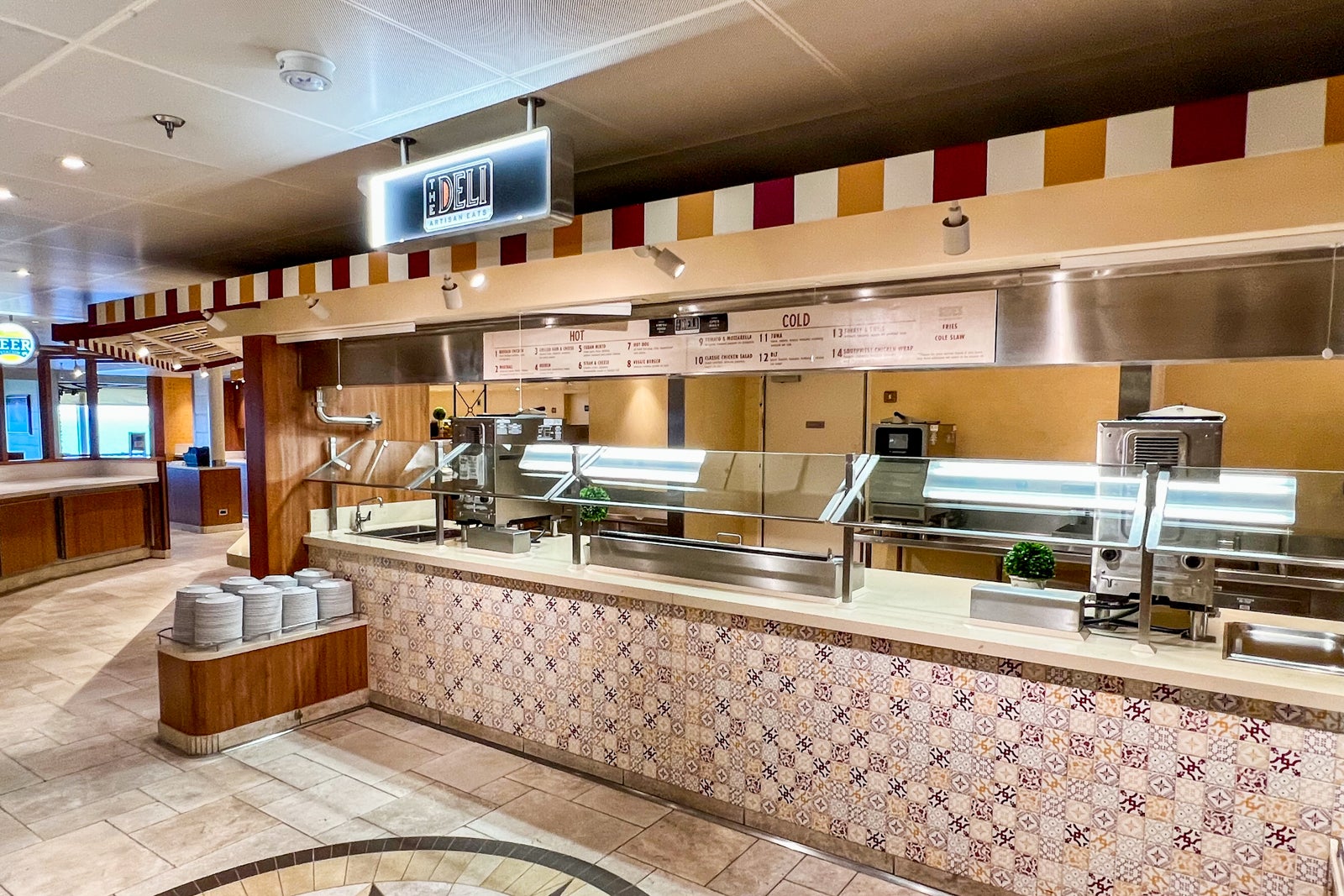
Just outside the Lido Marketplace at the back of the ship and steps away from the Burano pool is the ship’s pizza-to-go outlet, Pizzeria del Capitano, serving up five pizza options: Margherita, fungi, pepperoni, quattro formaggi and prosciutto. You can order a slice or whole pie at no charge. Covered outdoor seating is available.
A second quick-serve outlet around the Burano pool, the Seafood Shack, serves lobster rolls, fish and chips, New England clam chowder and other classic seafood items for extra charges that seem out of whack with what the typical Carnival customer can afford. The lobster roll, for instance, is $18, and a single crab cake is $15 — prices that seem awfully steep.
On the flip side, an order of fish and chips is only $8, as is a bucket of fried clam strips, which seems more reasonable. Either way, I didn’t see many people lining up for items here.
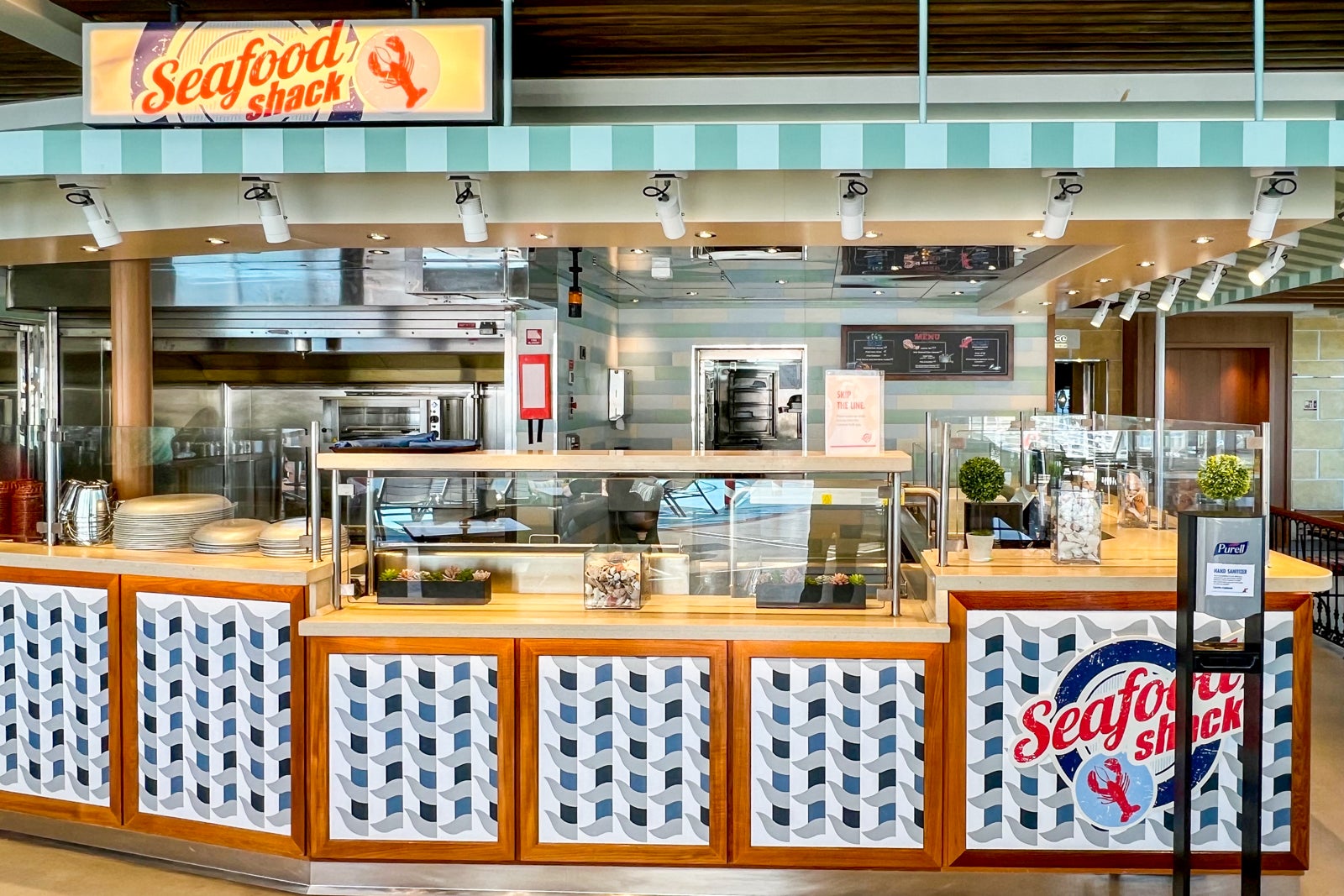
Moving forward to the Lido pool area on the same deck, you’ll find two included-in-your-fare, iconic Carnival quick-service outlets. The most jammed, at any time its open, is Guy’s Burger Joint, the Guy Fieri-created burger outlet that you’ll find on every Carnival ship.
On Carnival Venezia, this eatery has an unusual Italian theme, with the fat-dripping, mouth-watering burgers for which it is known coming in two new Italian-inspired, Guy Fieri-created versions in addition to the classic options. These include a “pepperoni pizza burger” topped with fried mozzarella, pepperoni, marinara, provolone and aged Parmesan and a “super melty mootz” that is slathered in melted mozzarella, diced tomato, balsamic and fried basil. (Mootz, for those of you not in the know, is a slang term sometimes used for mozzarella.)
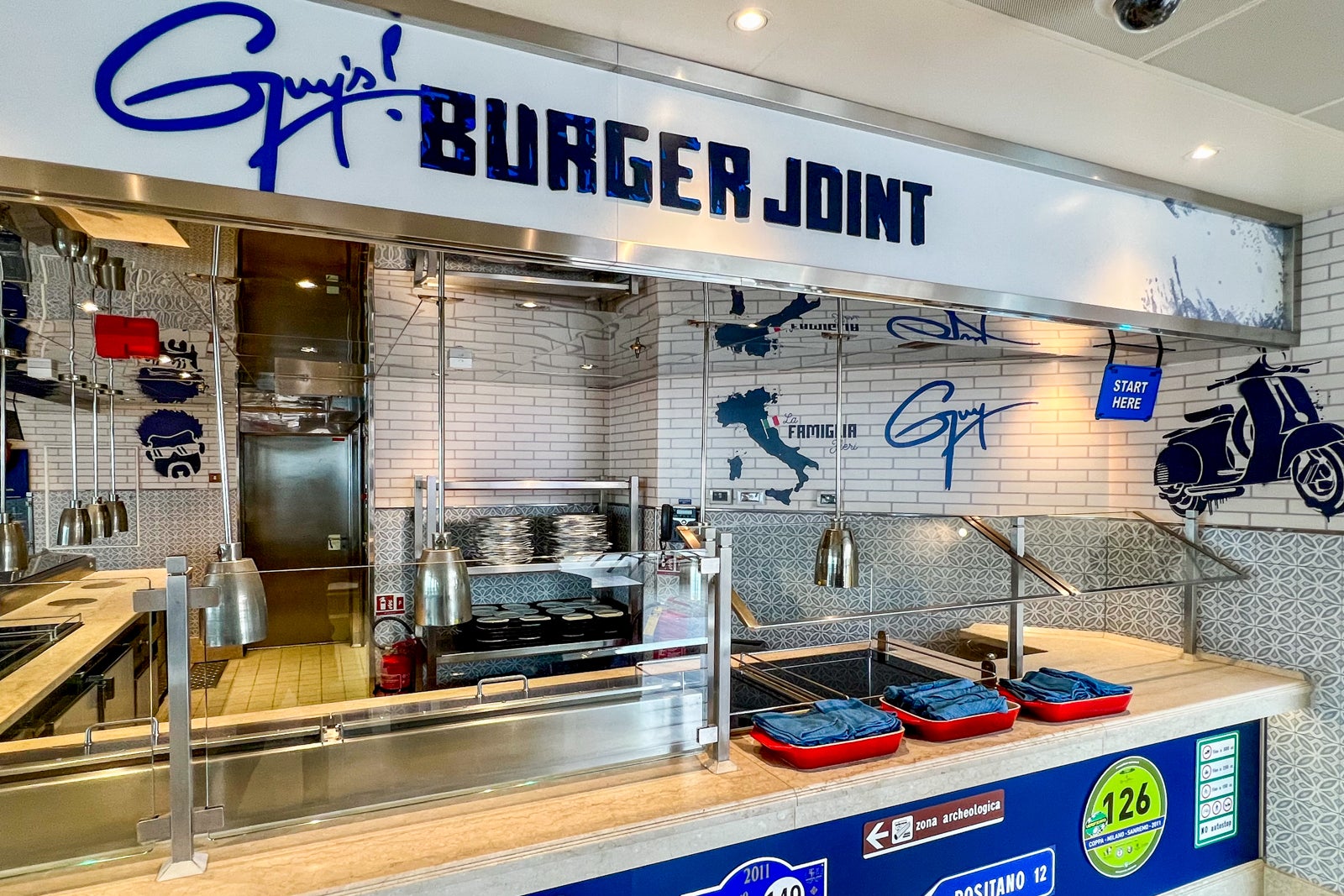
Don’t worry; the classic Plain Jane, Straight Up and The Ringer burgers Fieri created for the wider fleet are also available.
Across from Guy’s Burger Joint, the BlueIguana Cantina burrito outlet found in this location on other Carnival ships has been given an Italian twist, too. Renamed Tomodoro, it now serves Italian meatball subs, Sicilian chicken wraps and tortas de Milanese (imagine chicken Milanese turned into a panini) to go — in addition to made-to-order Mexican-style burritos and tacos.
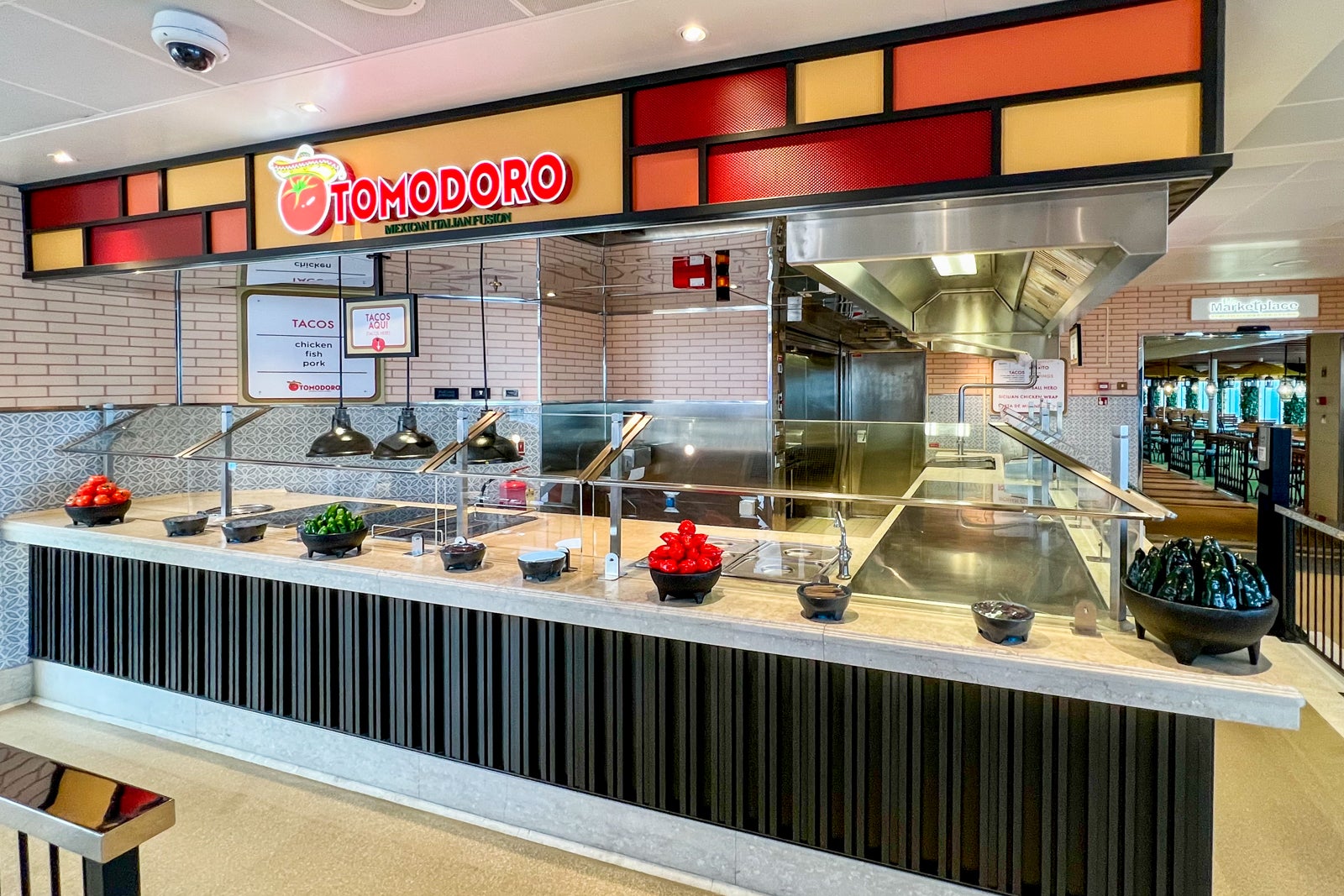
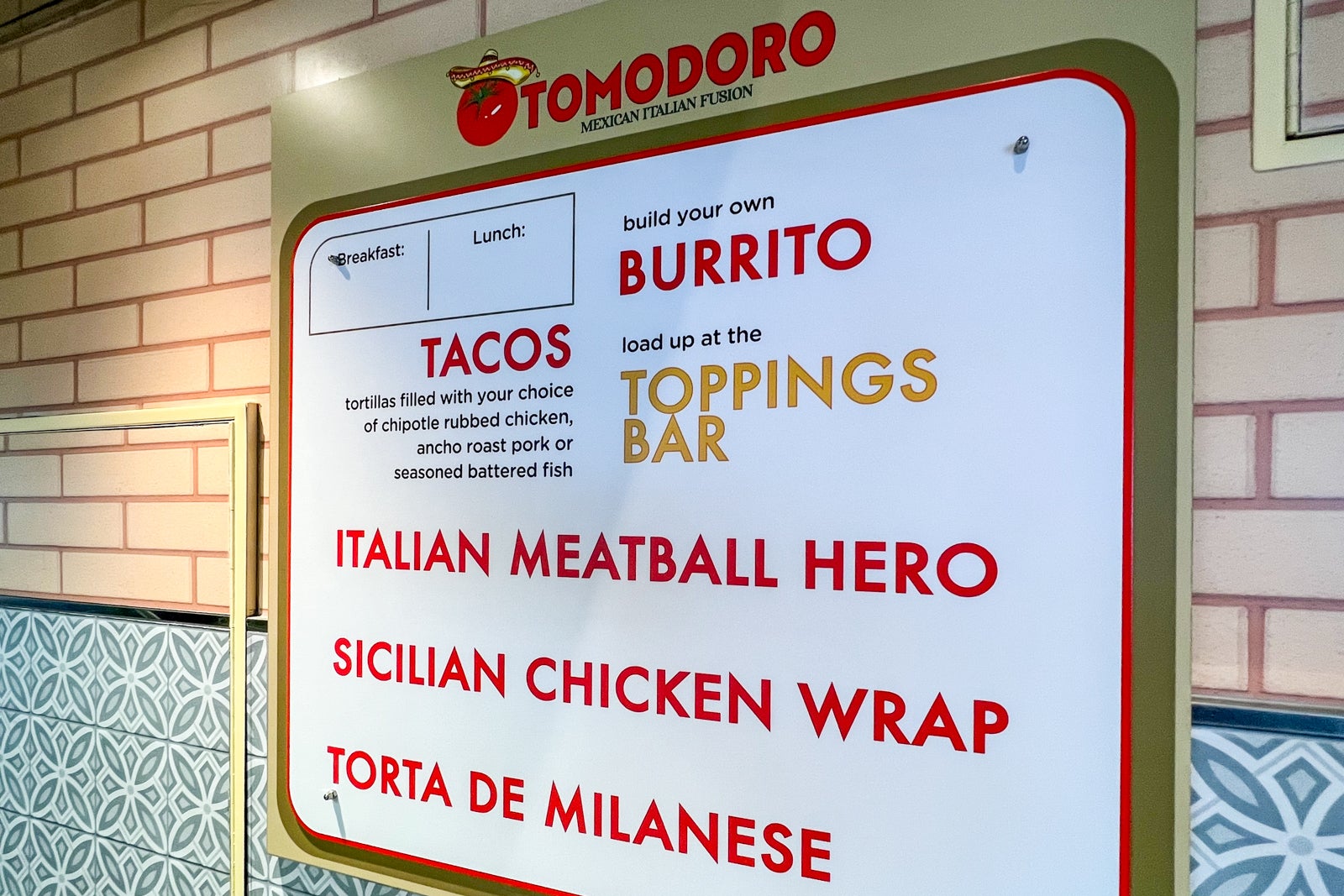
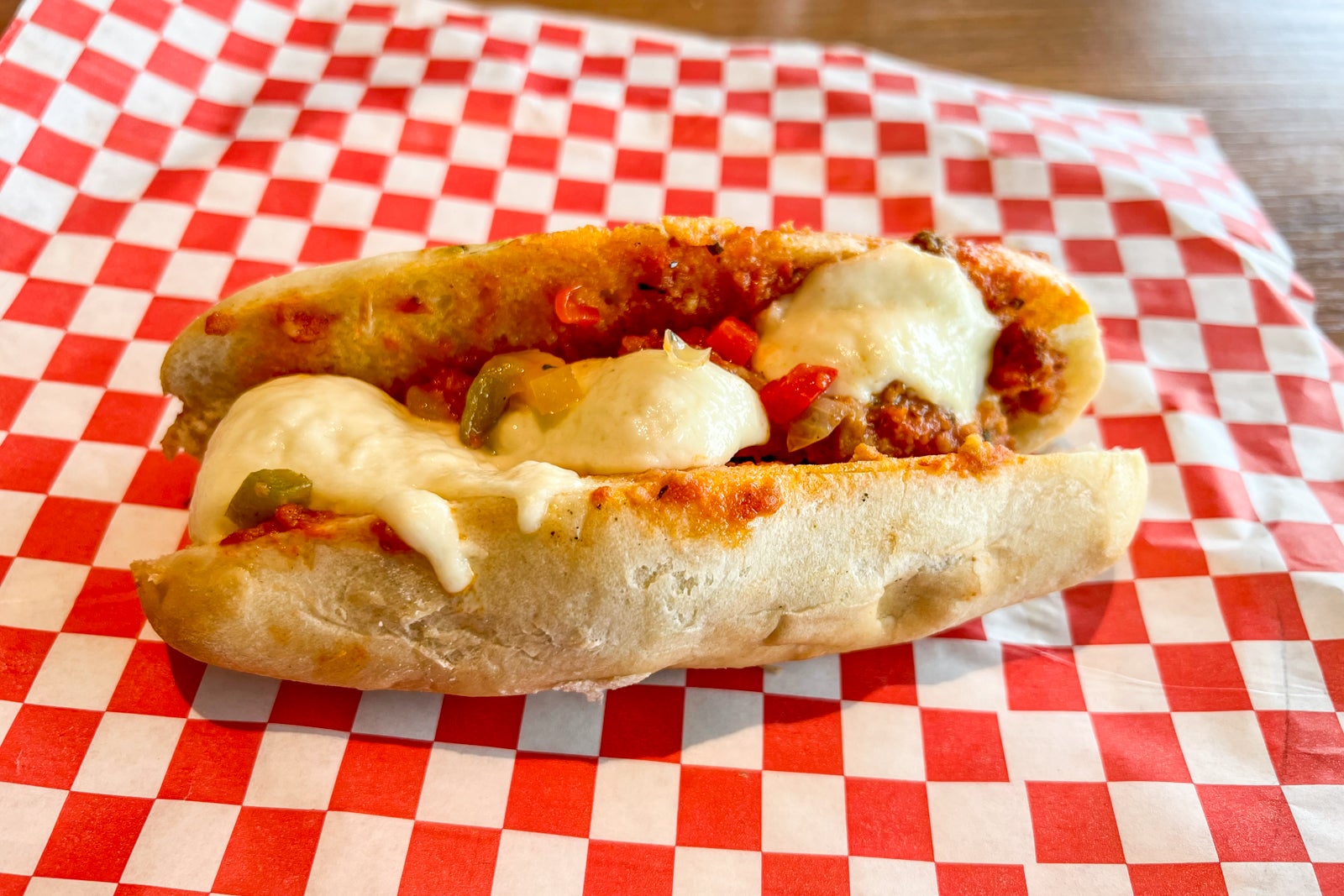
We like it all, but for an outlet this small, the mash-up of Mexican and Italian quick-serve items adds an extra element of choice for customers that can slow down the line. Our advice to Carnival: Go Italian or go Mexican here, but don’t try to do both.
The new entrant to Carnival’s food scene is Il Viaggio, serving high-end Italian cuisine. With a fixed price of $42 per person, it’s one of the priciest eateries on the ship. The restaurant leans into the Italian theming of the vessel with a relatively small, curated menu of Italian specialties such as Tuscan-style sea bass with a Parmesan crust and steak pizzaiola from the Lazio region.
Taking the place of the more casual (and far less pricey) Cucina del Capitano Italian eatery found on other Carnival ships, it served dishes in a hit-or-miss fashion when I visited. To be fair, it was the venue’s first night in operation. I was served a mouth-wateringly soft house-made burrata with heirloom tomatoes and pesto as an appetizer, but a grilled octopus appetizer that looked absolutely beautiful on presentation was sadly under-seasoned to the point of having almost no taste.
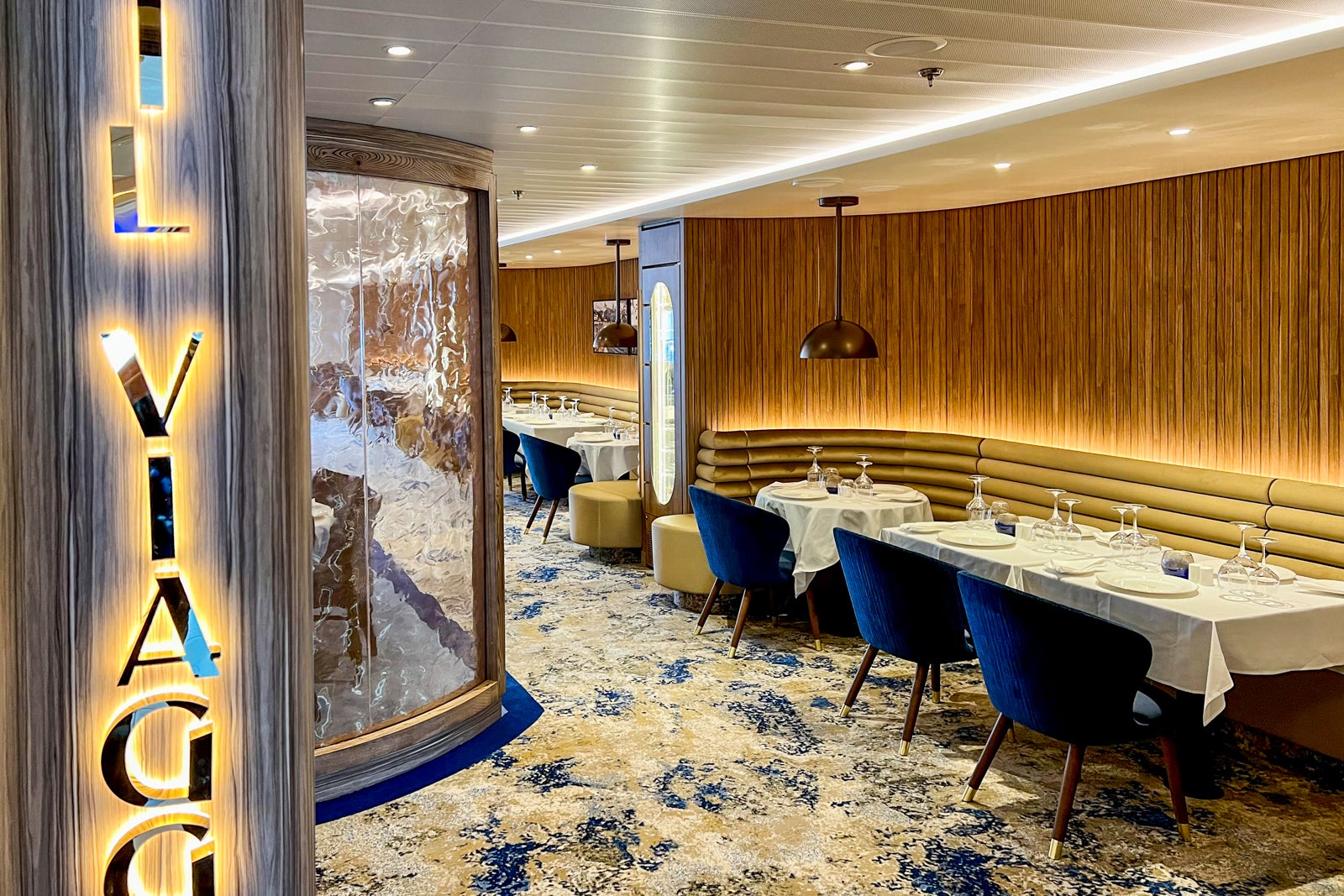
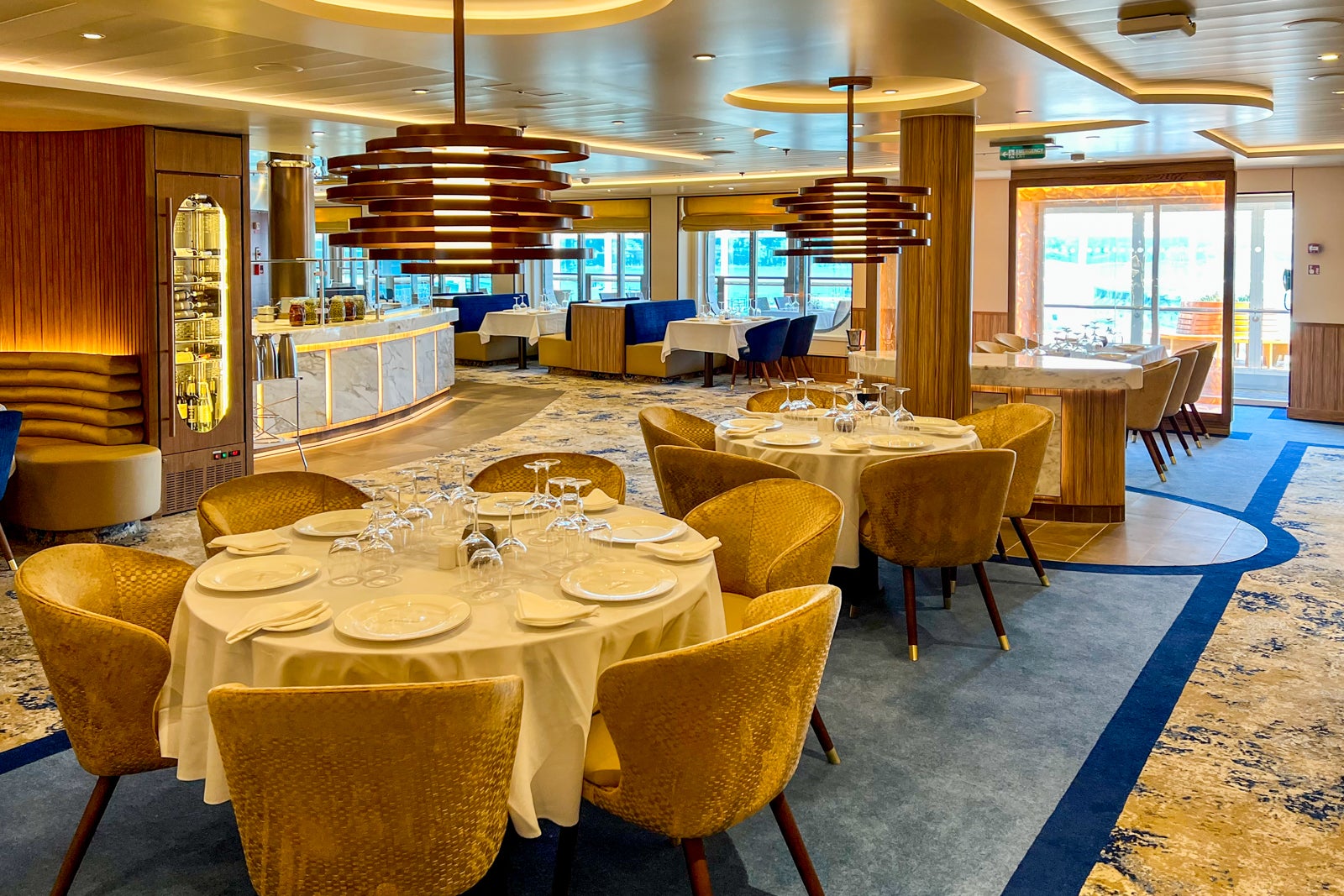

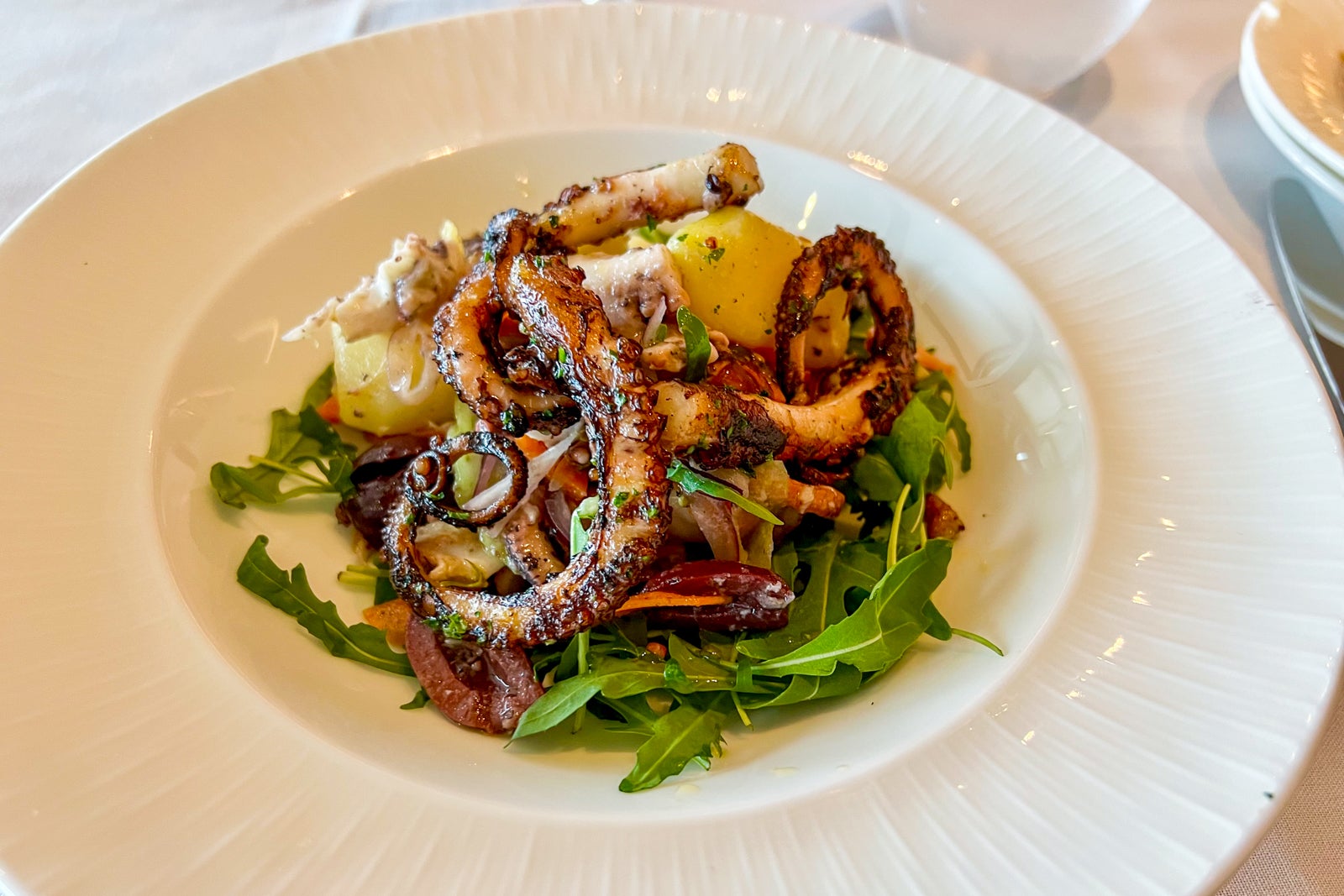
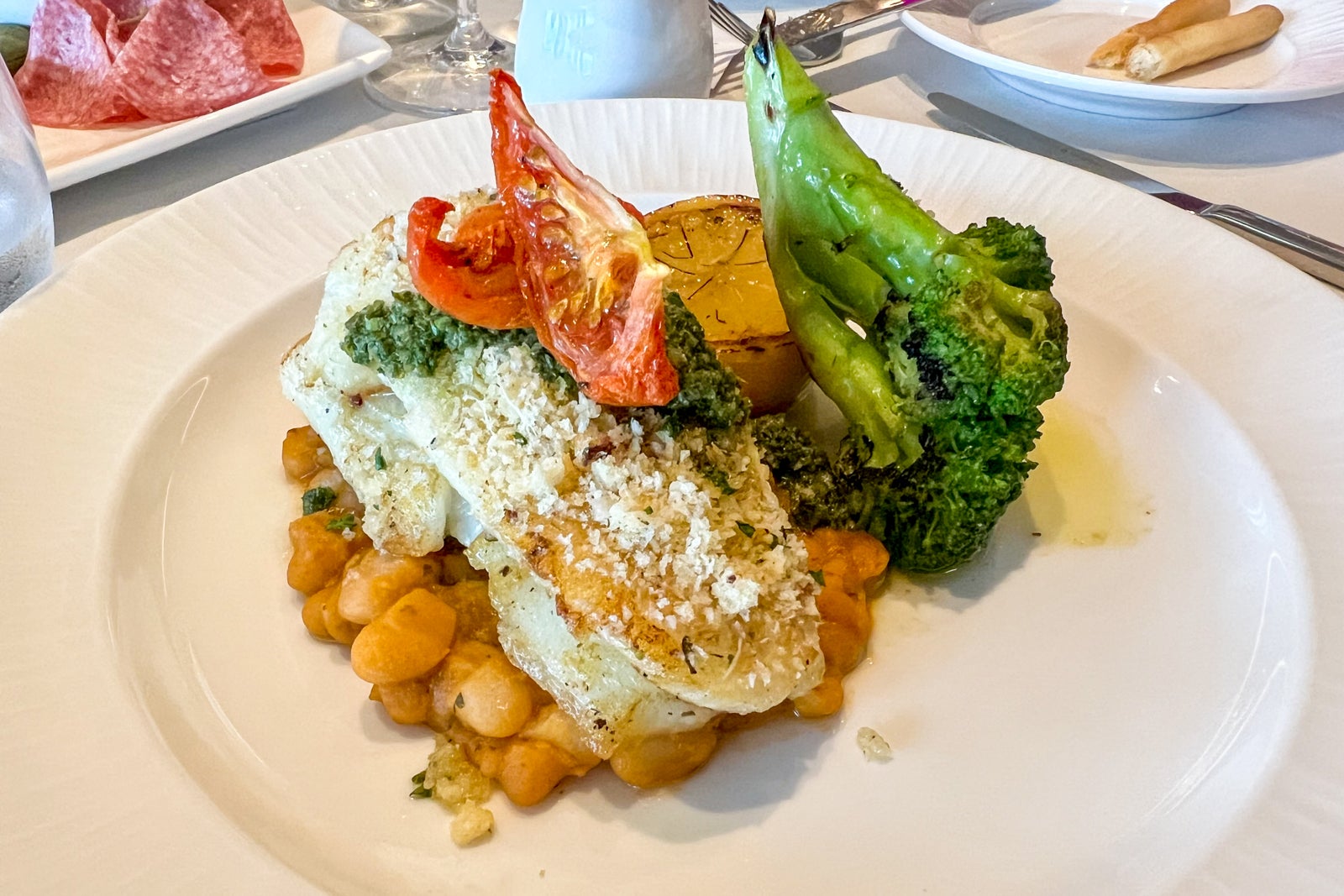
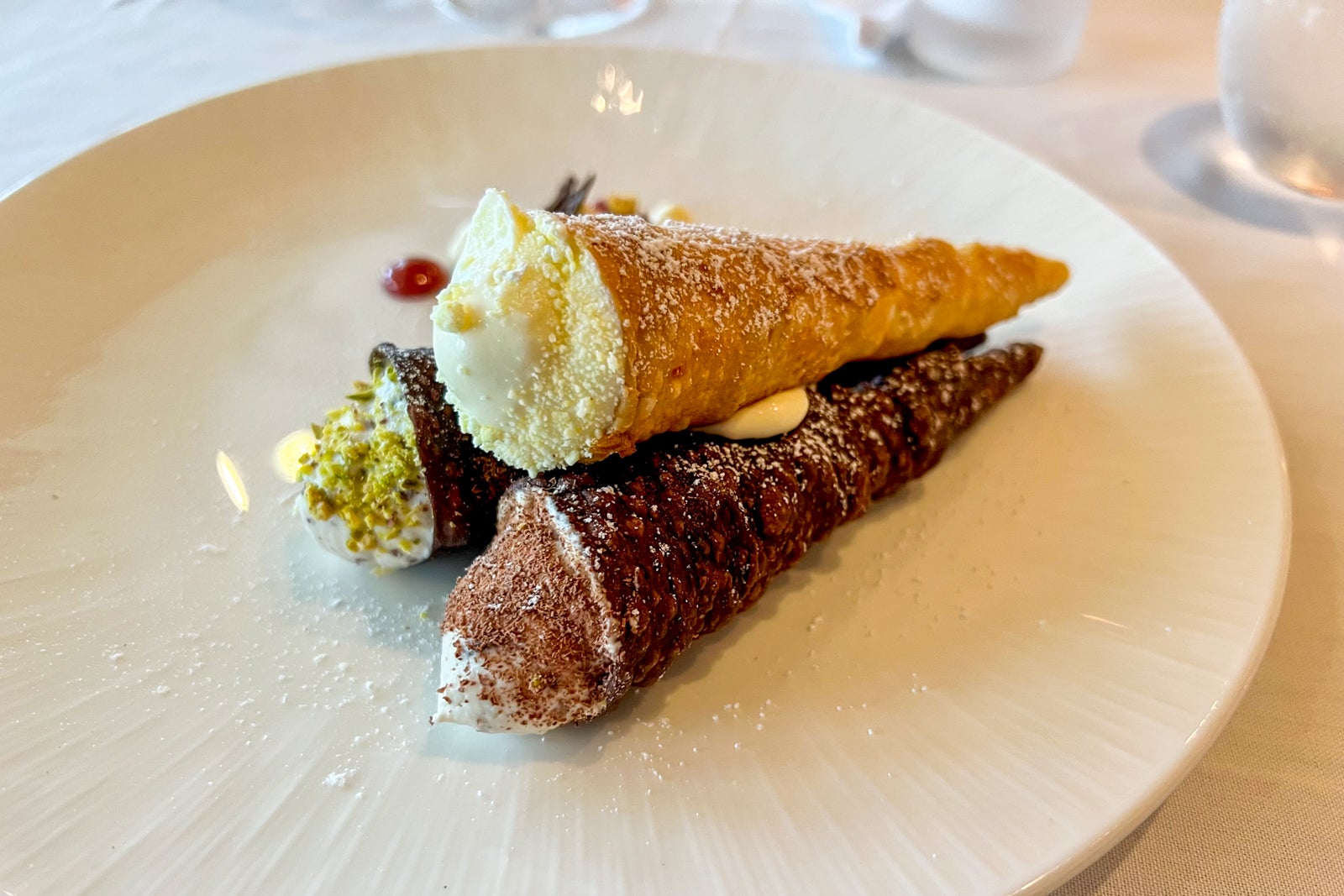
On the positive side, Il Viaggio turned out a pappardelle with pork ragu as a main course that would have impressed even my Italian grandmother. Alas, my go-to test item for a quality Italian eatery, the cannoli dessert, came out with both shells and fillings that were uninspiring. To paraphrase the Peter Clemenza line from The Godfather, take the pappardelle, leave the cannoli.
Carnival Venezia’s priciest eatery is its $48-per-person steakhouse, Fahrenheit 555 —a staple of nearly every Carnival ship. It offers all the steakhouse classics such as New York strip, filet mignon and lobster tail served in a warm and cozy space that retains much of its original Italian theming. Note the golden lion of St. Mark (the symbol of Venice) woven into the carpeting’s repeating pattern and a larger lion of St. Mark statue in one corner of the eatery.
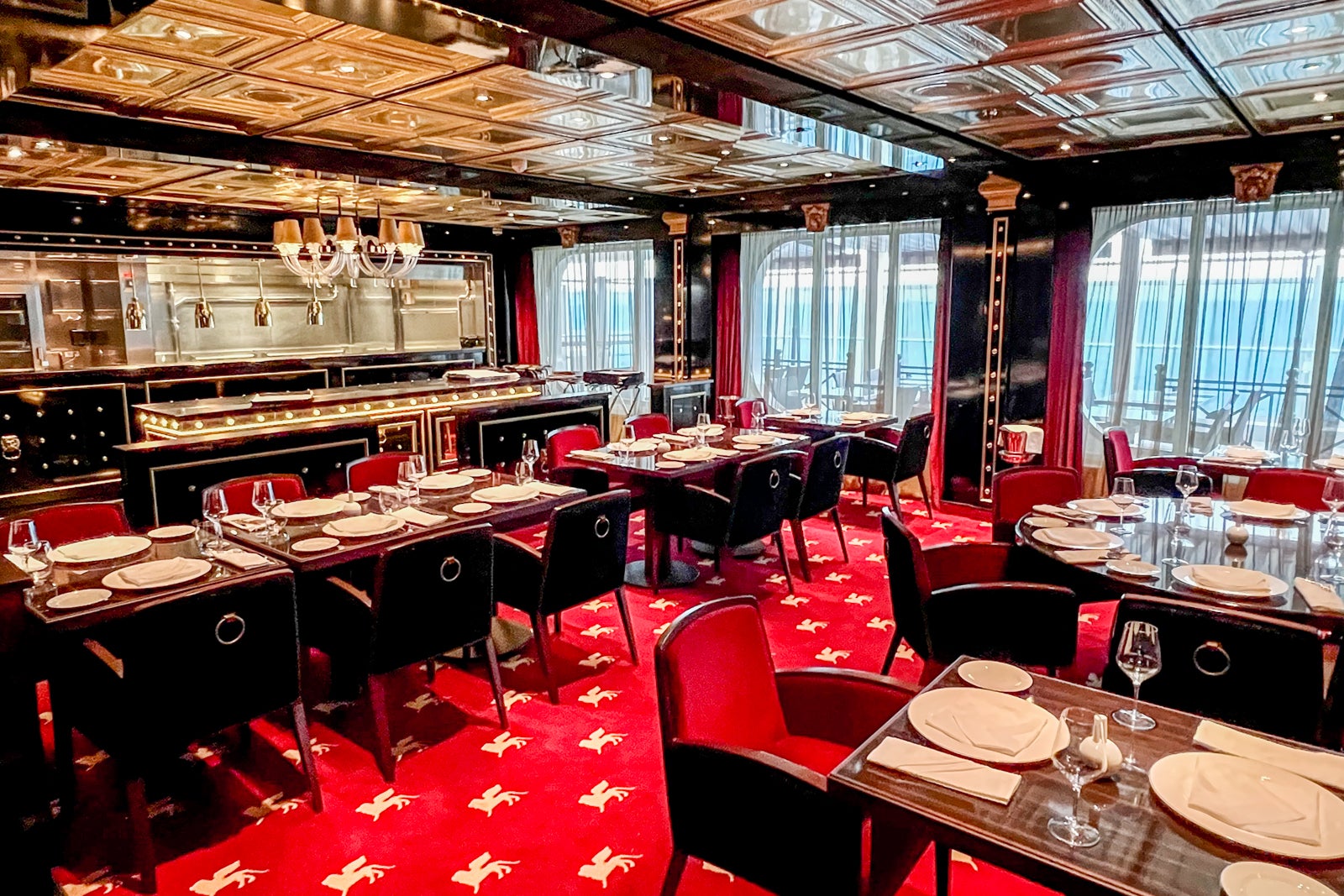
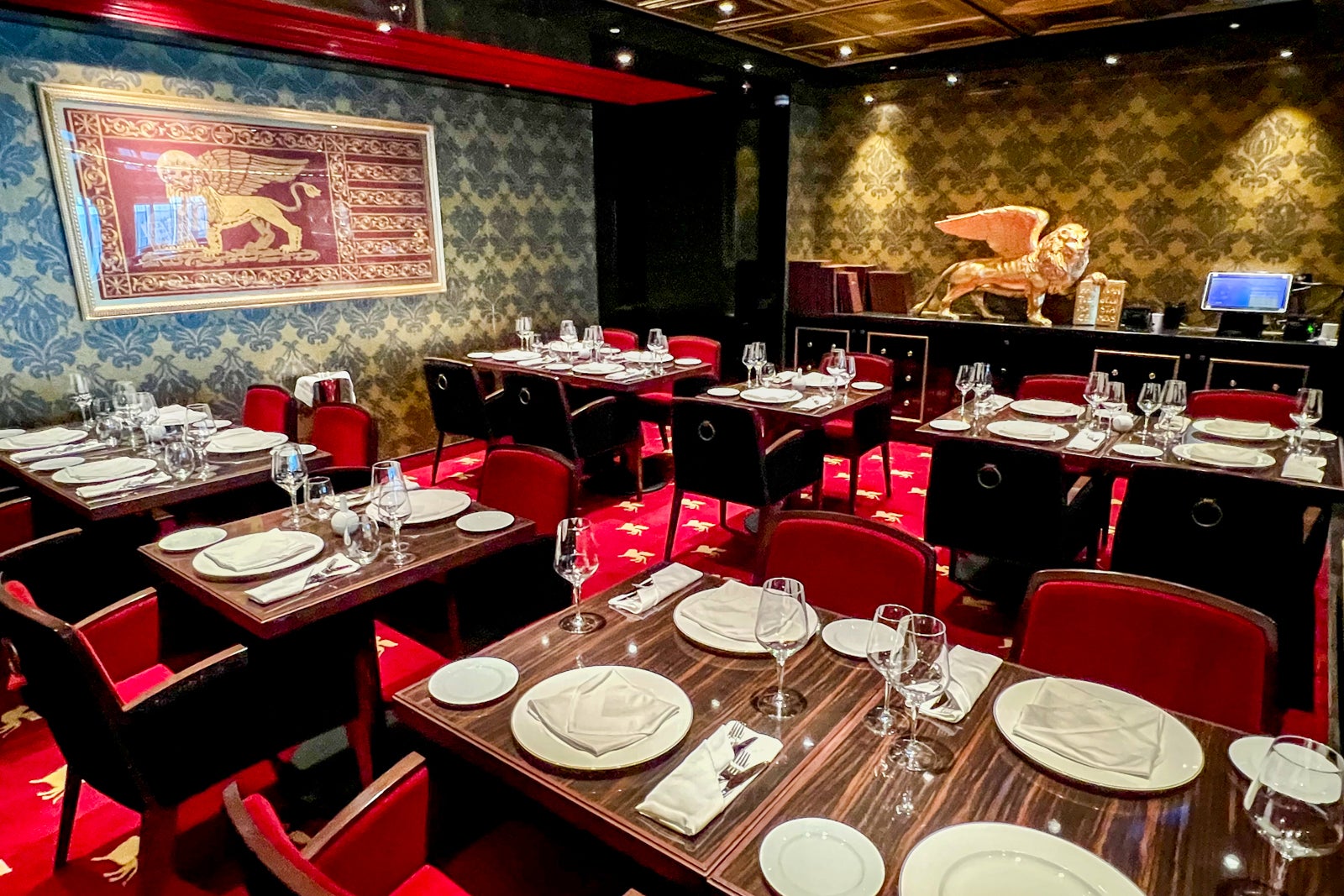
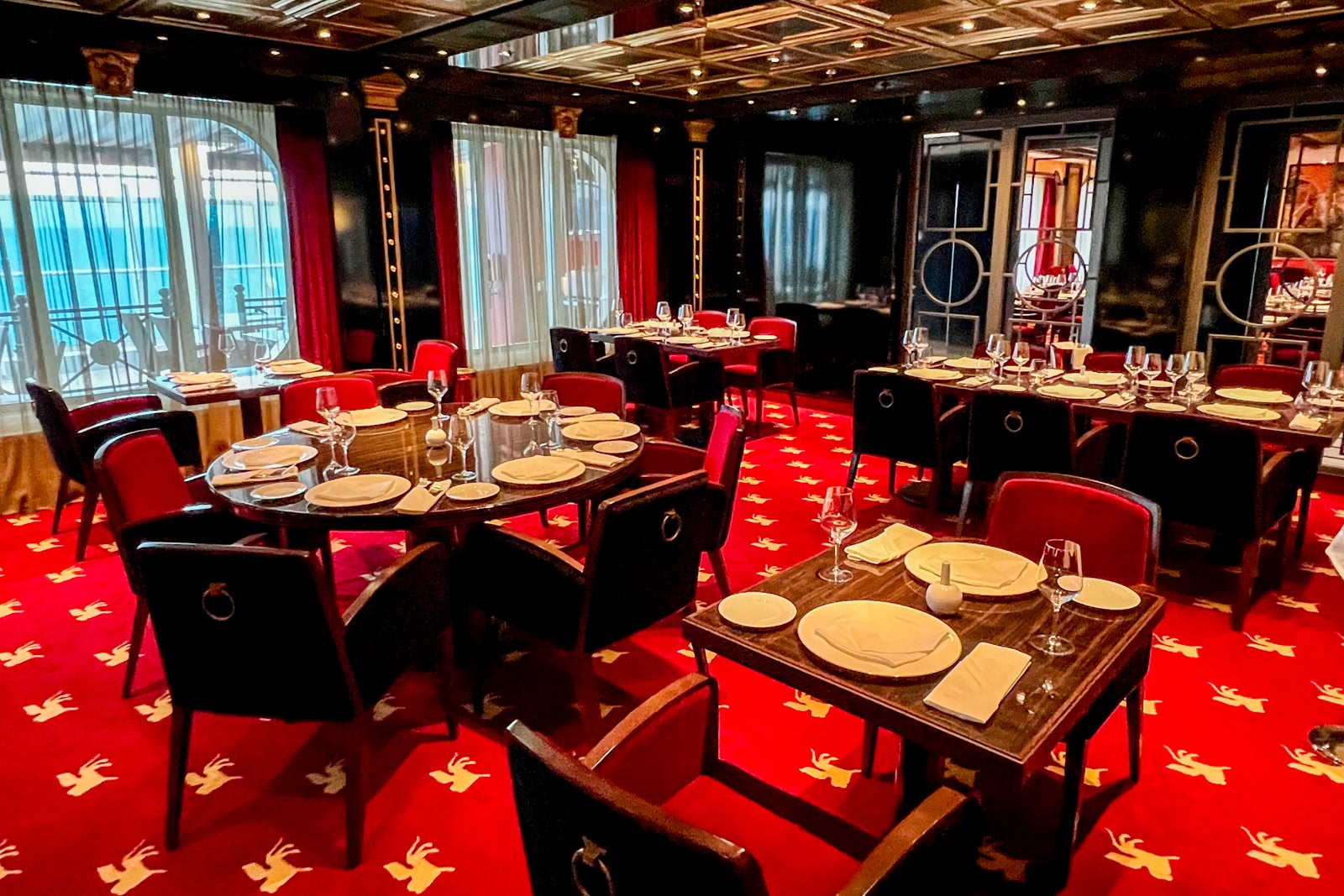
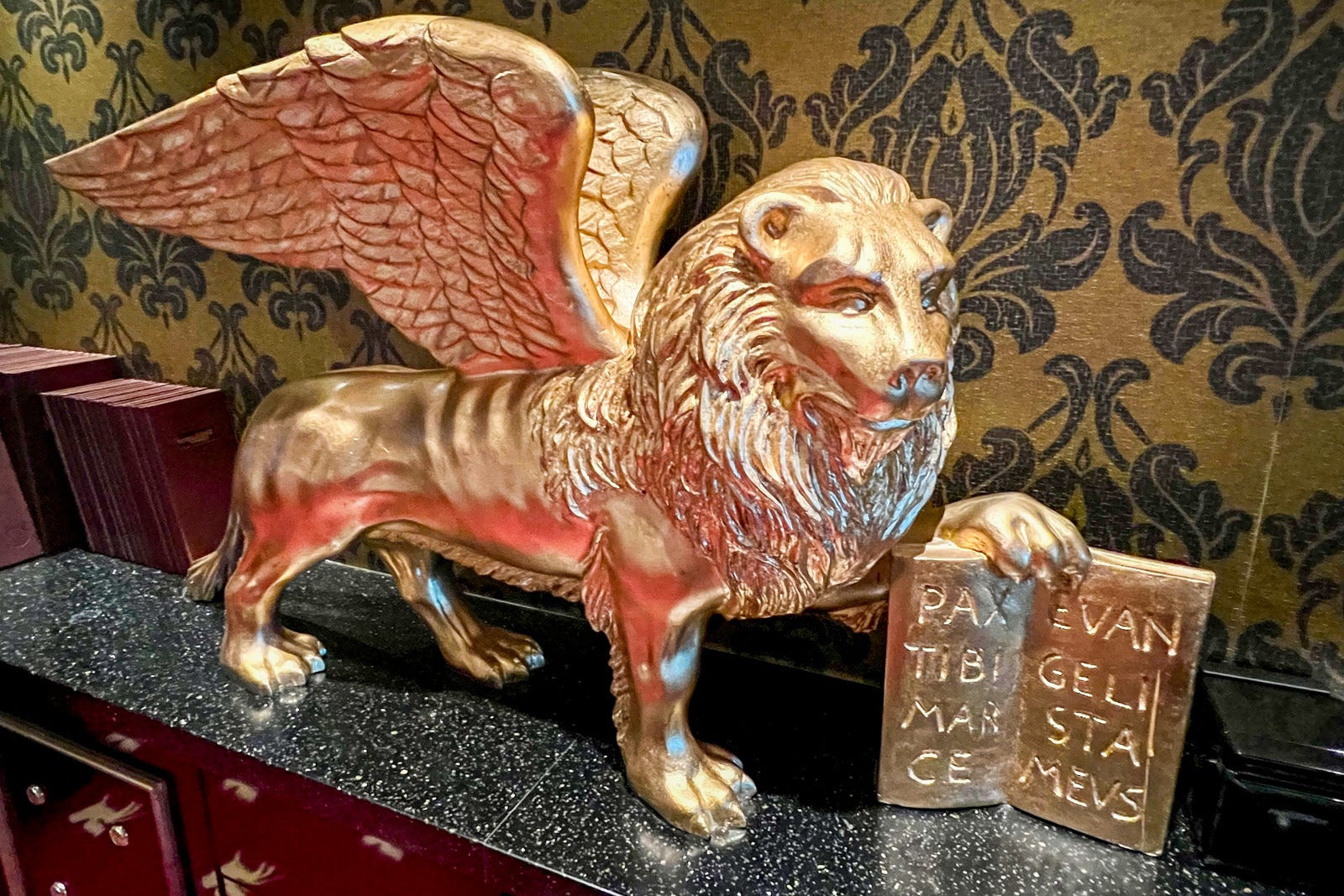
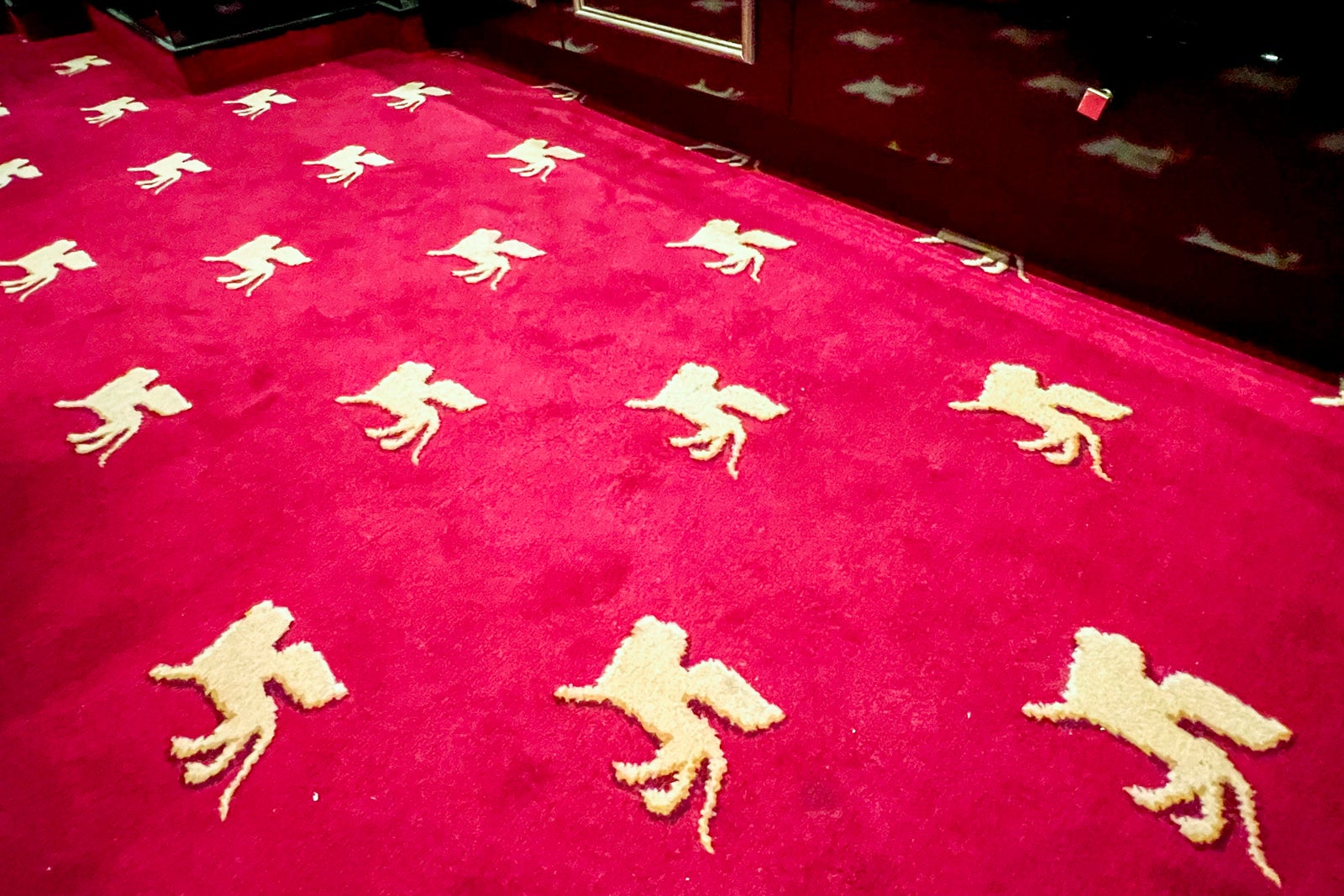
Carnival Venezia trivia: While often Italy themed, all the restaurants on the ship originally were designed to serve Chinese cuisine, in keeping with its original focus on the China market. If you look closely, you’ll see traditional China motifs worked into the Italian theming, as well as heavy use of the popular-in-China color red (which, by luck, also is a color often found in Italian design — it’s on the Italian flag, after all).
The other two major extra-charge eateries on Carnival Venezia are the twin Asia outlets Bonsai Sushi and Bonsai Teppanyaki, just across from each other on Deck 5.
Bonsai Sushi serves its namesake sushi and sashimi, as well as yakitori (grilled meat on skewers), noodle bowls and small plates of such Japanese classics as chicken Katsu and shrimp tempura — all at a la carte prices.
Found on many Carnival ships, Bonsai Sushi has always been one of my favorite Carnival eateries due to a combination of it getting the basics right when it comes to Japanese cuisine (the sushi always is fresh and tasty) and also being relatively reasonably priced. You’ll pay $2 per piece for sushi or sashimi (it’s a limited menu of shrimp, salmon, yellowfin tuna and amberjack) or $6 to $8 for a sushi roll that is downright huge. Poke bowls, shrimp tempura plates and noodle bowls are also available for just $8. It’s hard to run up too big a bill.
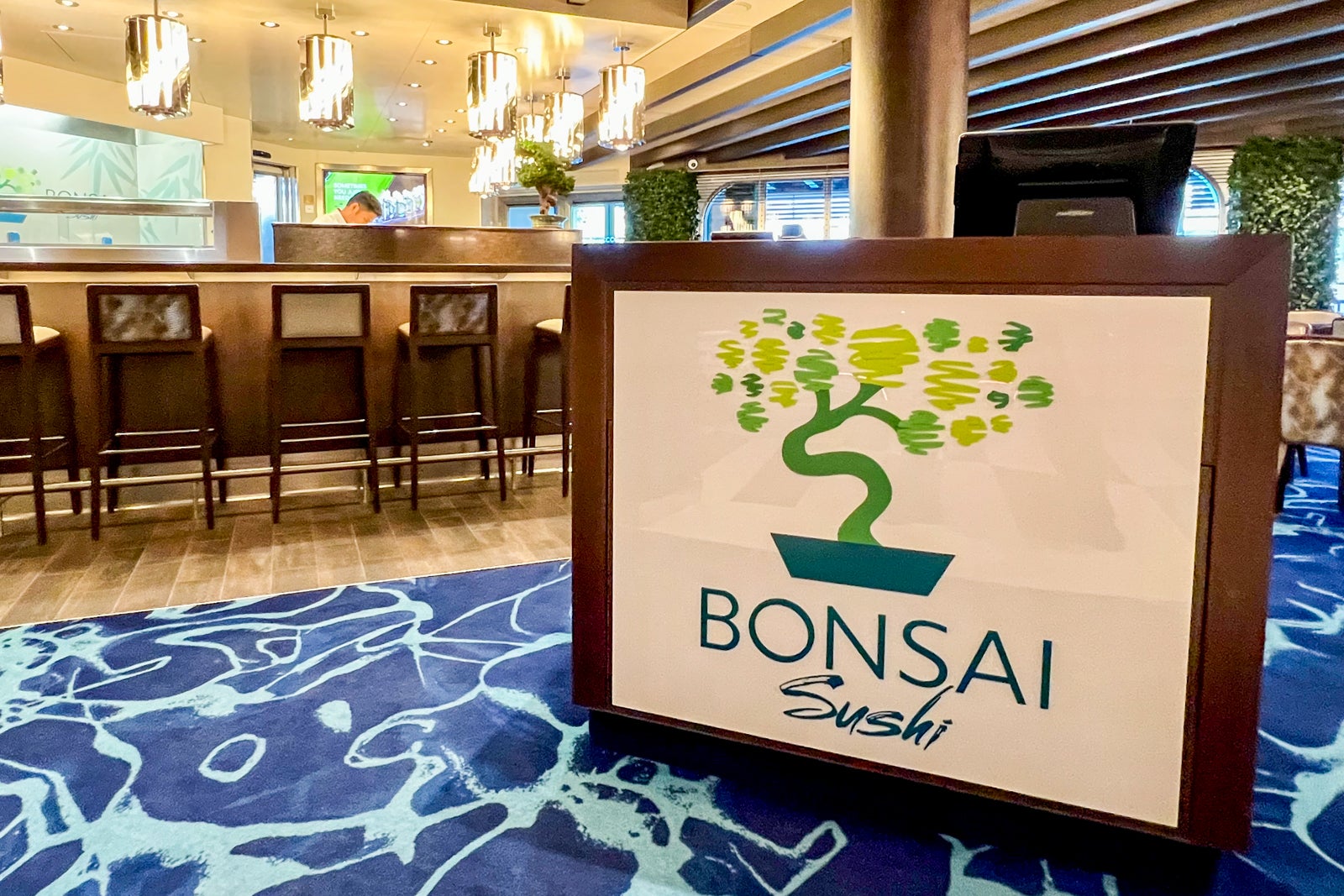
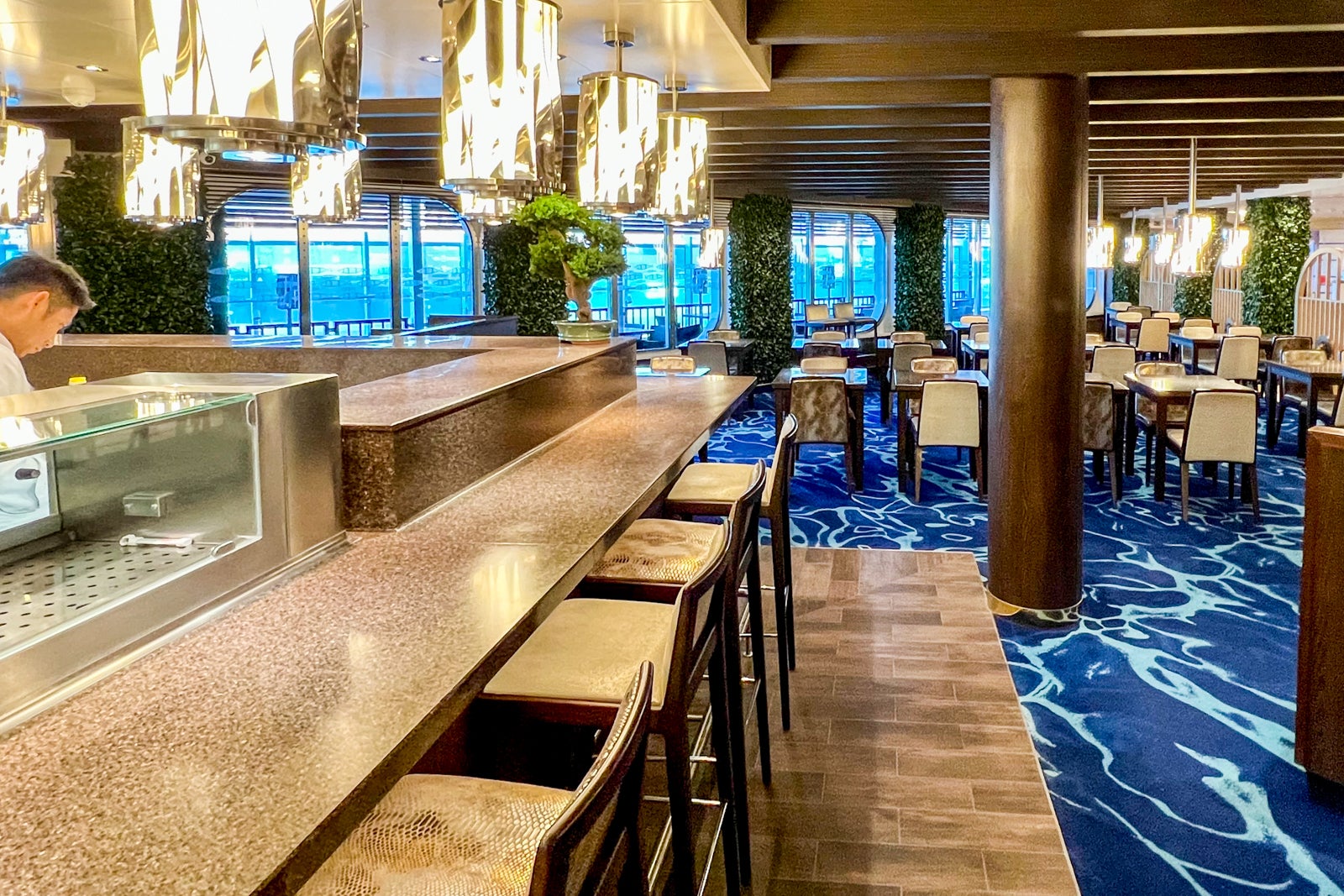
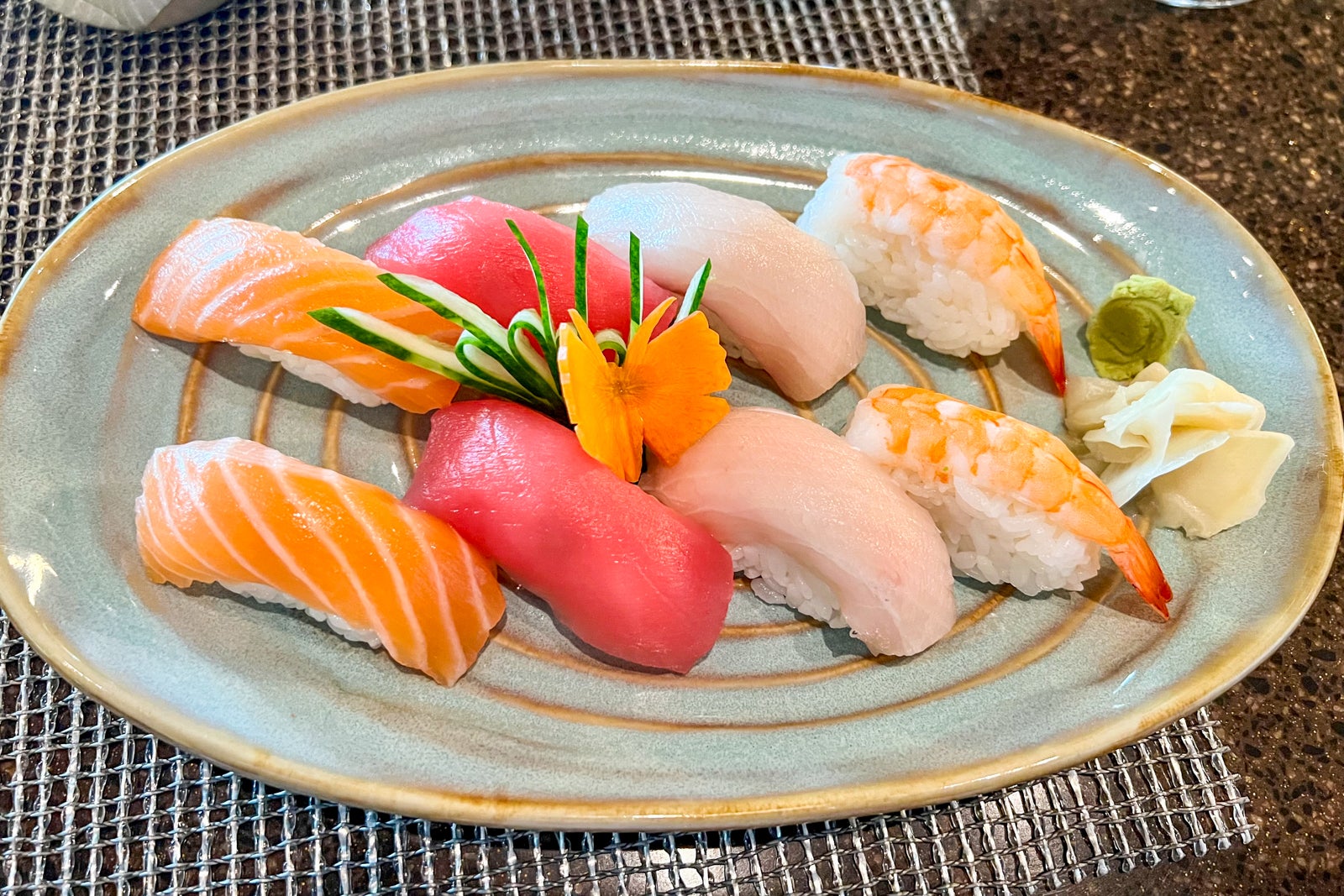
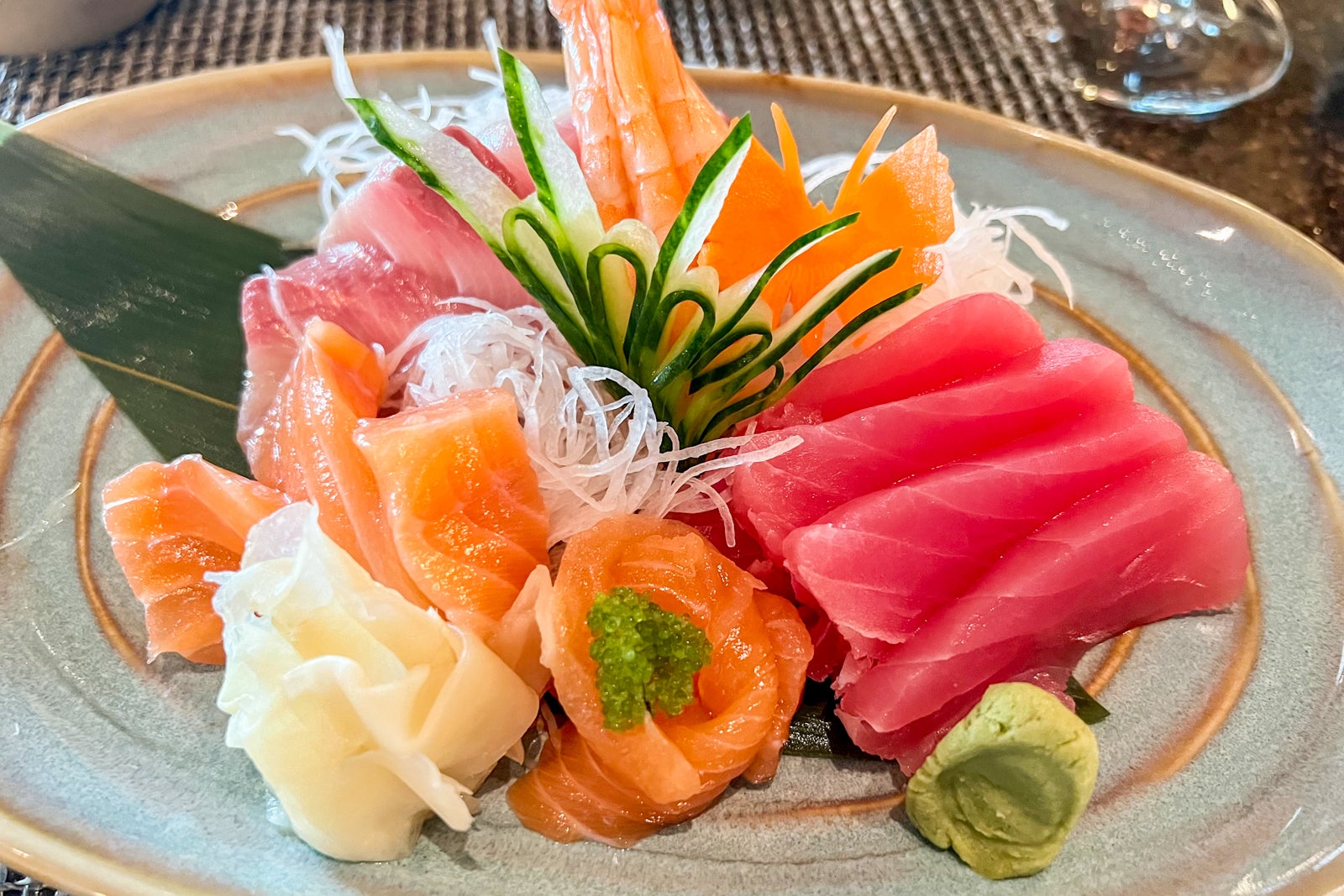
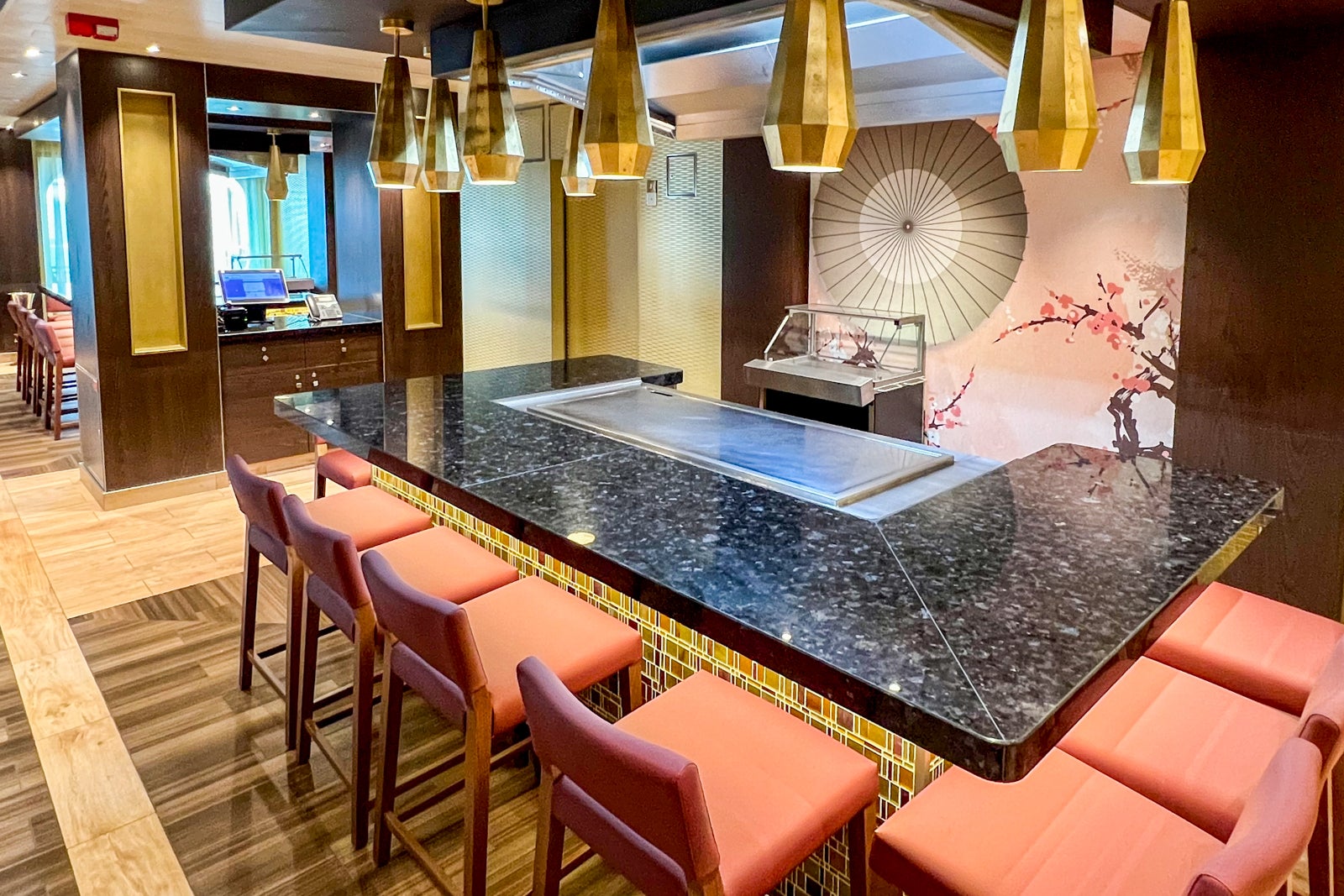
Bonsai Teppanyaki is a classic teppanyaki eatery with a cover charge of $35 per person for lunch and $38 per person for dinner. For that price, you’ll get starters such as pork belly yakitori and spicy tuna followed by a main course of teppanyaki-style salmon, lobster tail, shrimp, grilled tofu, black cod or filet mignon (or various combinations of these six options). Dessert is a chocolate “bento box” with green tea ice cream.
As is the shtick with teppanyaki eateries everywhere, the main courses here are all cooked in front of you on a steel-topped grill with various hijinks from the chef along the way. If you have the kids in tow, it’s a crowd-pleaser. If, like me, you’ve moved past the age of having young kids and have suffered your fair share of family-friendly dinner shows, it’s all a bit tedious.
Either way, the good news is that getting a seat for teppanyaki on Carnival Venezia is a little easier than on most Carnival ships, as there are more teppanyaki tables (four) at the ship’s Bonsai Teppanyaki than at similar eateries on other Carnival ships — more fallout of the vessel being built for the China market.
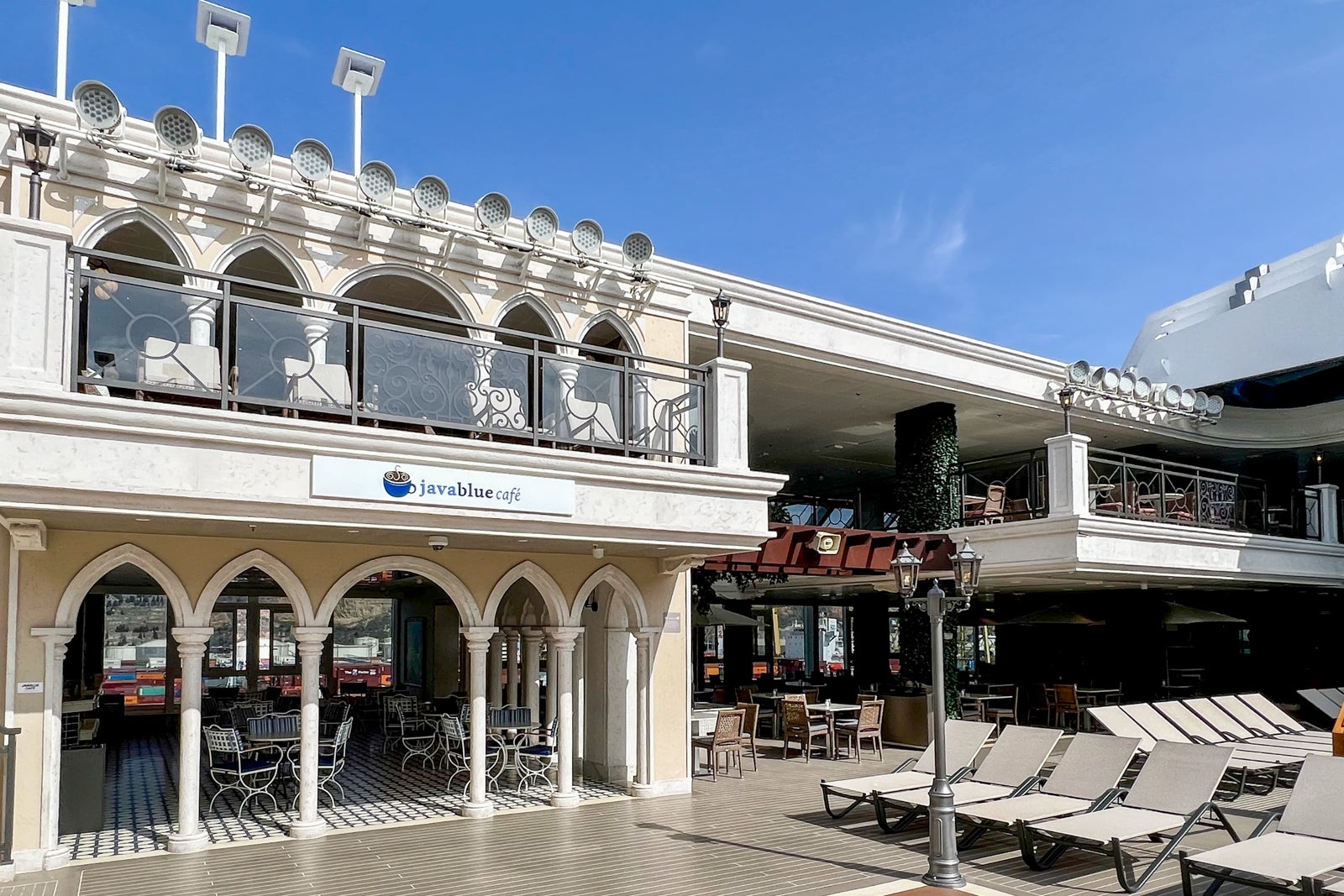
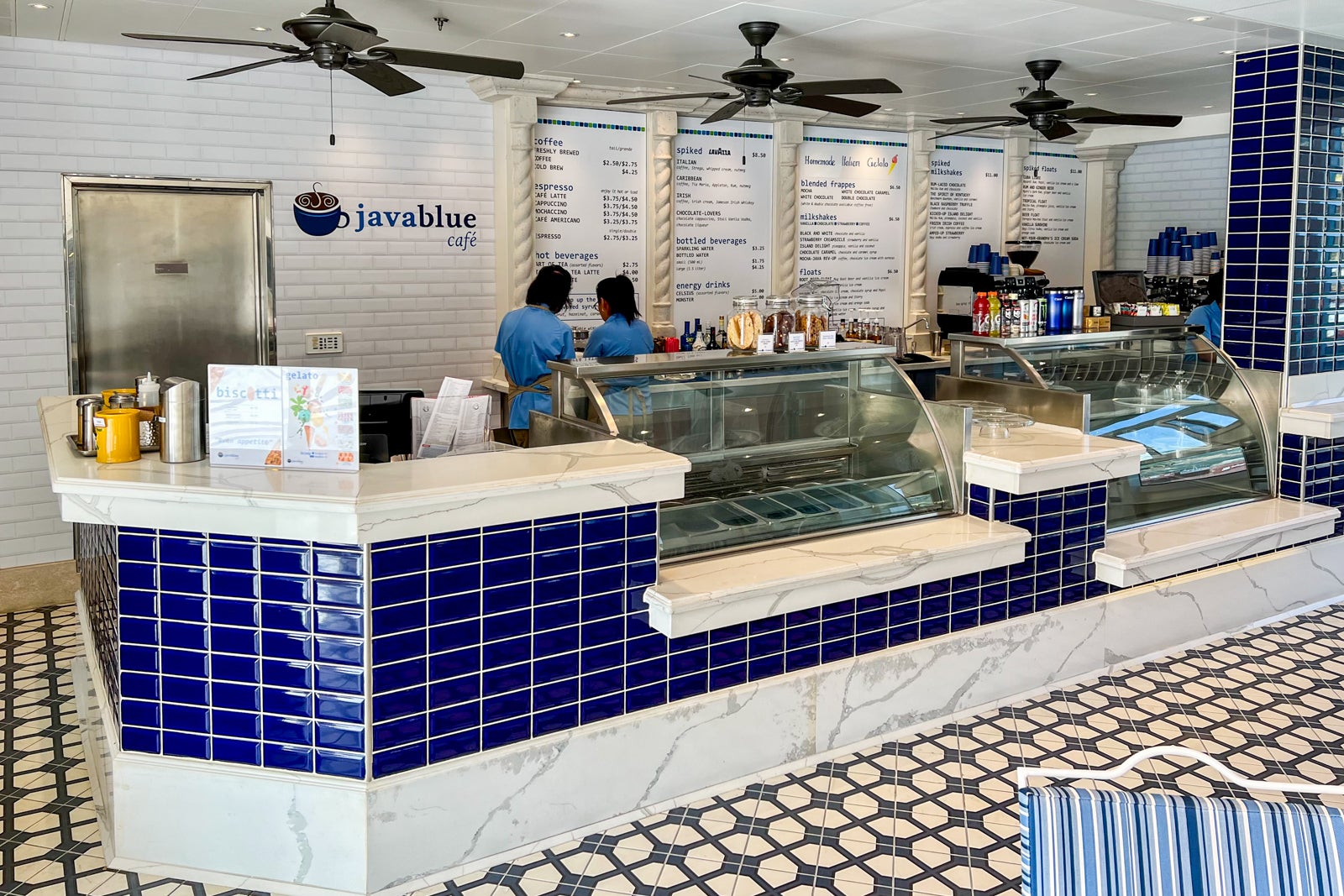
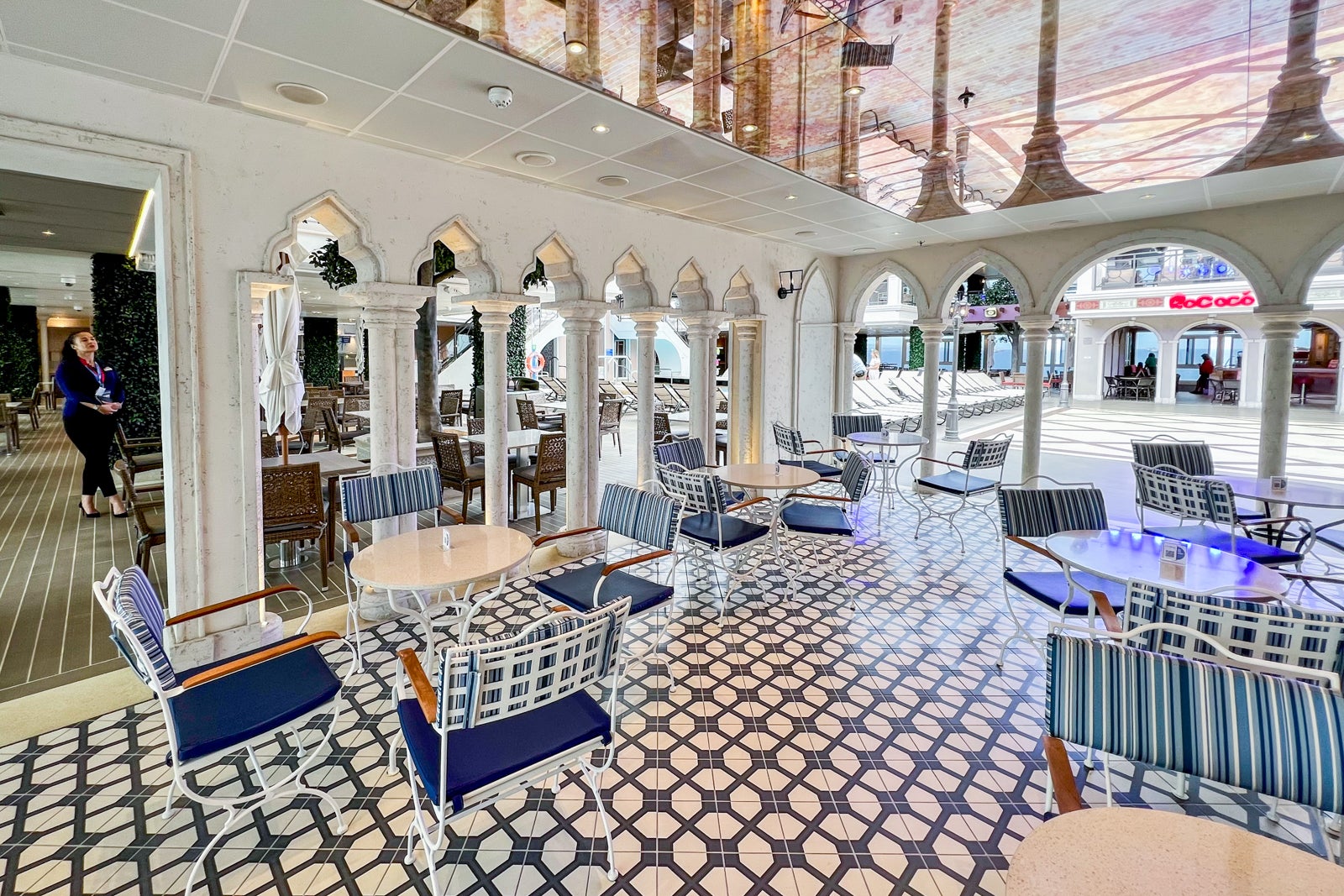
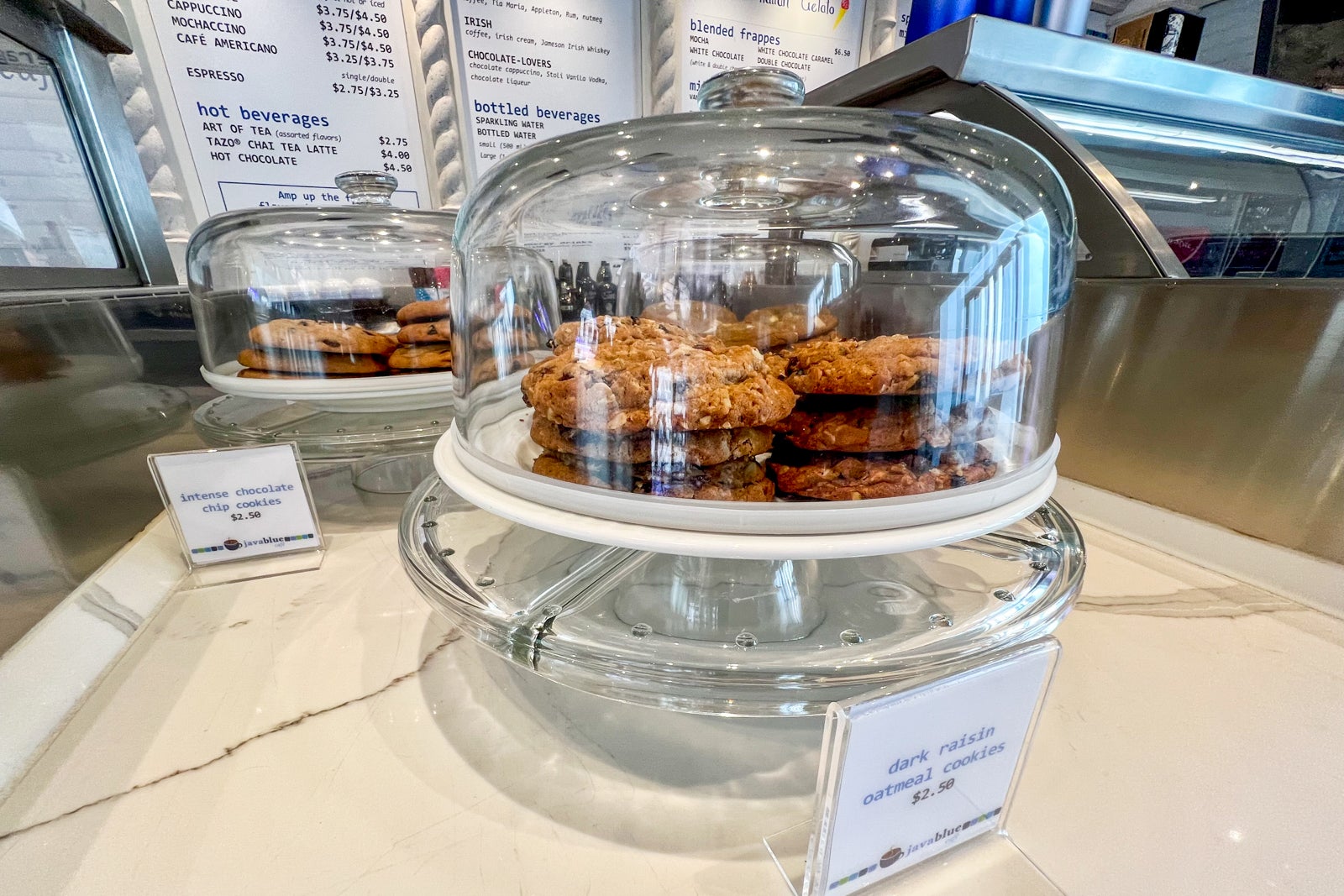
Meanwhile, the food options don’t end with the restaurants. An enticing array of extra-charge gourmet cupcakes and doughnuts ($4), cake slices ($6) and cookies ($2.50) are available at JavaBlue Cafe, which is at the top of the ship near the Lido pool. It’s also home to fantastic homemade Italian gelato (hey, more of the Italian theming) for $3 a scoop ($5 for two scoops), as well as homemade milkshakes ($6.50) and made-to-order LavAzza espresso drinks that you can get spiked if you so choose.
Bars
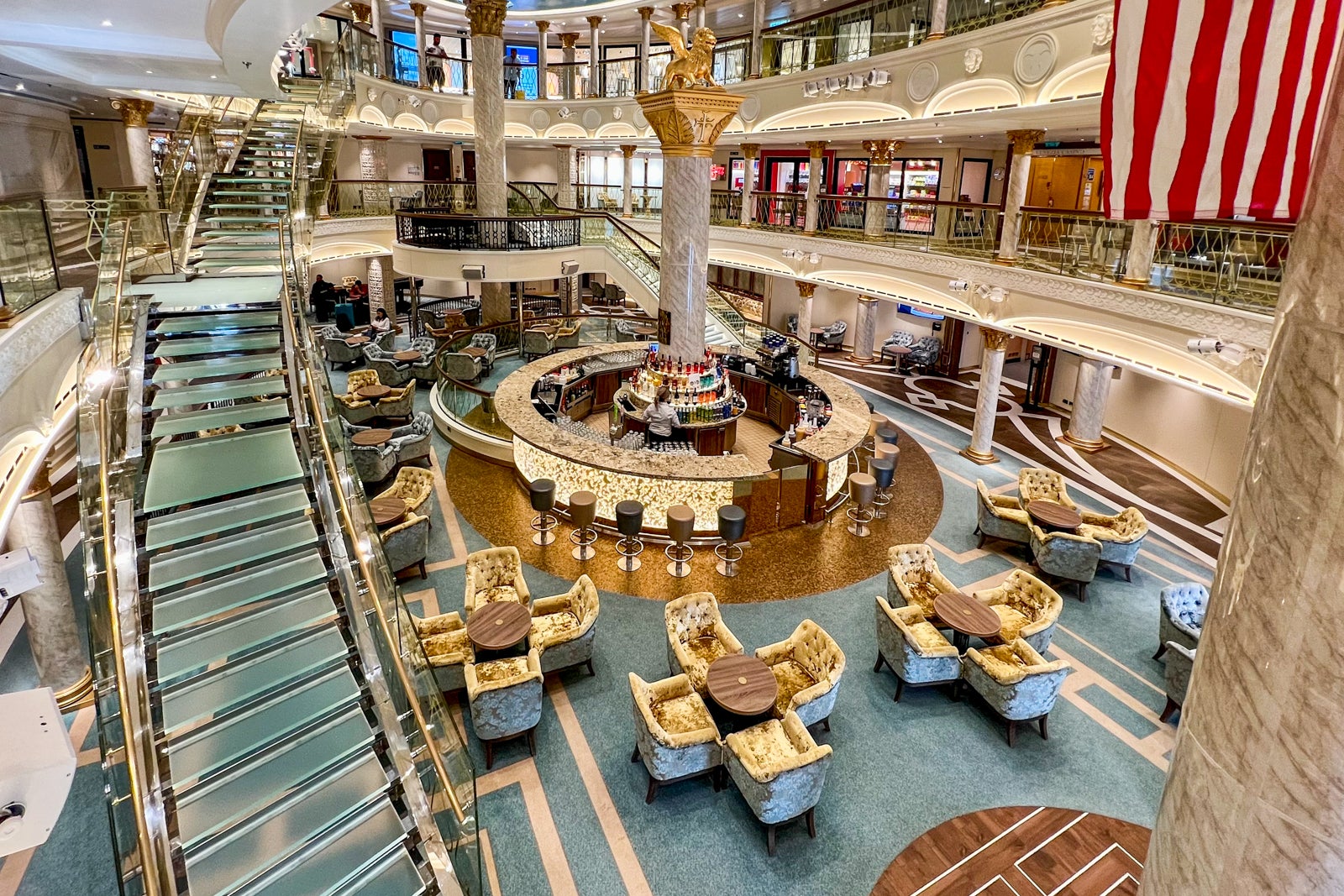
Carnival Venezia is packed with bars, as is the way with Carnival ships. You won’t walk far in any public area without hitting one.
The first one you’ll see upon arrival is the St. Mark’s Square-themed Atrium Bar, with its giant winged lion of St. Mark lording over it on a pedestal. Sitting at the base of the ship’s central atrium, which has the Venice-themed name of Piazza San Marco, the Atrium Bar is right in the middle of everything and bustling at all hours. That’s partly because it’s a hub for live music — either a singer and pianist, a solo guitarist or a string trio, depending on the time of day.
You can find all your standard mixed drinks here, but its specialties are tropical classics (Bahama Mama, Tequila Sunrise) and martinis.
Fanning out from the top of the atrium on Deck 5, you’ll run into a string of additional drinking establishments, each with its own theme.
Perhaps the most unusual is the stylish Amari bar, a new concept for Carnival that serves up specialty cocktails crafted with Italian Amari liqueurs and bitters. Some you would know, such as Aperol and Campari, and some you’ve probably never tried, such as Zucca, Averna, Cynar, Ramazzoti, Braulio, Montenegro and Nonino.
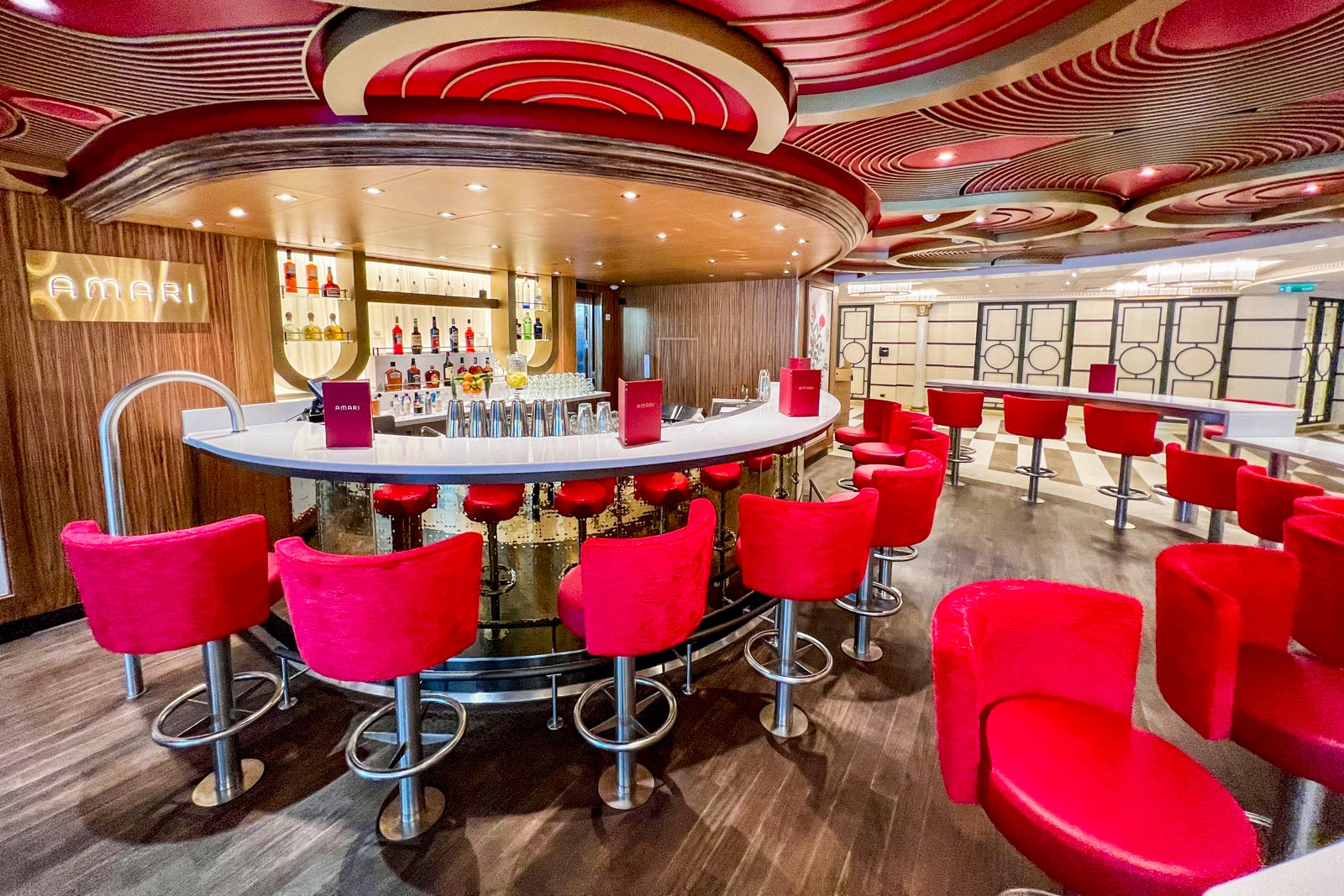
The curated list includes such unusual yumminess as the Bitter Guiseppe, a rift on a Manhattan made bittersweet with Cynar, vermouth, lemon and bitters. Or try the Negroni Sbagliato, a sparkling variation on the classic Italian cocktail made with Campari, Cinzano 1757 Vermouth di Torino and prosecco sparkling wine. You also can order Amari samplers with a choice of three of the liqueurs and bitters straight up.
Amari essentially replaces the cocktail-serving Alchemy Bar found on most Carnival ships. Fans of that bar will be relieved that Amari also offers a selection of that bar’s most popular cocktails.
Just be warned: With so many new-and-unusual-for-Carnival crafty creations at the Amarai bar, you might just blow your drinks budget here if you haven’t bought the ship’s drinks package.
Just a few steps away from the Amari bar, working your way aft, you’ll hit the sleek new Frizzante Bar, located in front of the Il Viaggio Italian restaurant. This bar’s specialty is bubbly cocktails, most with an Italian twist. You’ll find the classic Aperol Spritz here, as well as versions made with Campari, Amaro Averna and Creme de Cassis. The menu also features Bellinis, Limoncello Mojitos, Negronis and a relatively wide range of whiskeys.
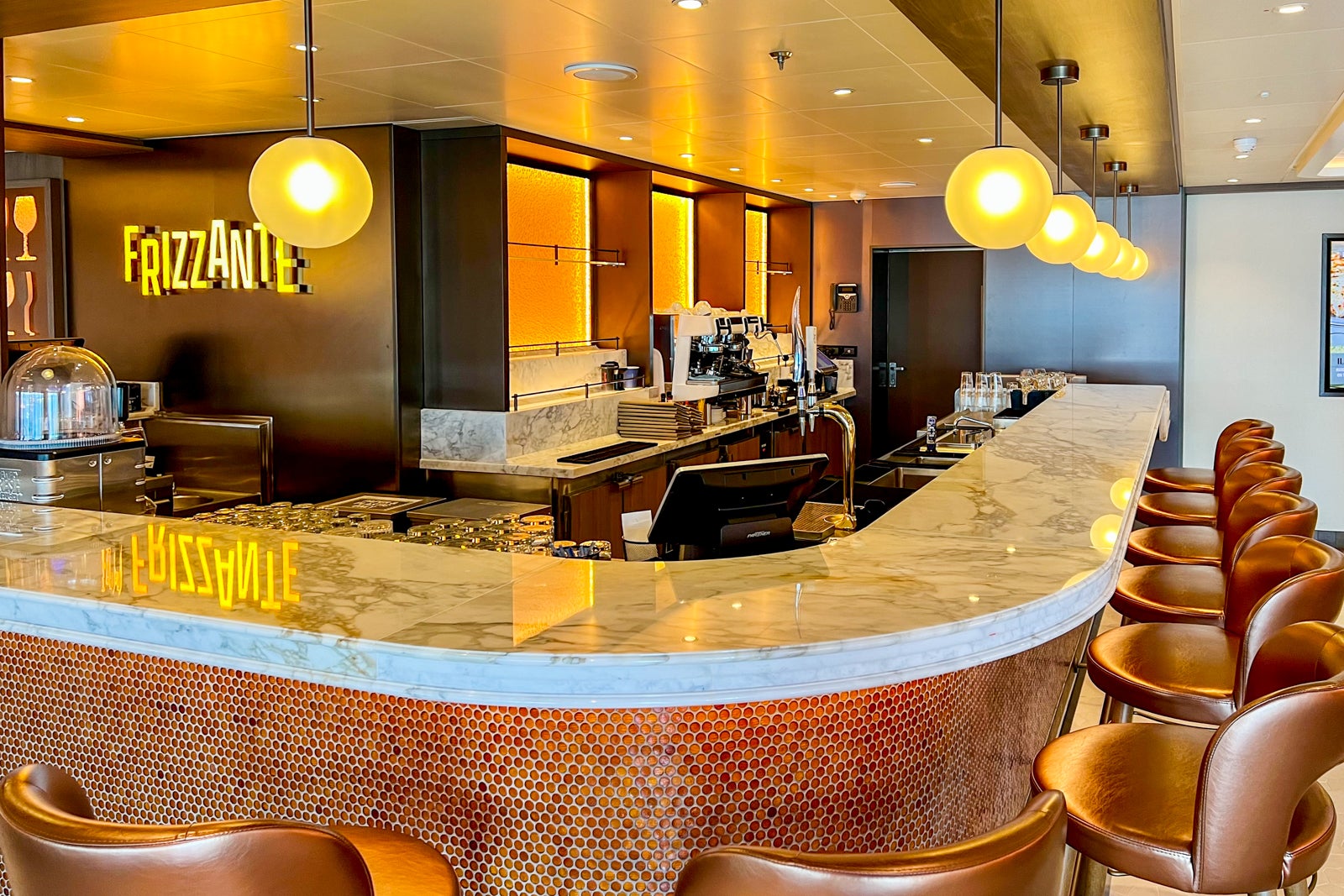
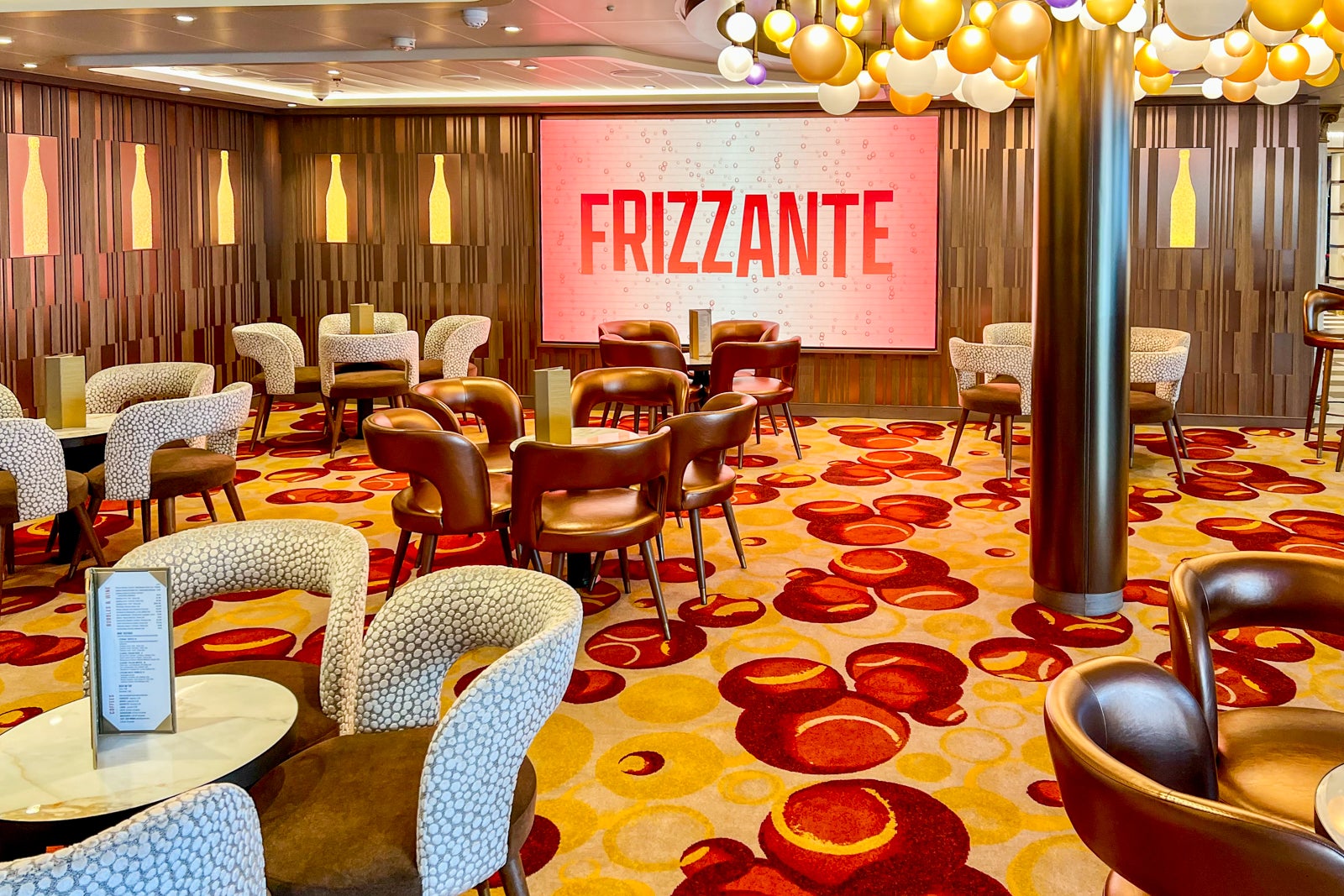
As a nod to the ship’s theme, the two beers on tap at Frizzante — Peroni and Birra Moretti — are brought in from Italy.
If you’re traveling with one or more people avoiding alcohol, Frizzante Bar and Amari might be your two new favorite Carnival bar venues. Bartenders at both can make some of their iconic specialty drinks with non-alcoholic Lyre’s Italian Spritz and Classico sparkling wine. They look and taste like the real thing but without the buzz.
Another Deck 5 favorite is the sprawling Gondola Lounge, which has its own stage and dance floor. It’s the site of trivia contests during the day and live music and dancing at night, and its specialty is sangria (available by the glass or pitcher). The pricing for the sangria is a bit over the top for what is supposed to be a low-cost drink. A pitcher will set you back $36.
The Gondola Lounge is another outlet where you can get your daytime caffeine fix as it serves up LavAzza espresso drinks.
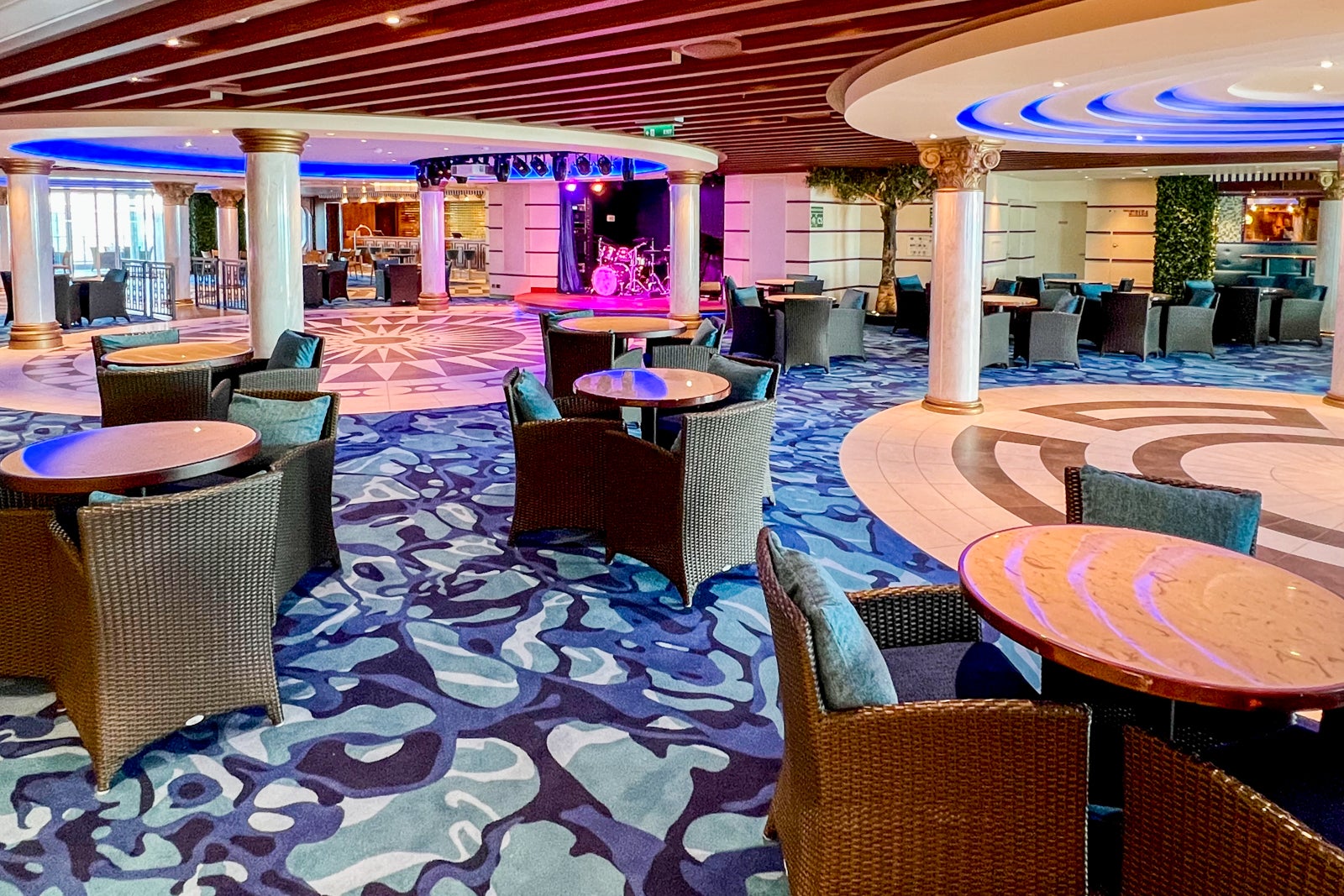
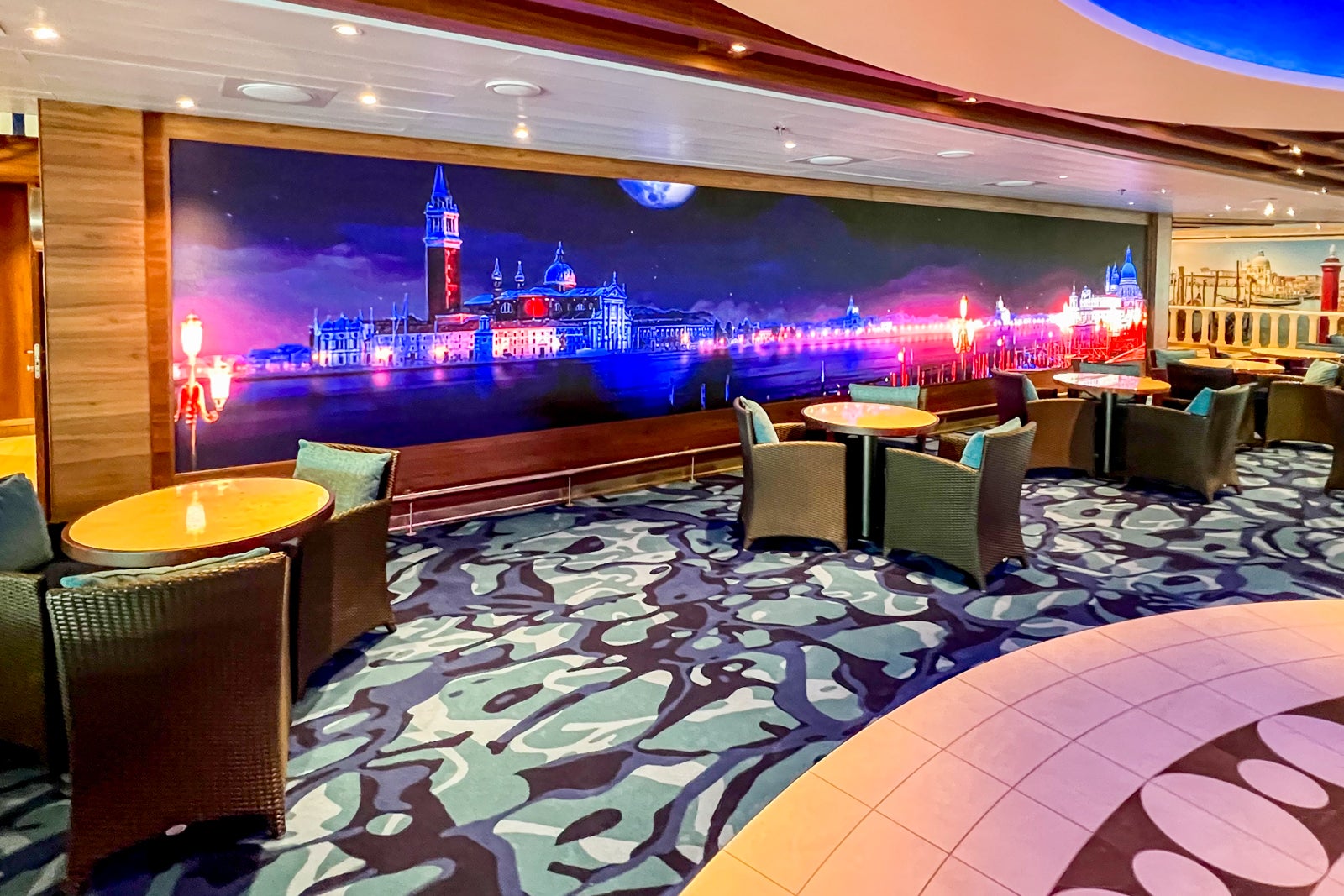
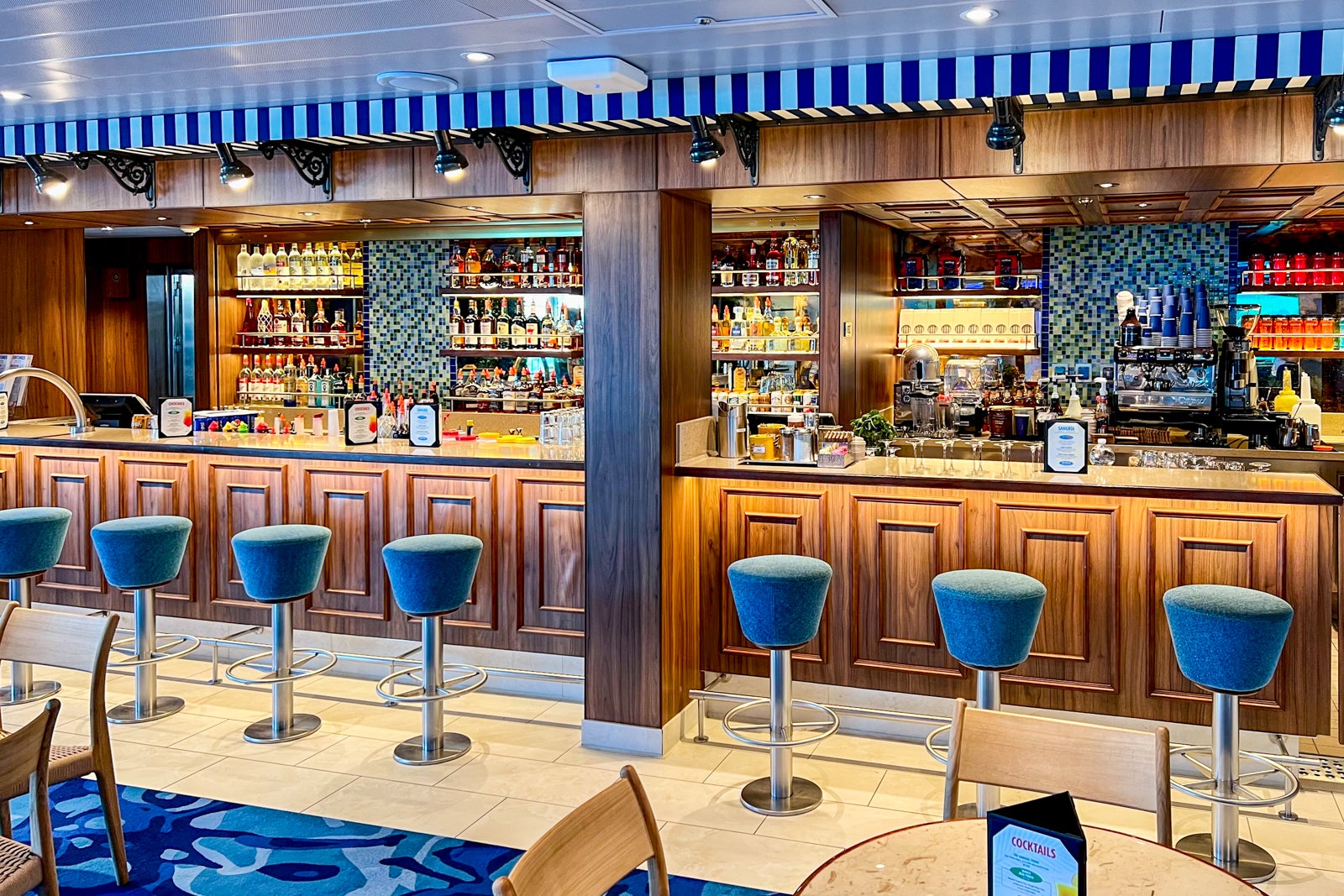
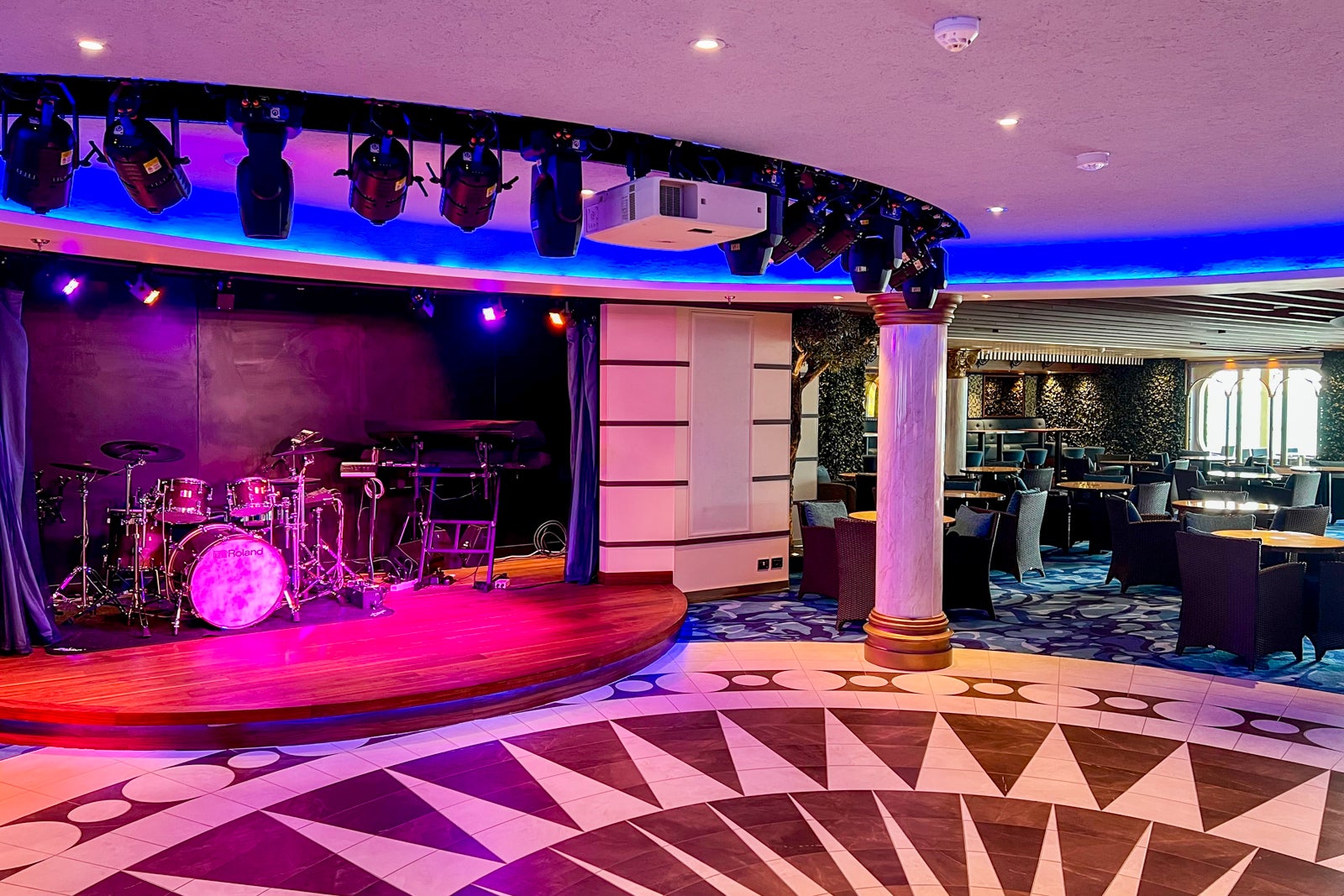
The lounge, like the nearby Canal Grande Restaurant, once had a real gondola sprawled out along one wall. It was removed during the overhaul of the ship after it was transferred from Costa to Carnival (my as-yet-unanswered question: Where did that gondola go?).
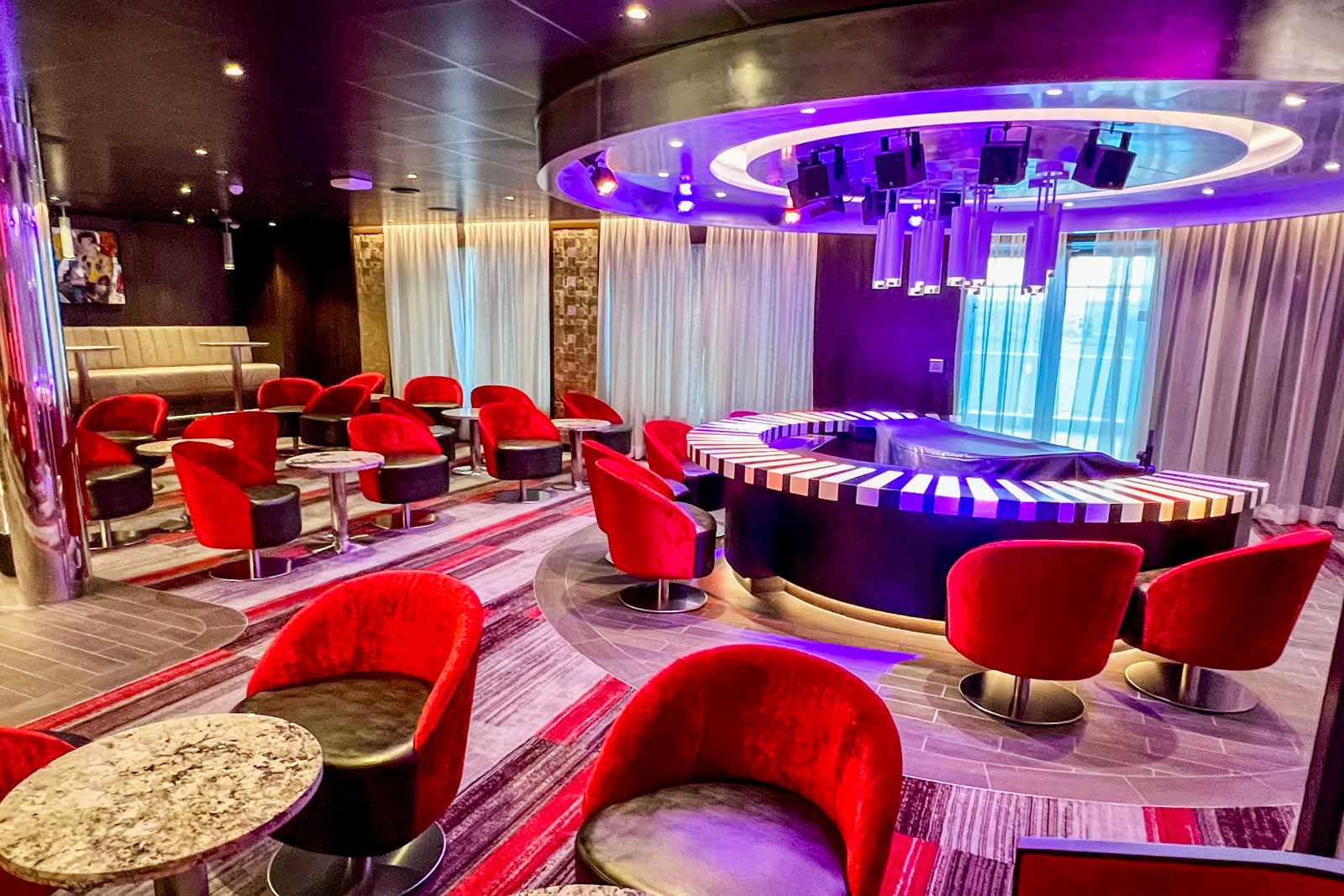
Two more bars on the same deck (yeah, that’s five bars on a single deck!) include the cozy Piano Bar 88, which is part bar, part live piano music venue, and the Carnevale Bar and Lounge (mentioned in passing above). Keeping with the Italian theming, the latter is all about variations on the classic bellini, including an apple cider cucumber bellini, a blood orange bellini and a spicy mango bellini. The Carnevale Bar and Lounge is also the place to get spiked espresso drinks — if infusing yourself with stimulants and depressants at the same time is your thing.
Three additional bars around the top-deck pool areas (Rococo, the Pergola Bar and the Burano Bar) serve all the daiquiris and coladas you can drink, plus just about anything else alcohol-related you’d want to order while lounging by a pool. Our favorite of them all is Rococo, which Costa’s designers gave an elaborate Italian palace theme with 1700s-era Rococo paintings on the walls that Carnival’s designers subsequently defaced in the most hilarious of ways.
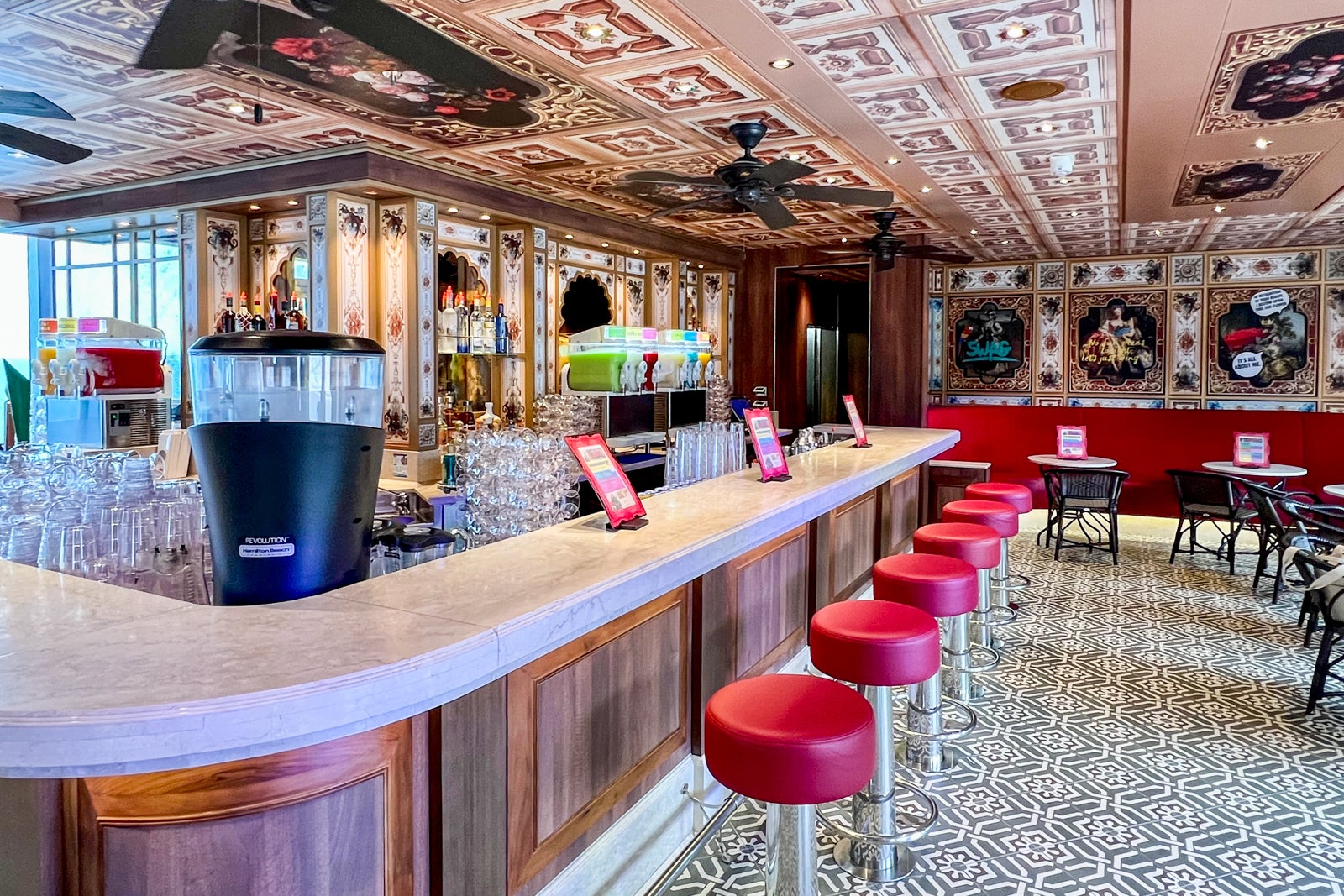
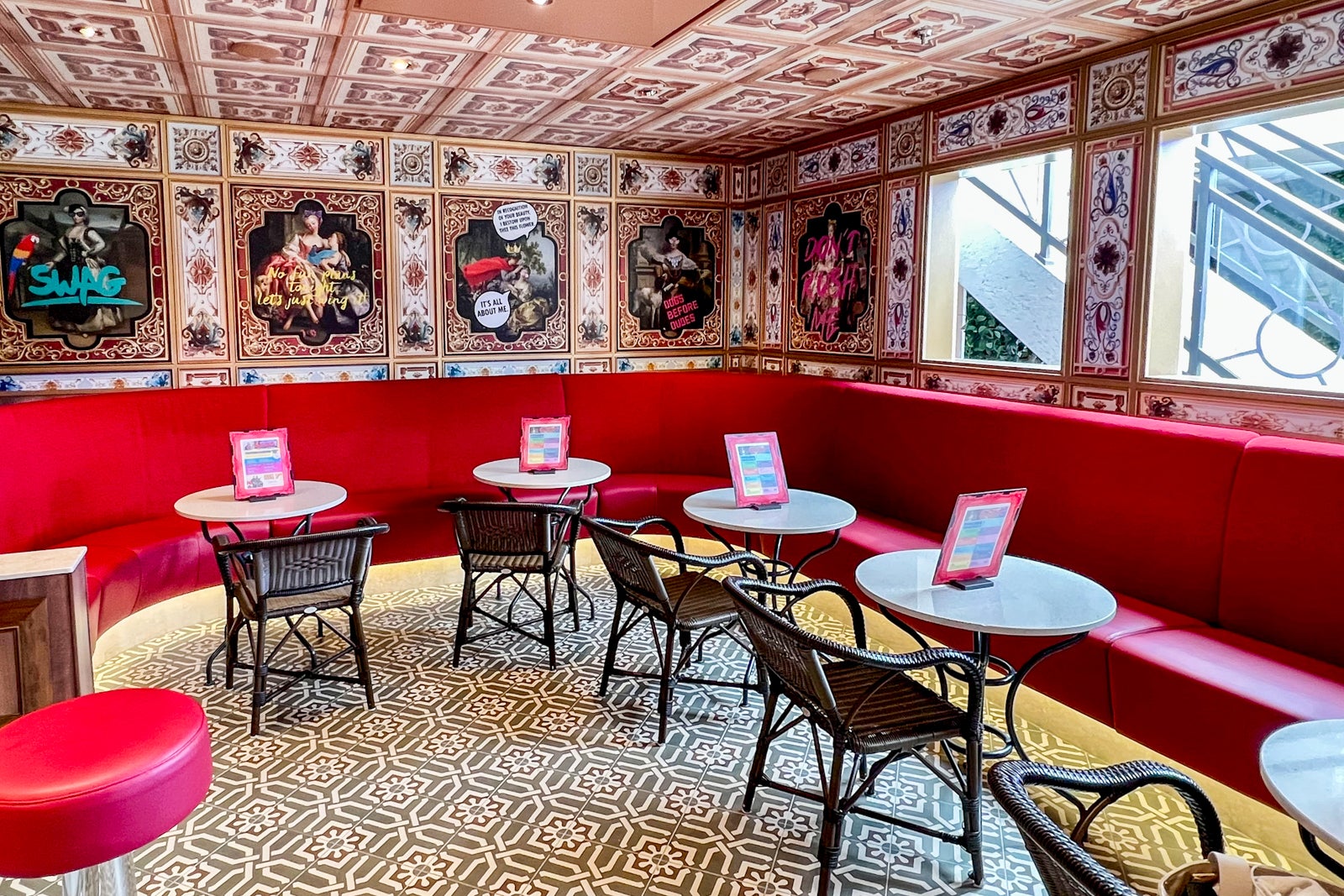
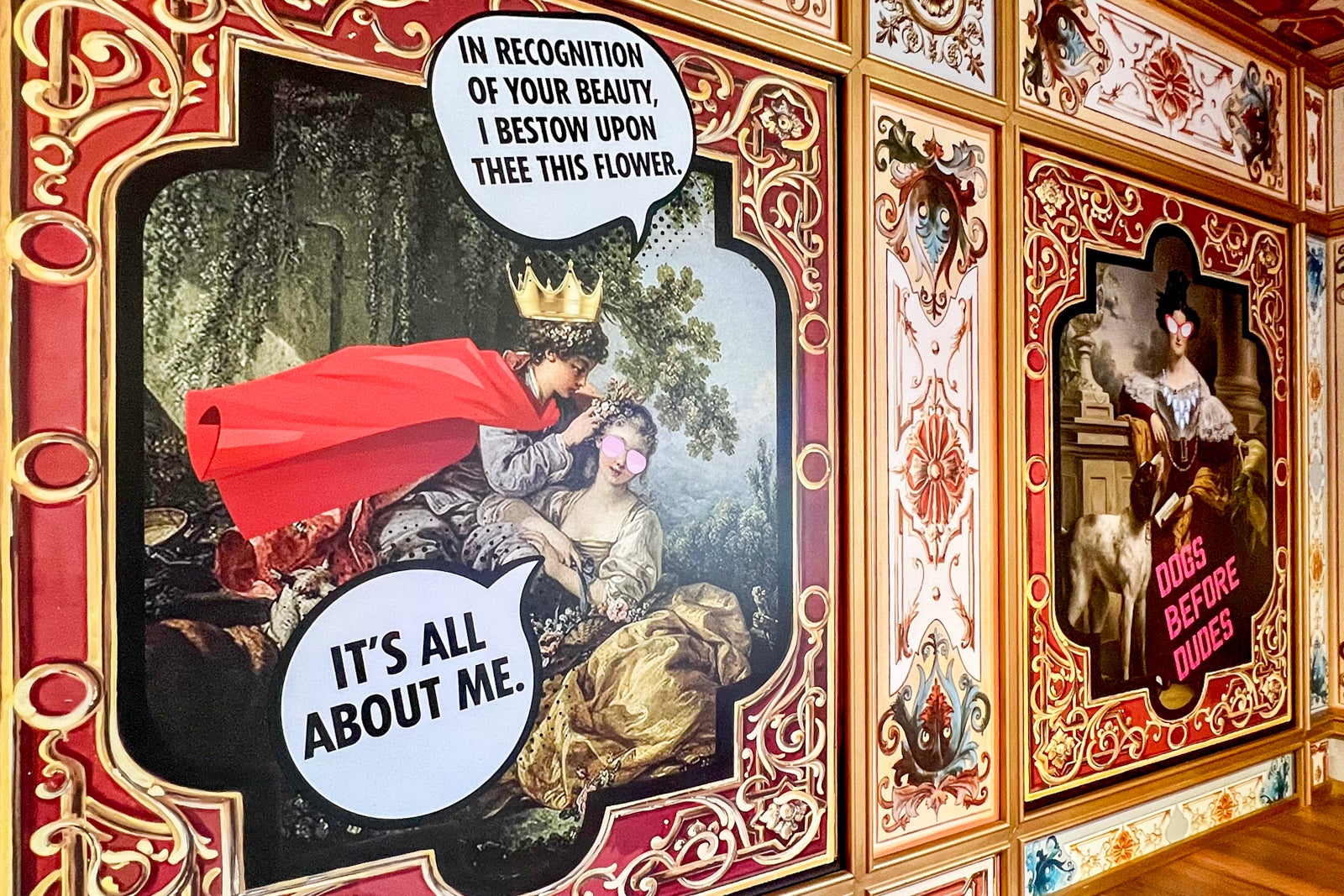
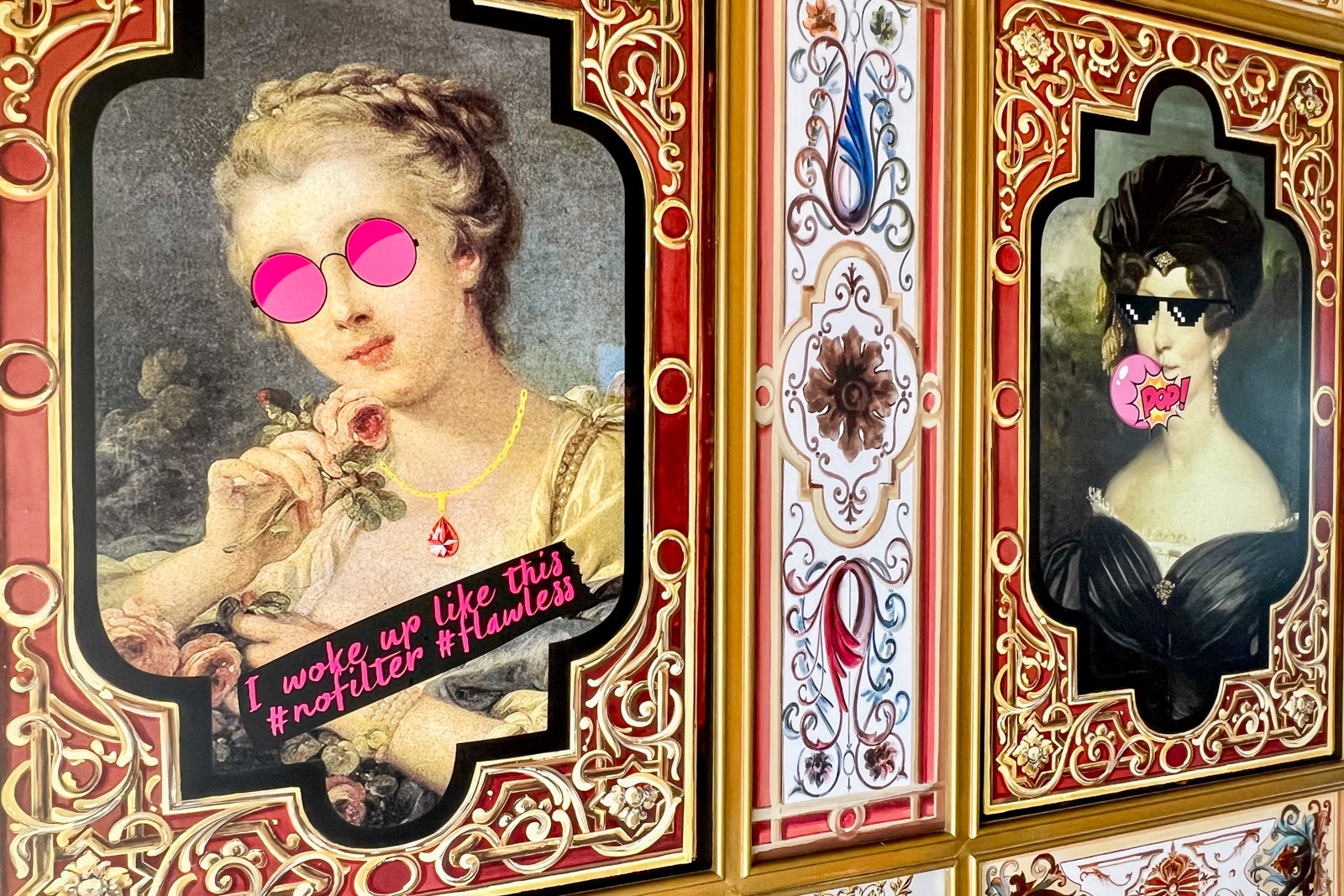
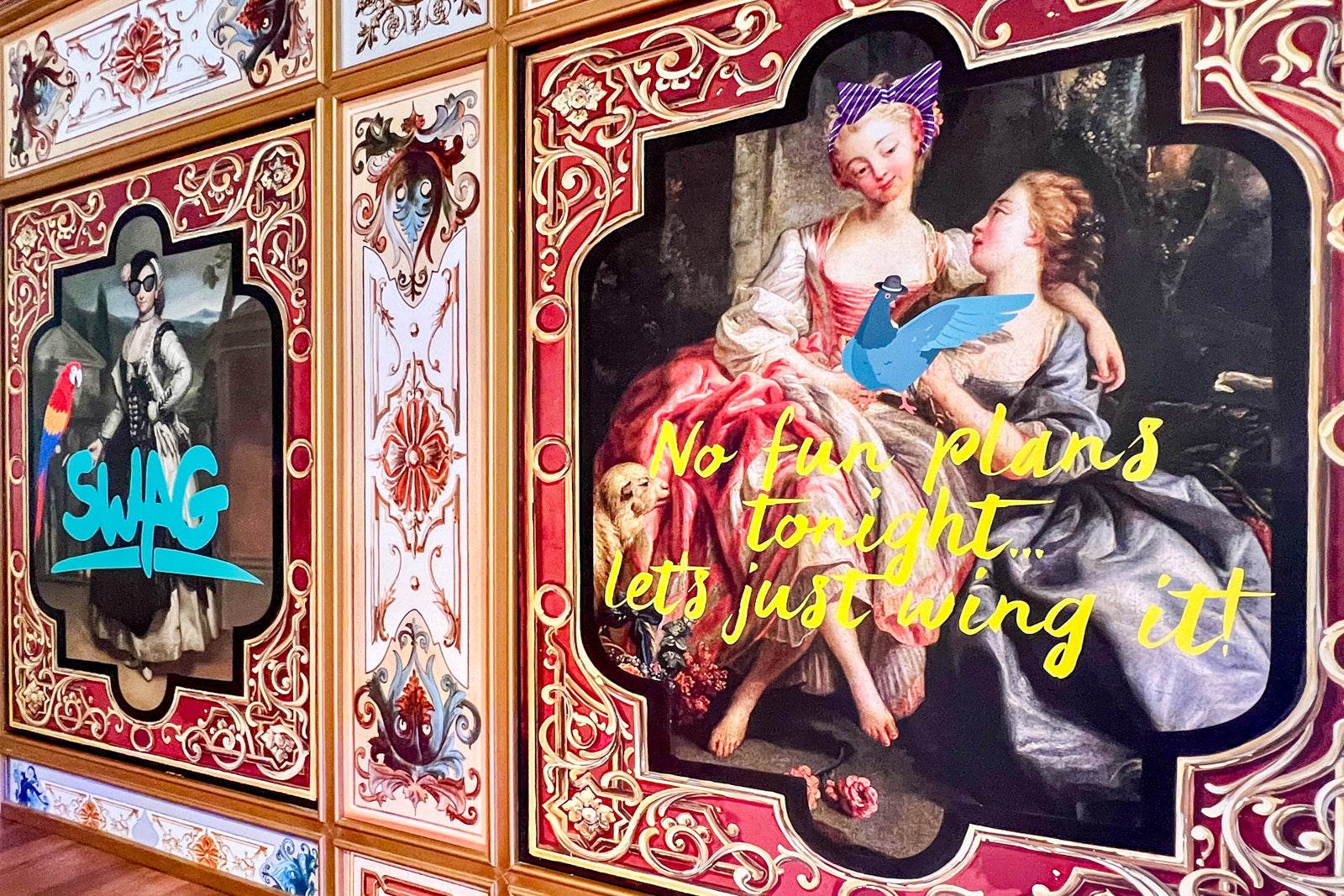
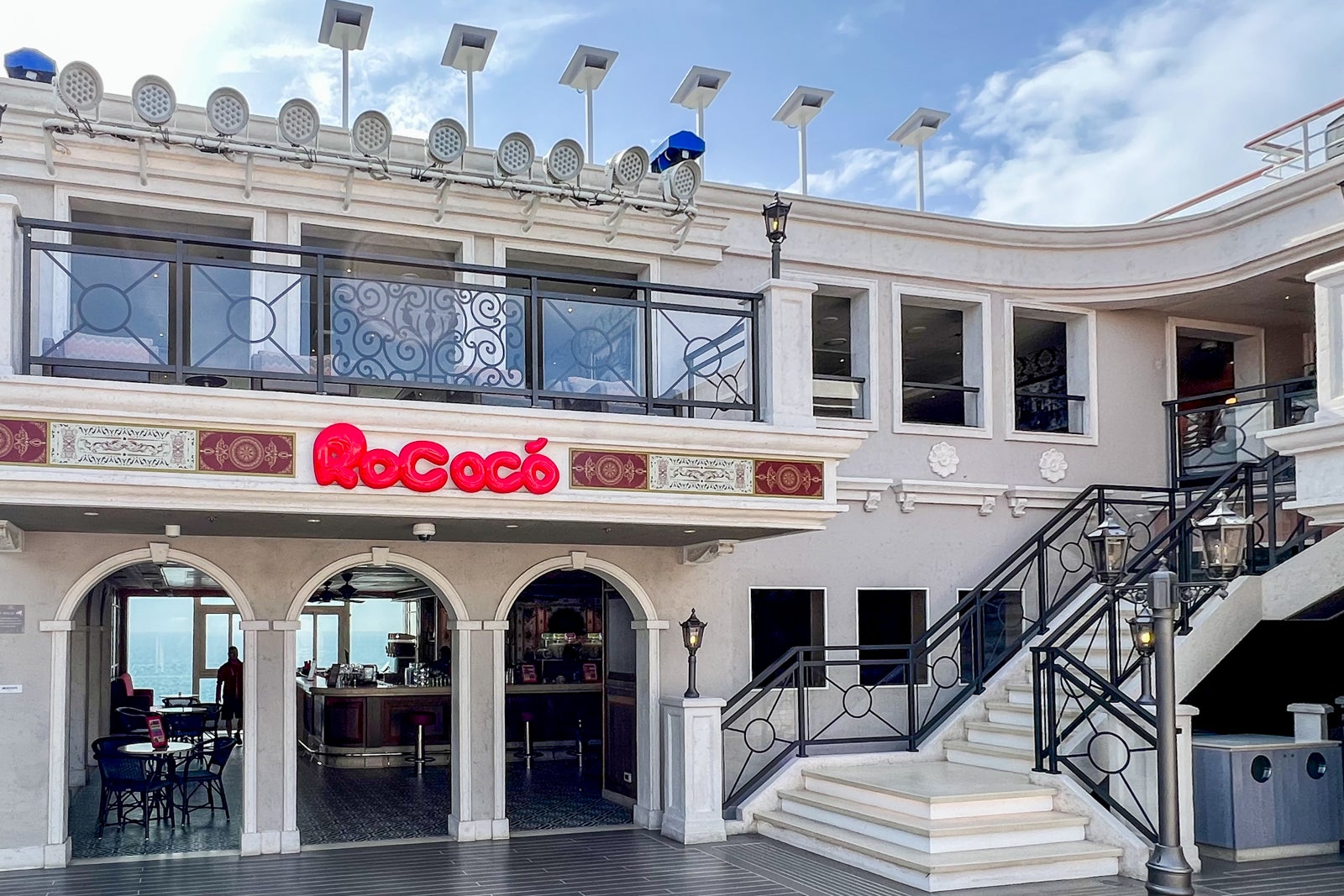
On one painting of a Renaissance woman being given a flower by a suitor, the Carnival designers painted pink sunglasses onto the woman and added a caption that says, “It’s all about me.” Another painting of two women in 1700era outfits is overwritten with the words “no fun plans tonight … let’s just wing it” and has a blue pigeon with a hat overpainted onto it for good measure.
Carnival Venezia activities and shows
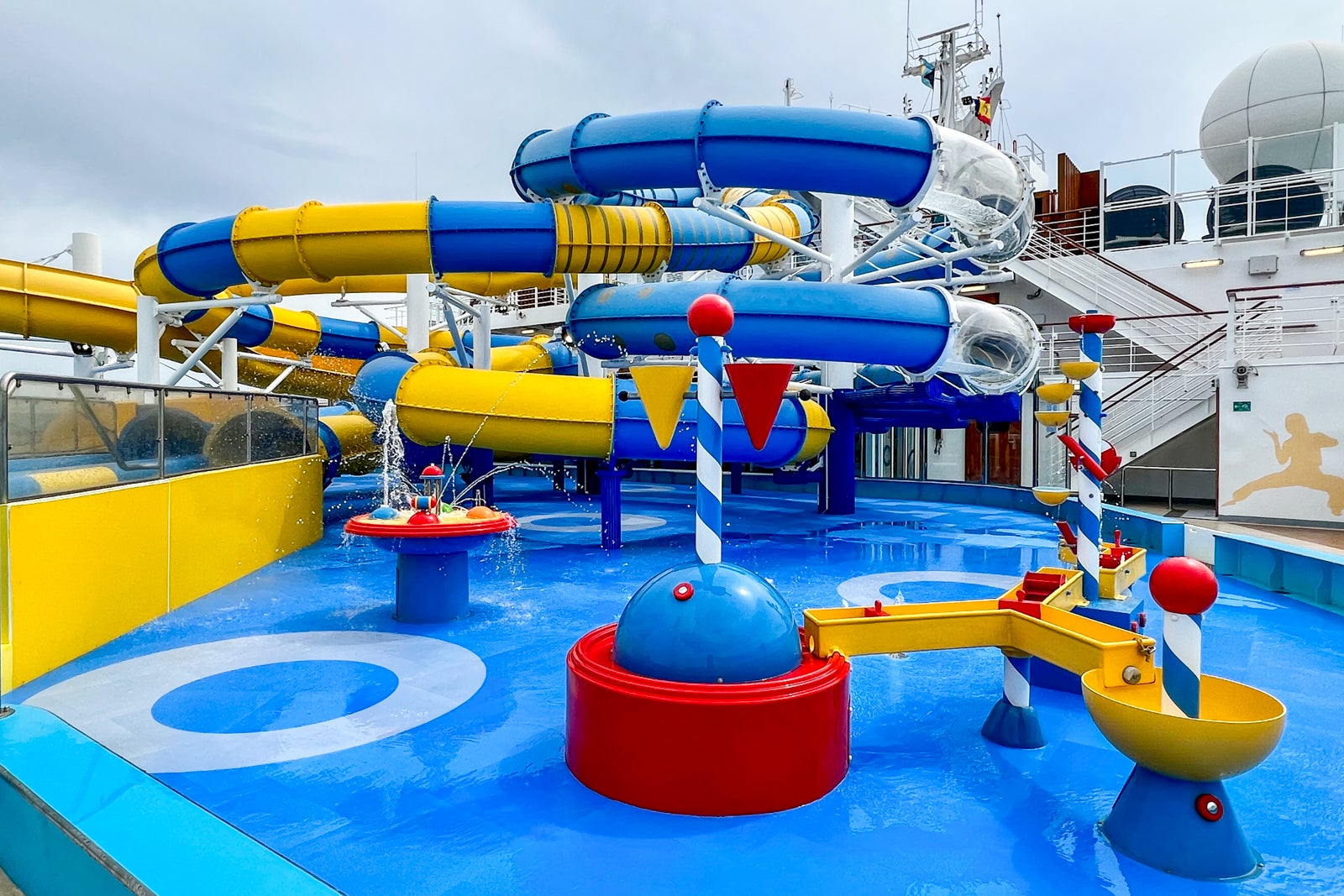
As is typical for Carnival ships, Carnival Venezia is loaded with attractions that appeal to both adults and children, including multiple entertainment venues, a casino, a spa and lots of top-deck fun zones such as a water park and ropes courses.
In addition, you’ll find all sorts of other diversions on board throughout the day in various lounge areas, from dance classes to bingo games and sports trivia.
For families, the top decks of the ship are where it’s at for daytime fun, starting with a Carnival Waterworks water park that has more slides (three) than almost any other Carnival ship. As a Costa vessel, the water park had two slides, but Carnival jammed in a third during the ship’s 2023 overhaul (while, notably, leaving the water park’s yellow-and-blue Costa color scheme).
Only Carnival’s bigger Mardi Gras and Celebration have as many water slides.
Carnival Waterworks is not far from the ship’s main Lido pool, and there’s a secondary Burano pool at the back of the vessel. As noted above, in part because it originally was built for the Chinese market, Carnival Venezia doesn’t have as much open space with lounge chairs for sunning around the main Lido pool, which could be an issue for the ship when it sails in warm-water locales on itineraries with sea days. On those types of itineraries, lounging space around the main pool comes at a premium.
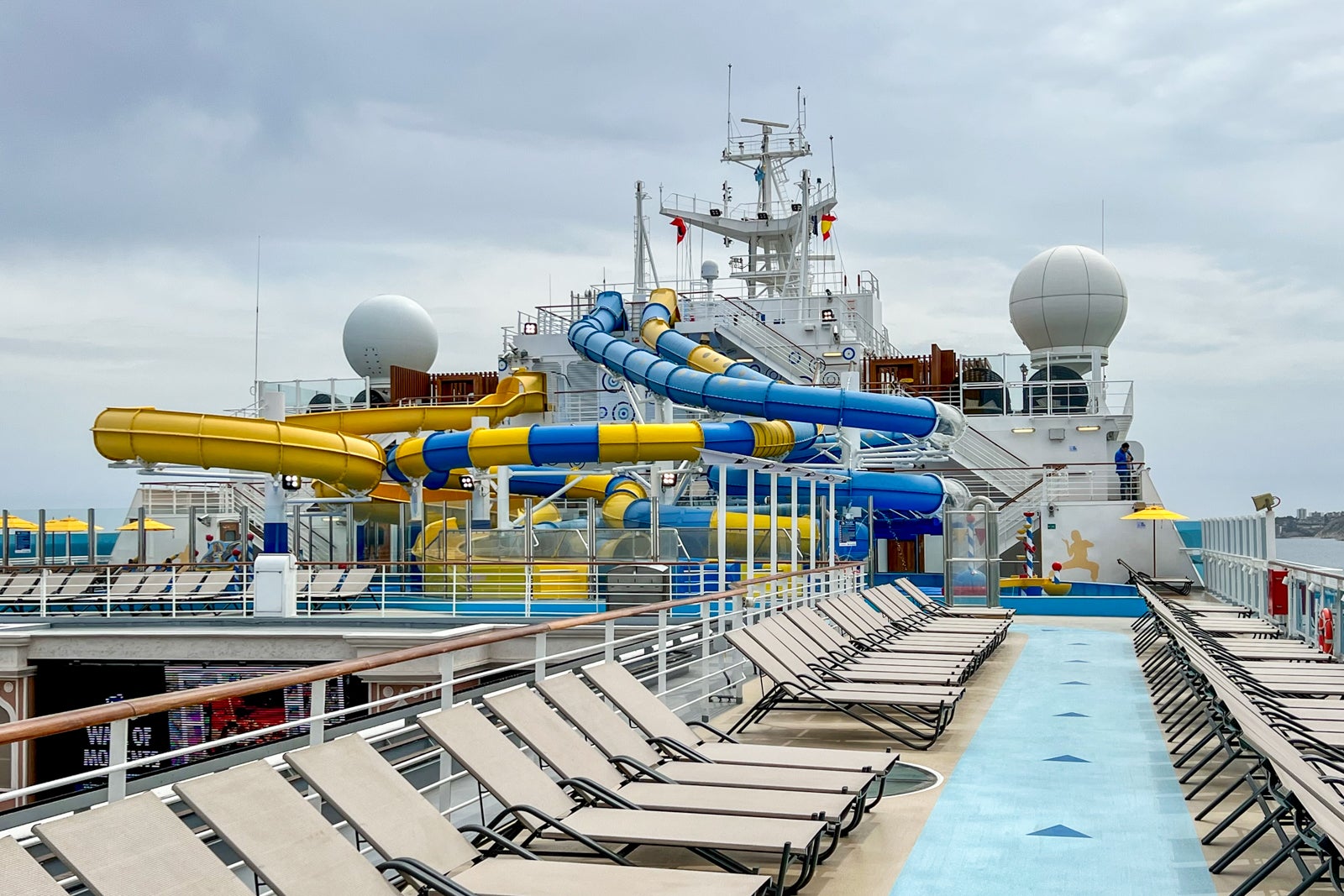
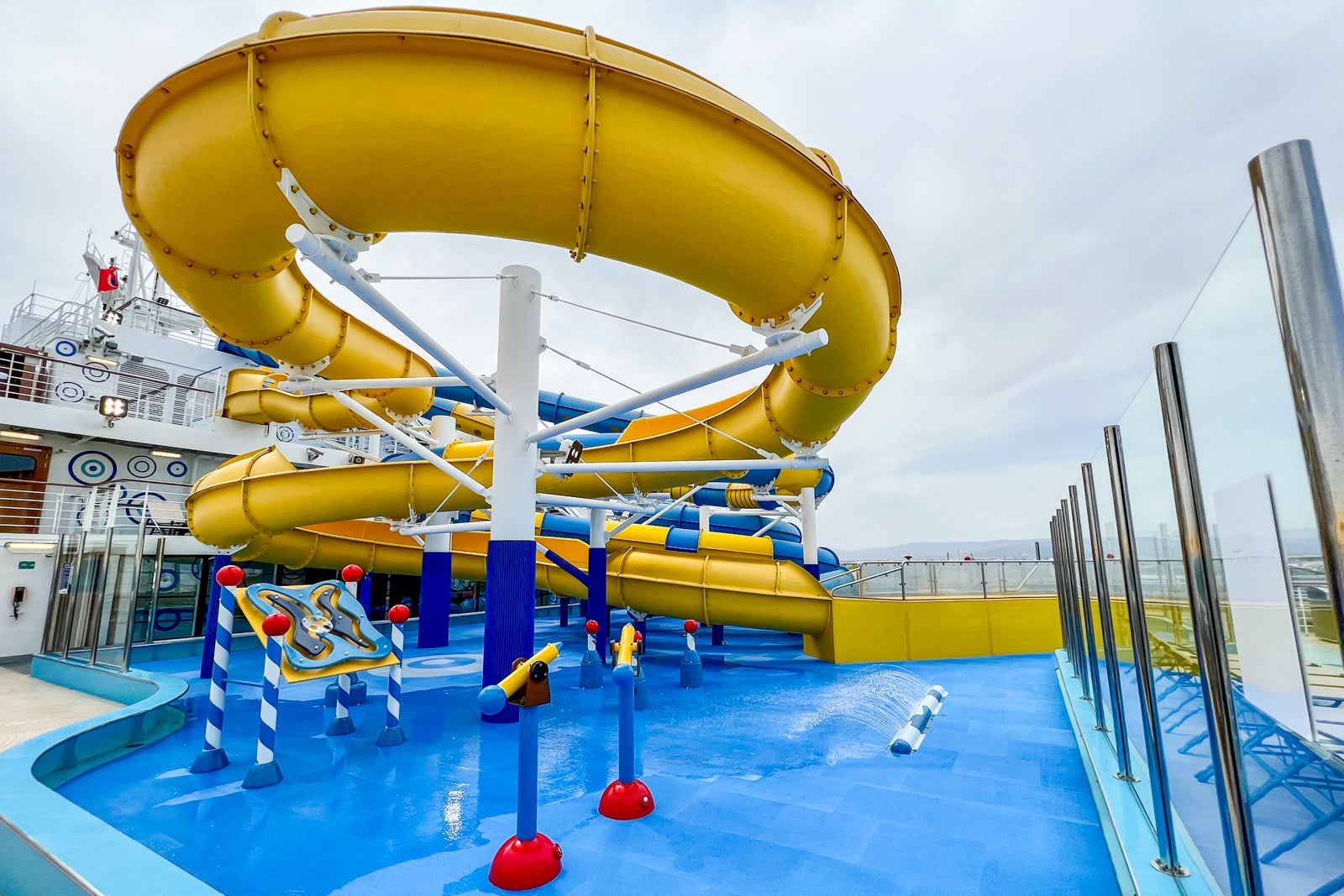

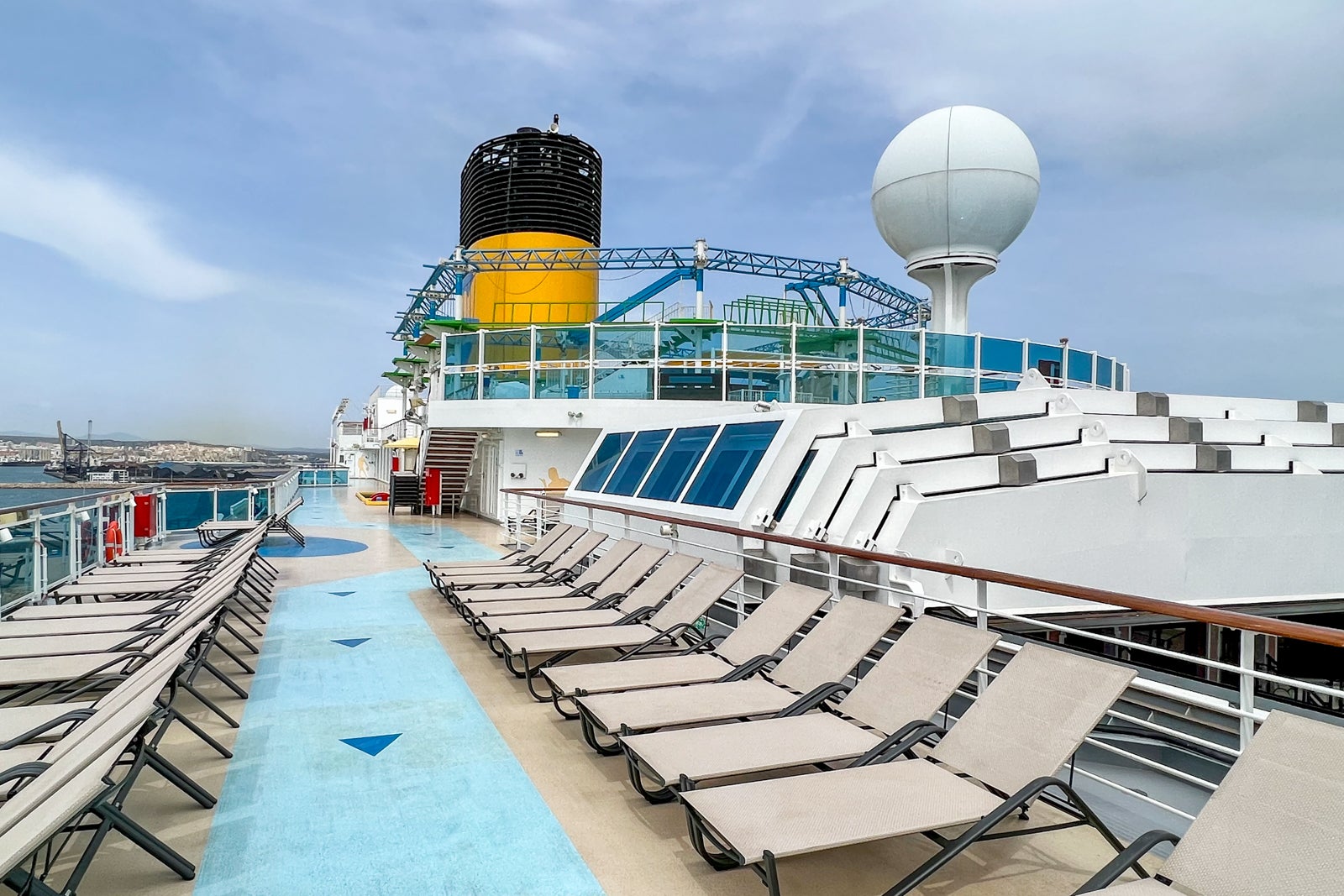
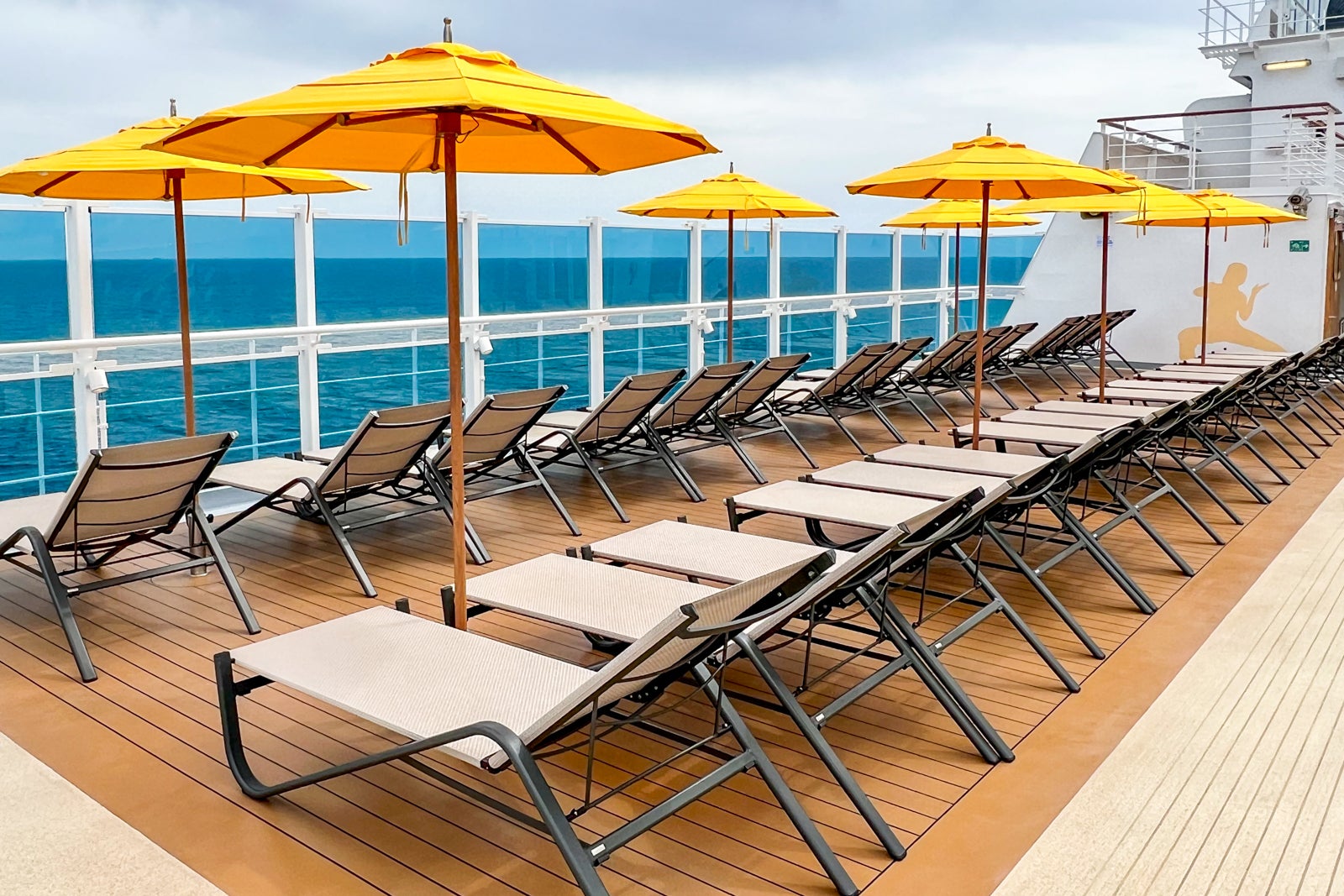
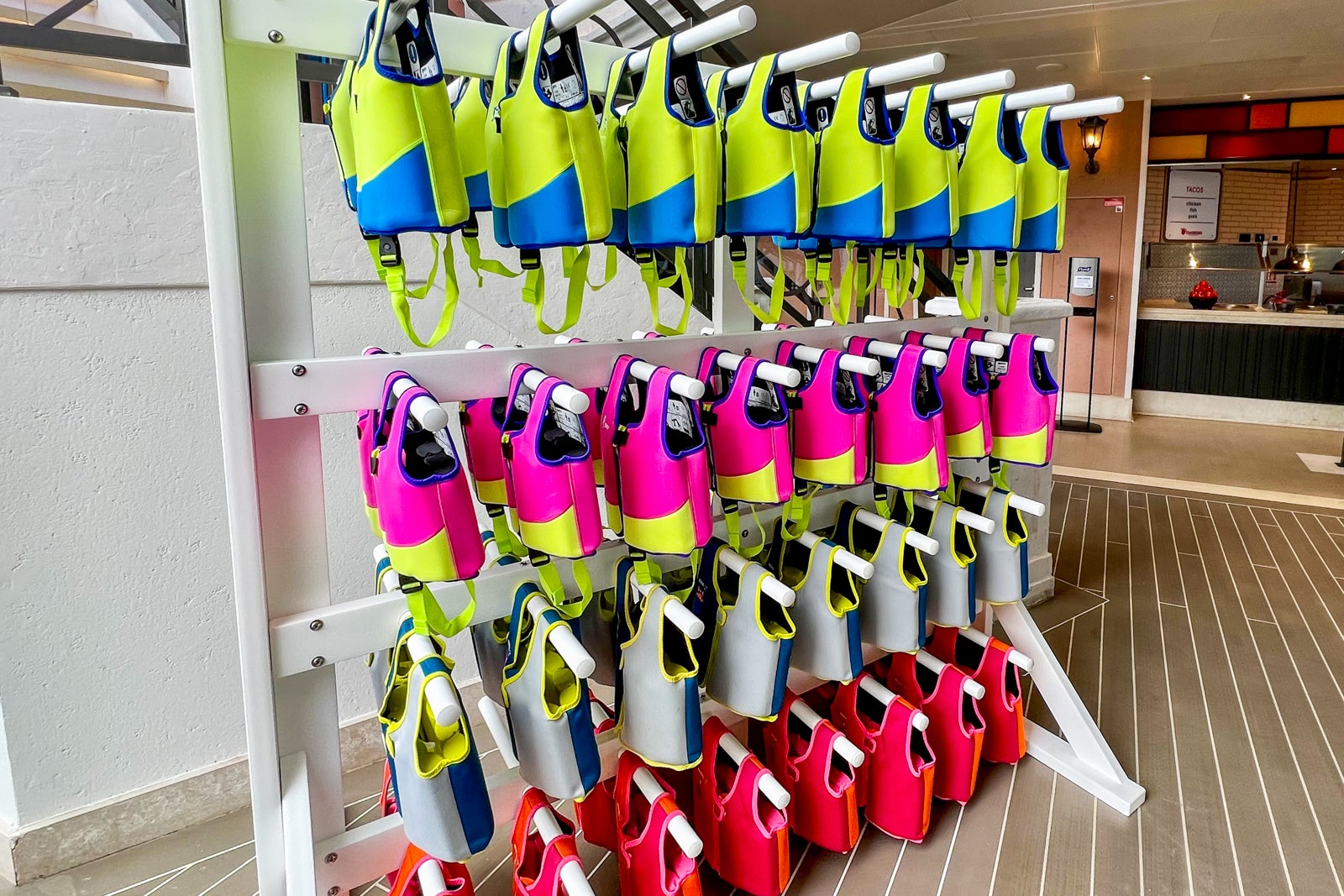
The Lido pool is, notably, built with a glass magradome that can be opened on sunny days and closed during inclement weather. This will be a plus when the vessel is sailing in colder locations, such as its season of sailings from New York City. But the magrodome eats up valuable real estate that otherwise would allow for more open-air lounge areas.
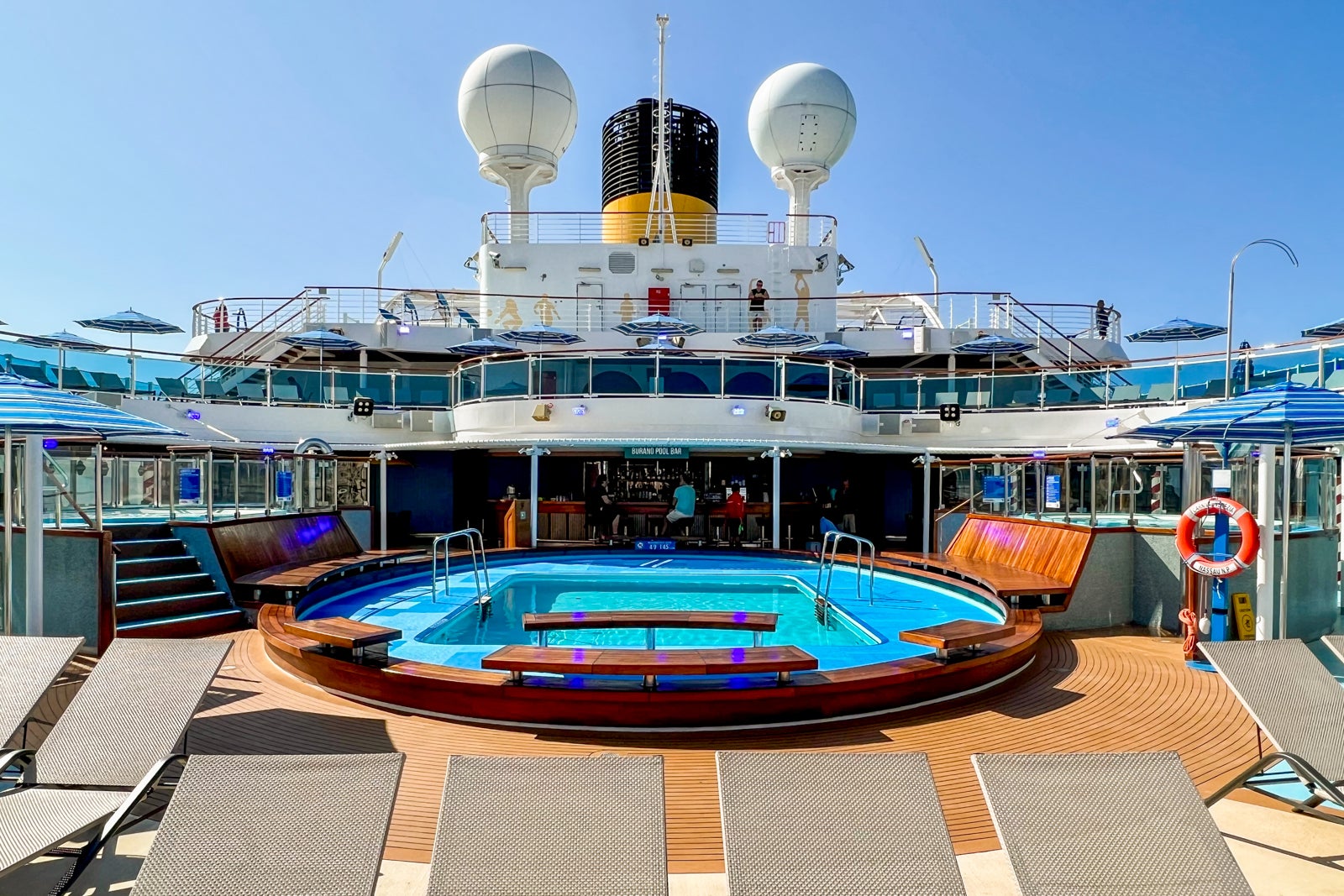
Other top-deck amusements include such Carnival classics as a ropes course where the challenge is stepping gingerly along ropes and platforms that tower 14 decks above the sea (you’re safely roped in at all times, of course). It doesn’t look all that scary from below, but — trust me — it’s a bit terrifying when you get up there, and your legs go all wobbly trying to make it across a floating-in-the-sky pathway.
There’s also a miniature golf course and a sports court that, like seemingly every other sports court at sea, has been newly rigged to allow for pickleball games.
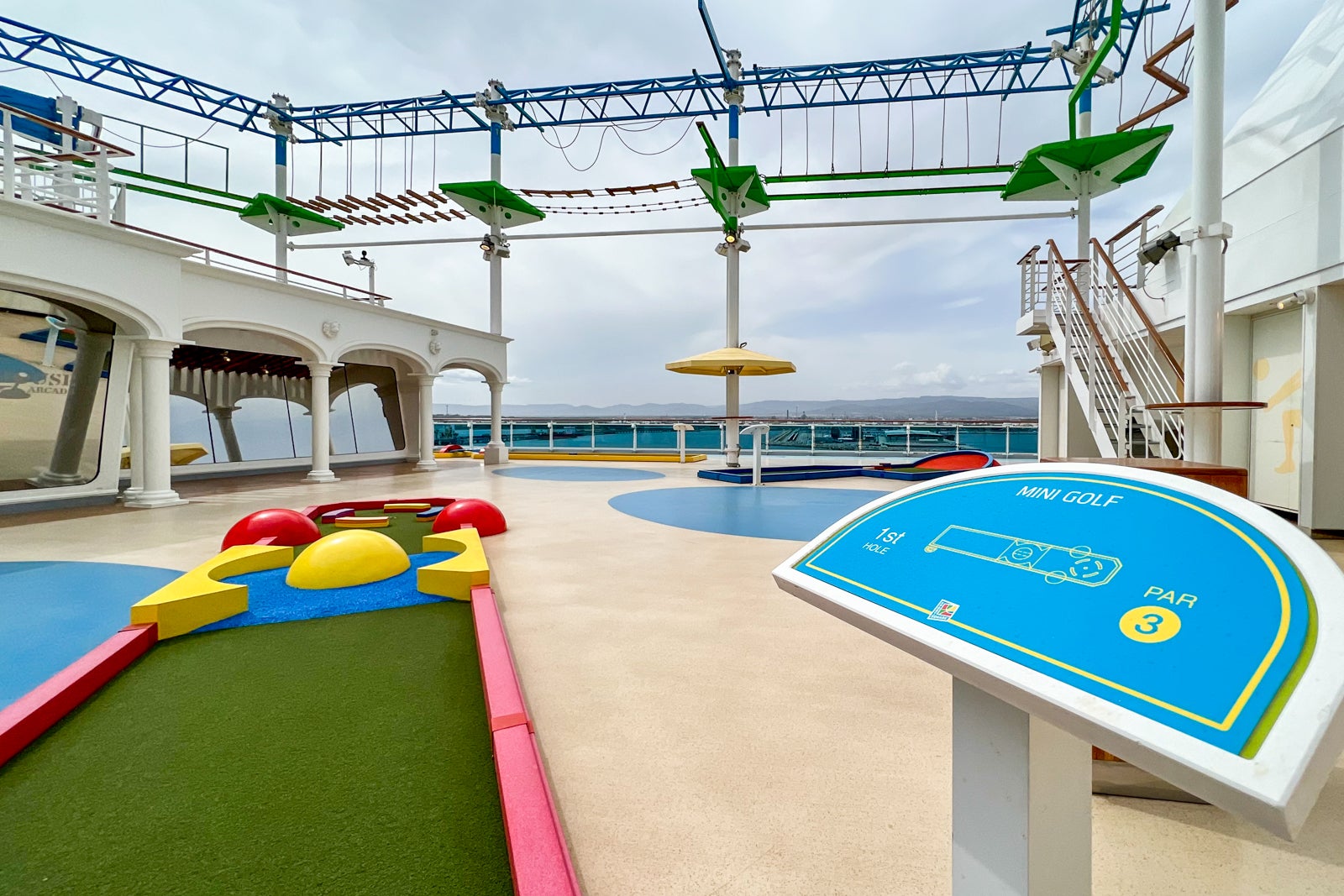

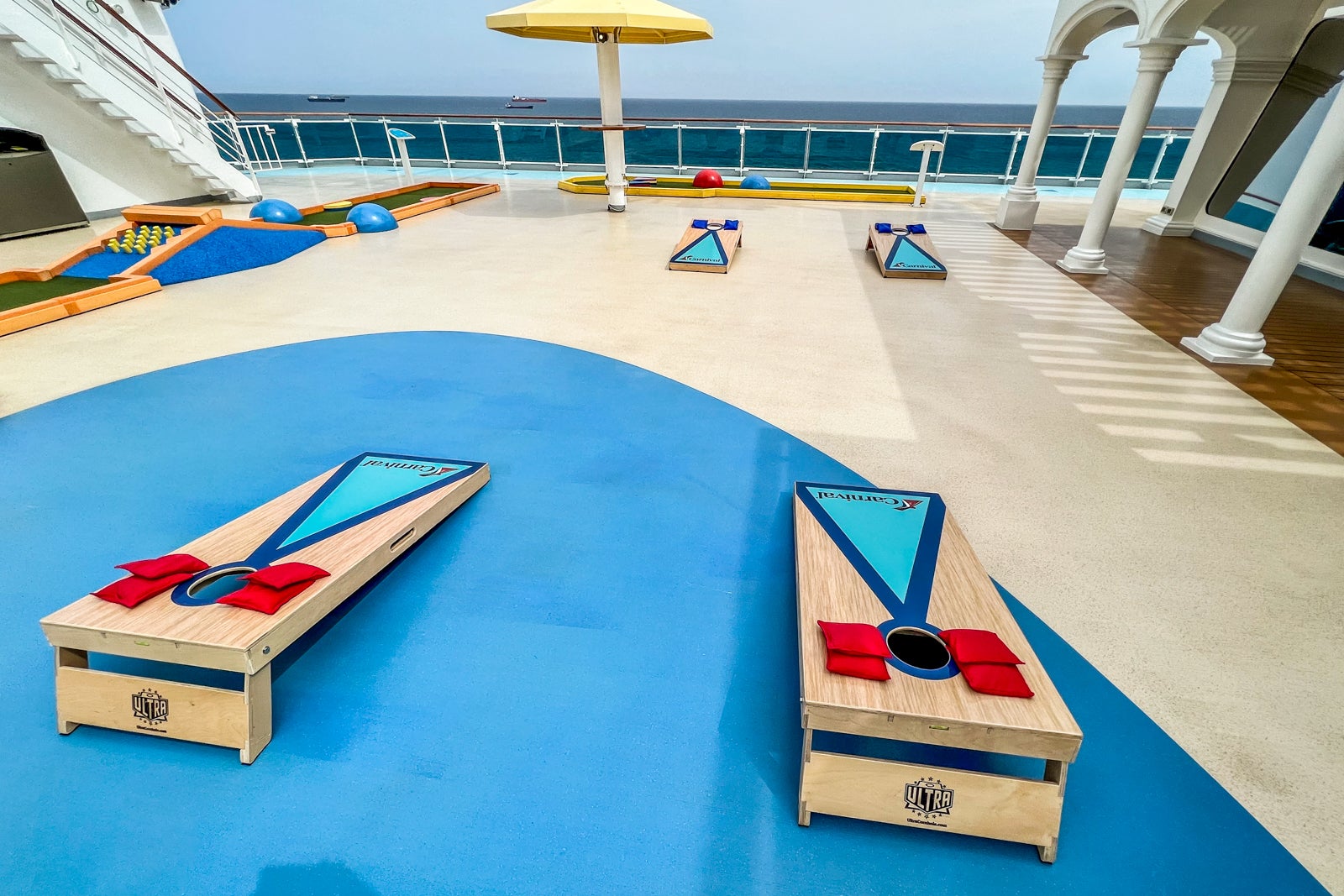
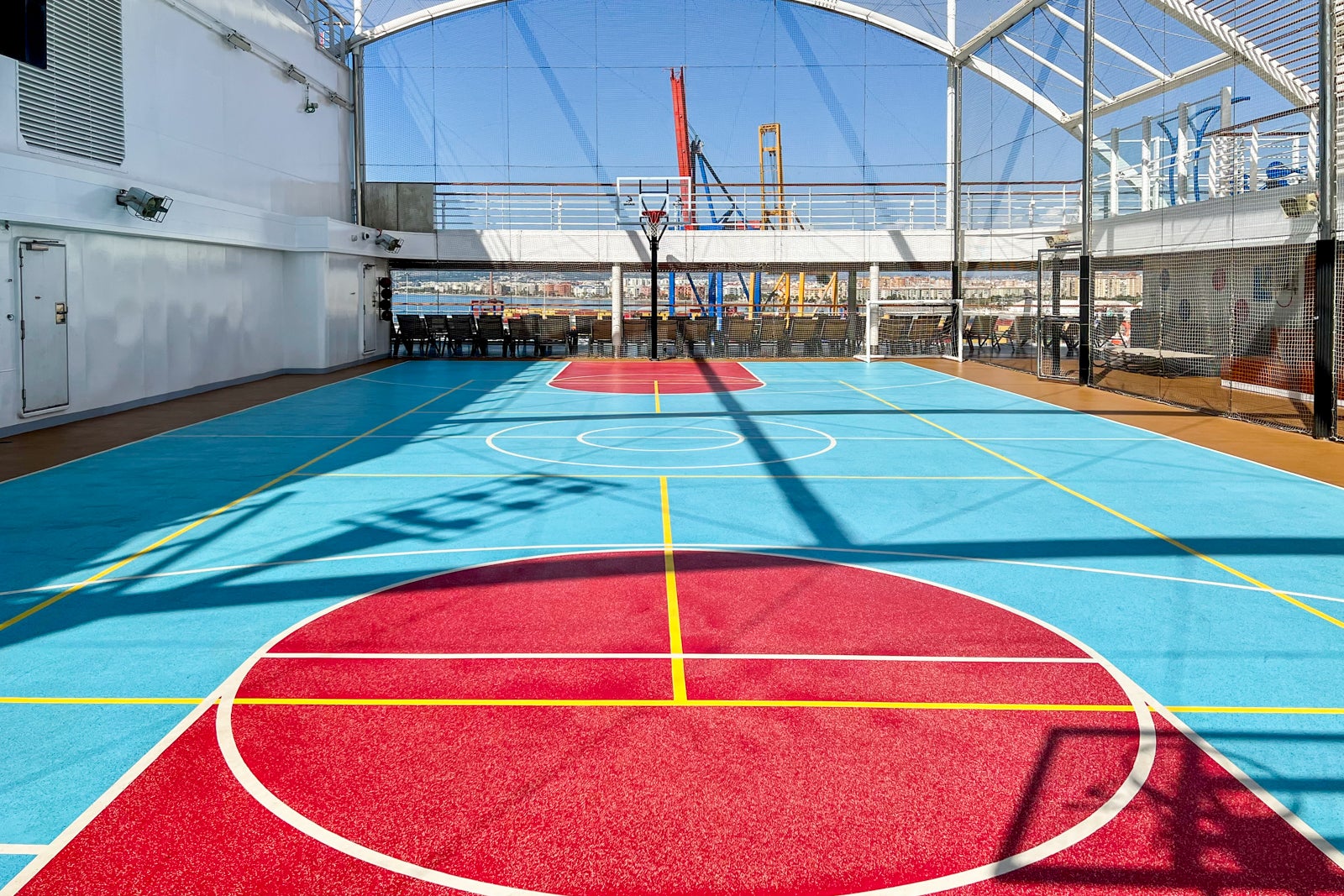
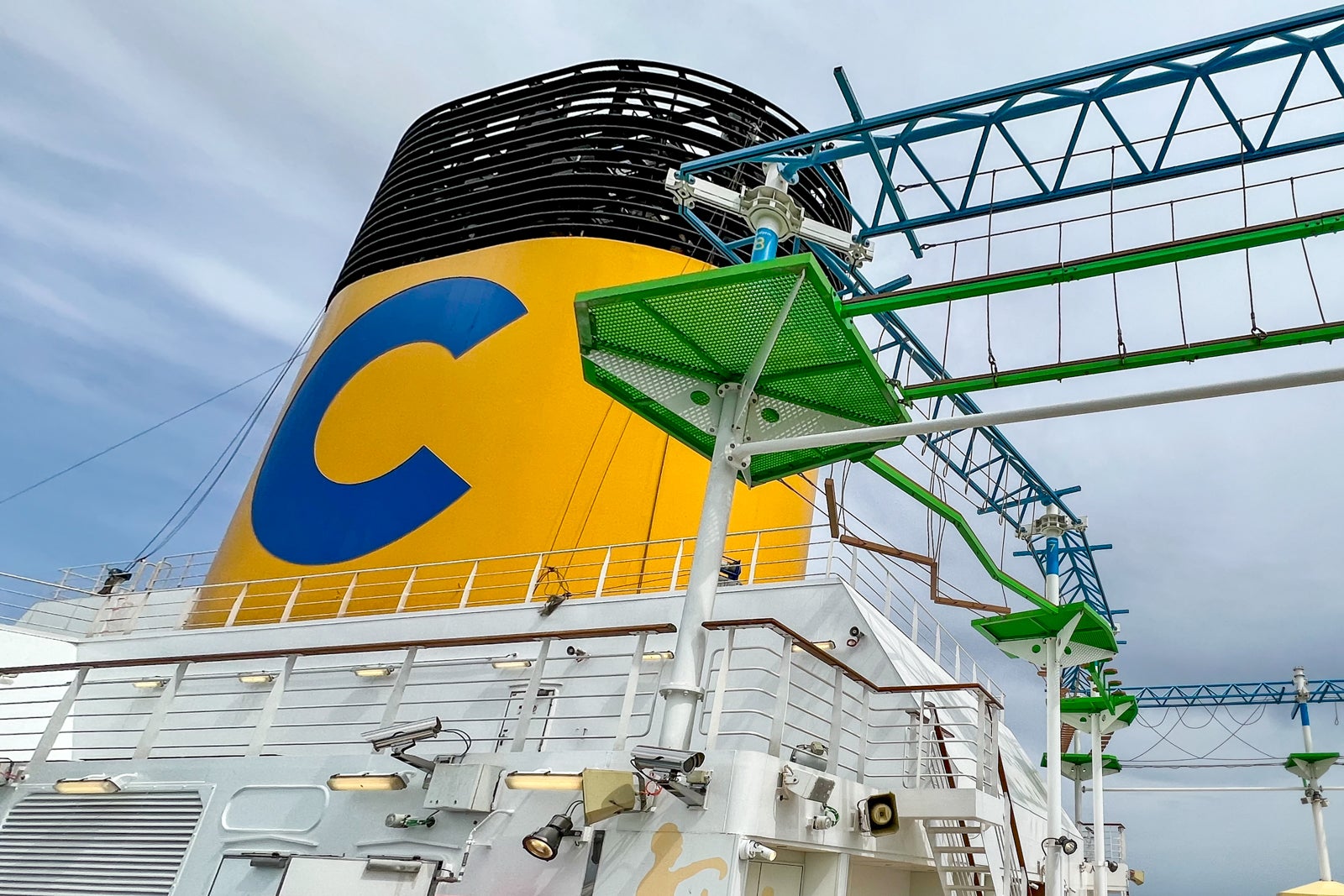
Carnival Venezia’s fitness center spans the entire front of deck 12 with epic views over the bow. The line made the space bigger during dry dock because Americans apparently like to exercise while on cruises more than Chinese travelers. A spa with 12 treatment rooms is in the same area, but the ship’s hair salon was moved to Deck 5 (at the top of the atrium) to make more room.
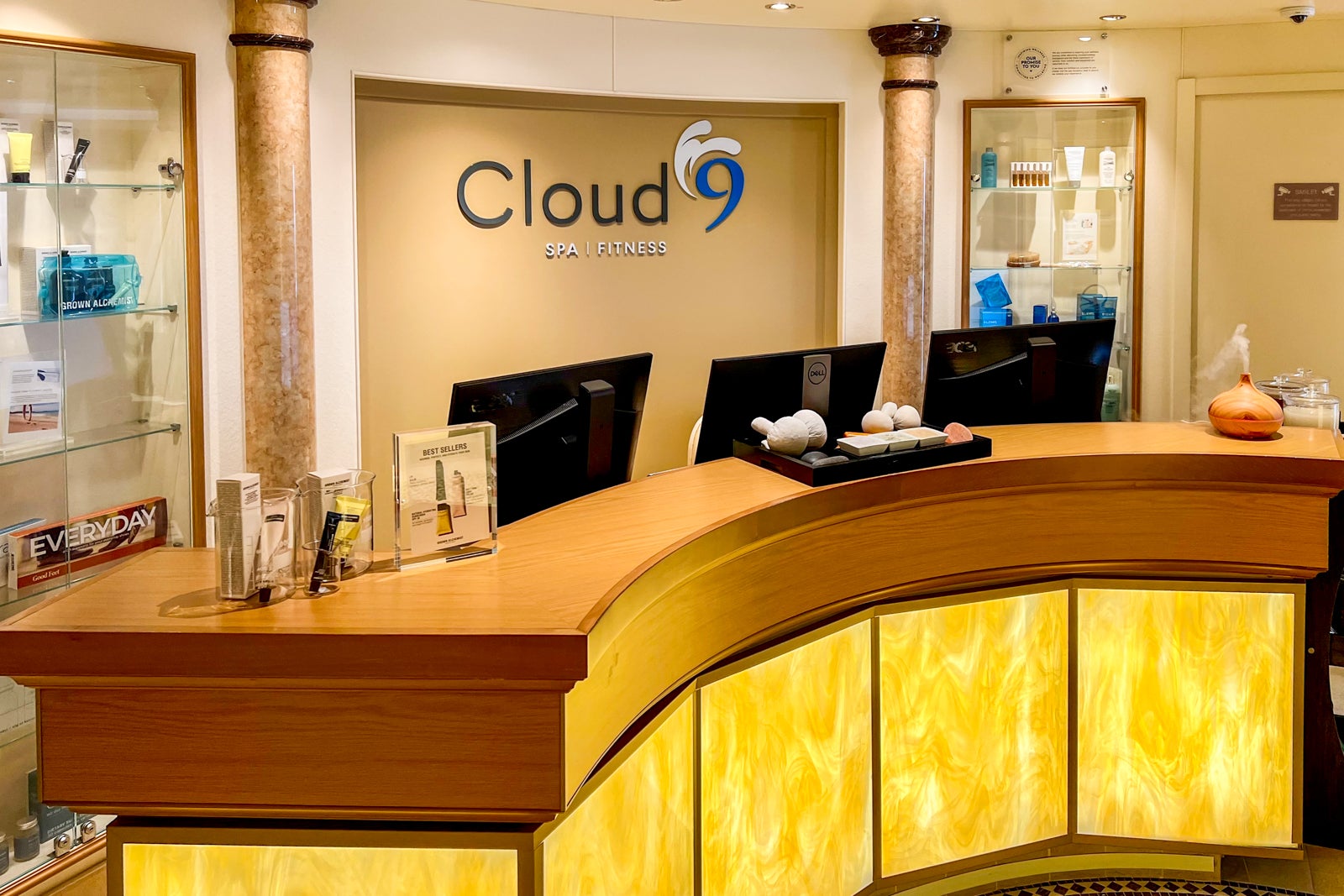
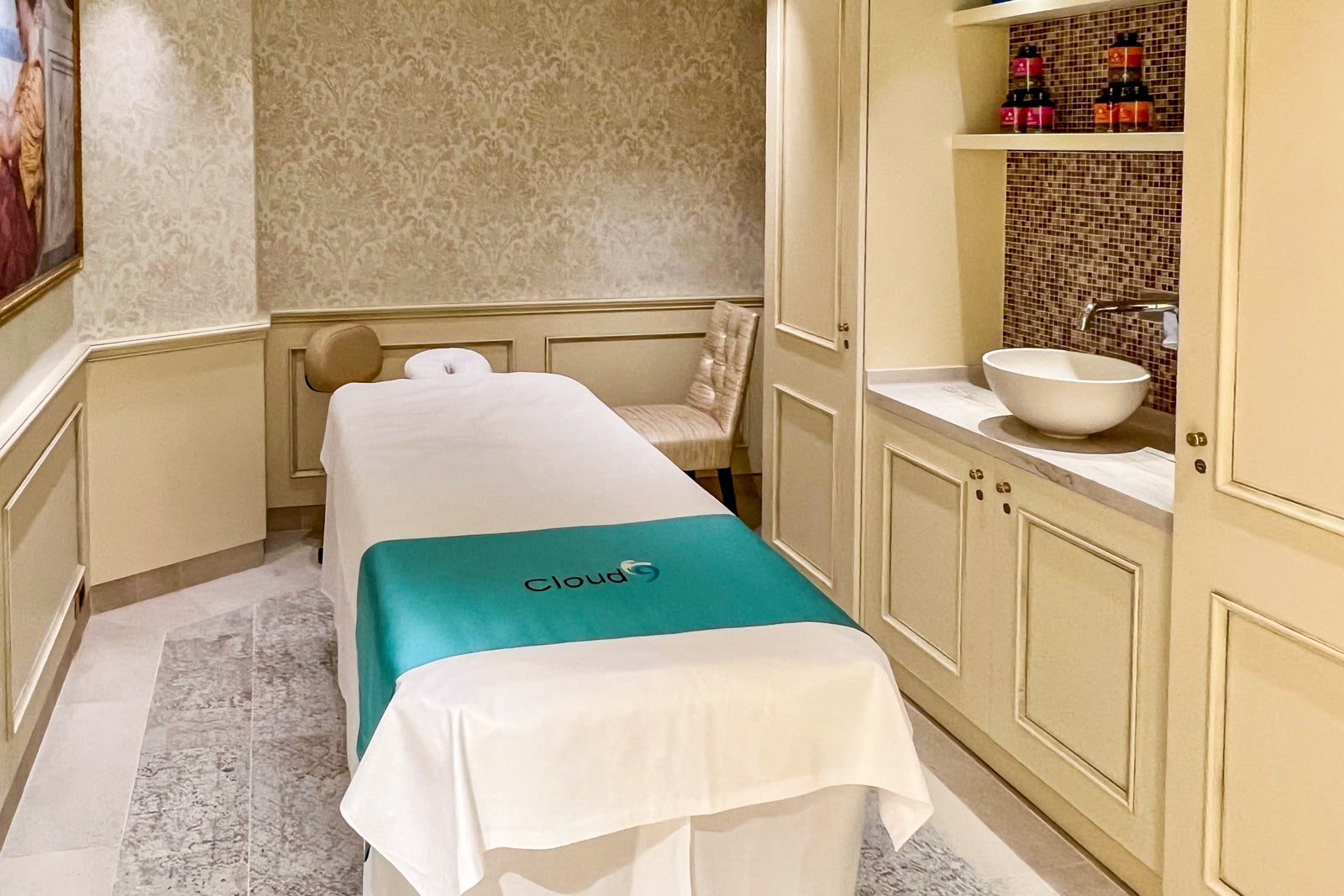
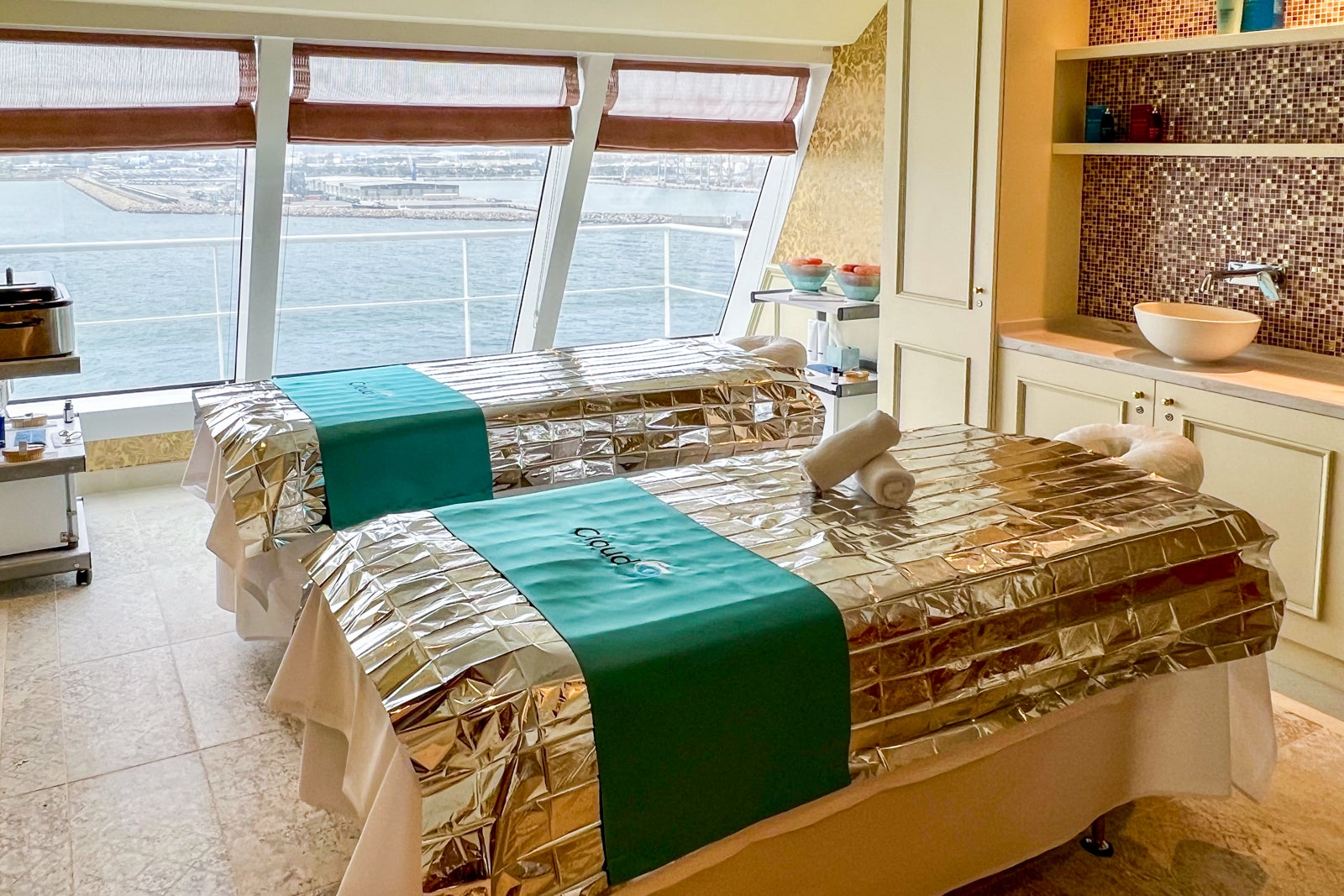
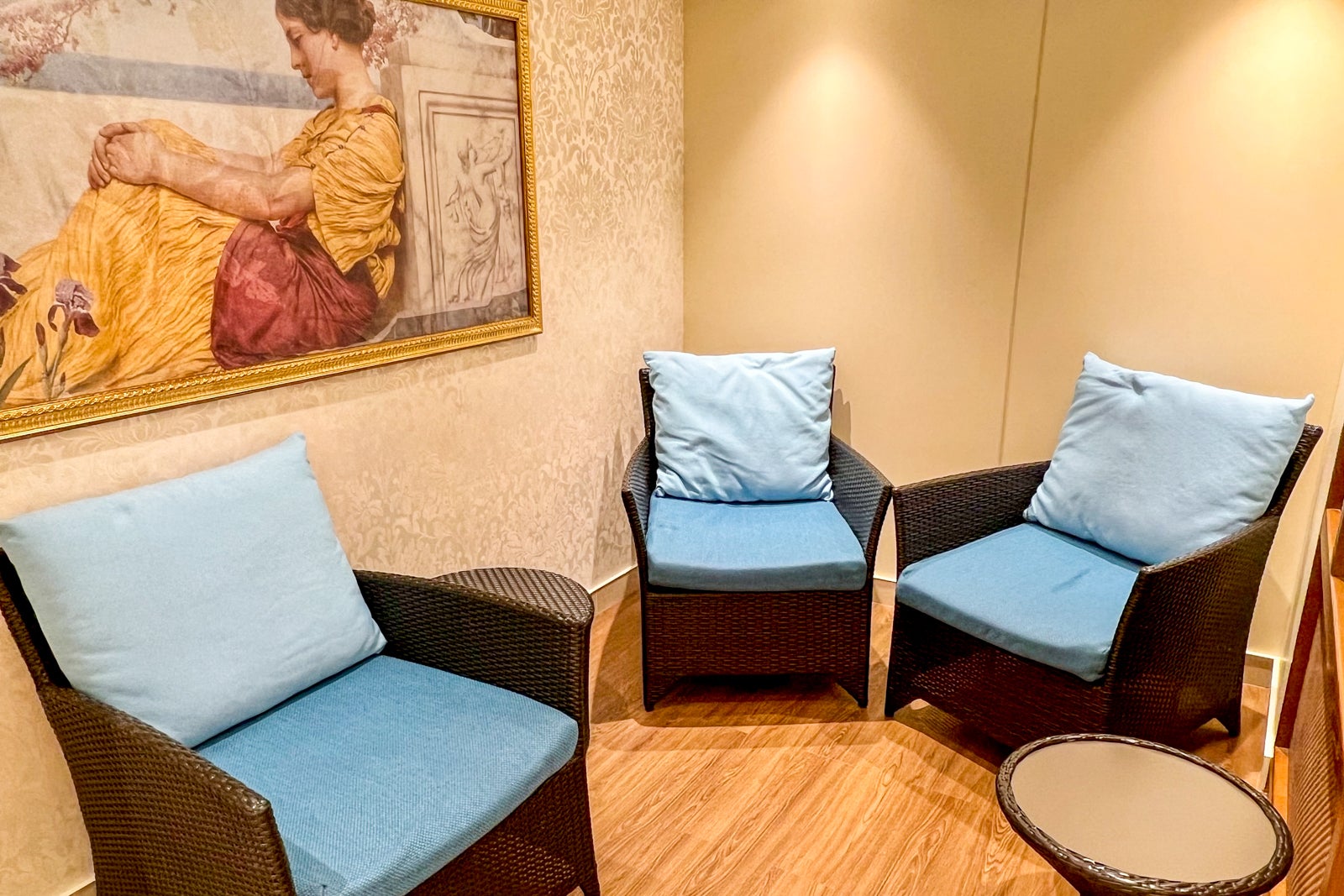
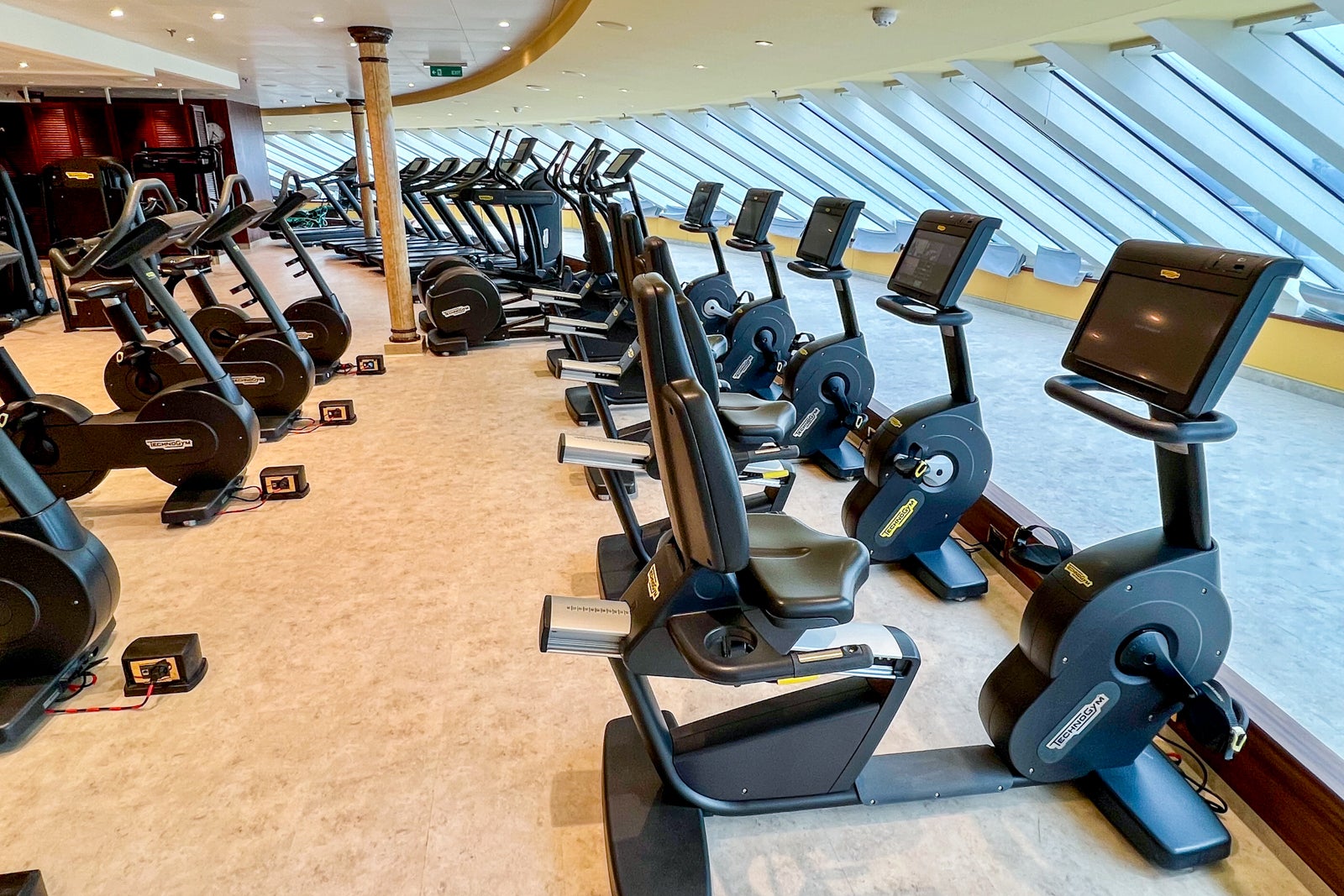
In the evening, the ship’s two-deck-high, Italian opera house-like Teatro Rosso and the smaller Limelight Lounge are the places for big entertainment. Teatro Rosso is the ship’s main theater. Performances here might be an elaborate song-and-dance show with Carnival Venezia’s resident performers or a comedy act or game show such as a Carnival version of television’s “Family Feud.” The Limelight Lounge morphs at night into the Punchliner Comedy Club with family-friendly shows in the early evening and R-rated versions late at night.
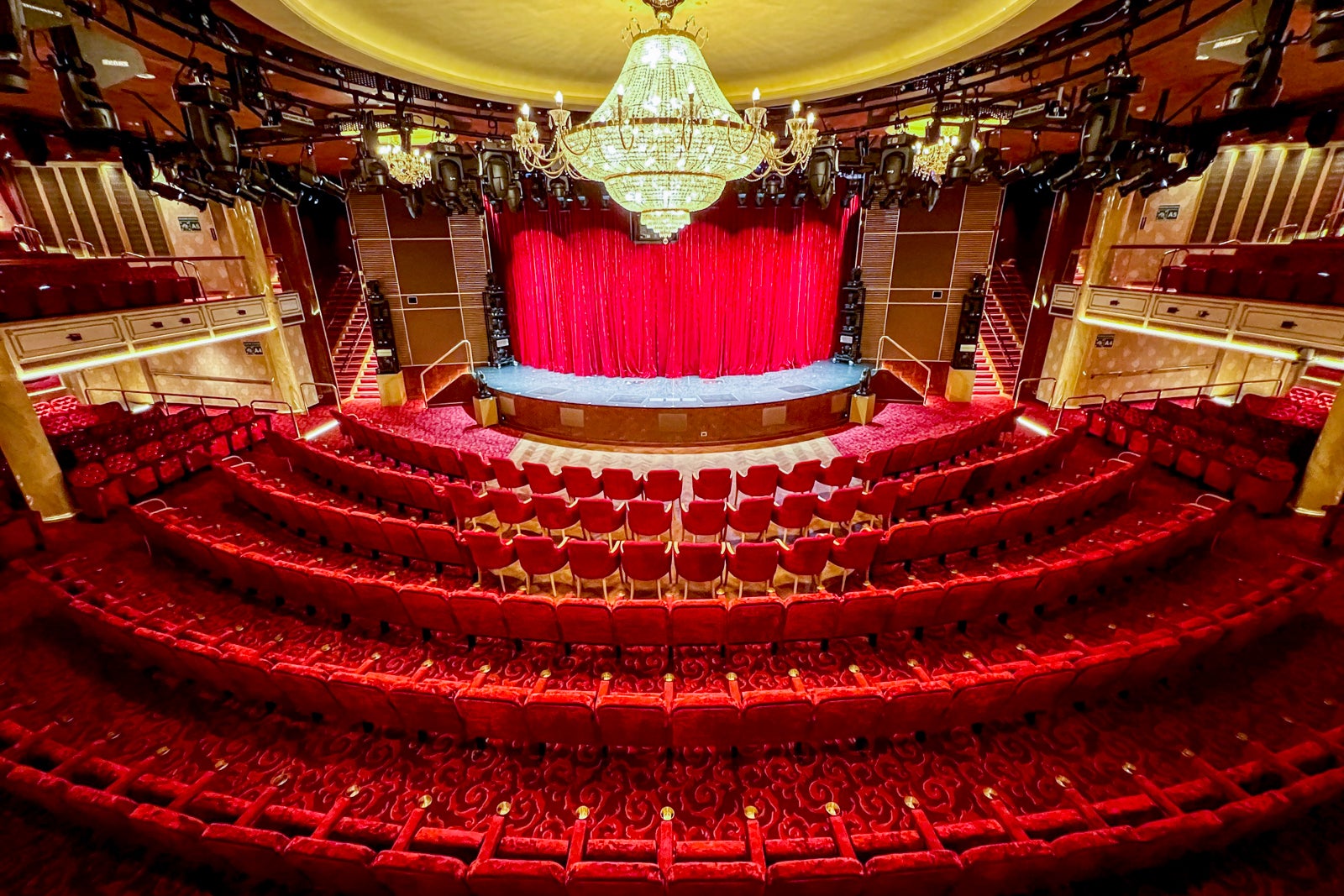
The Limelight Lounge also is where you’ll find occasional bingo games and shockingly good karaoke contests. Carnival regulars come prepared to sing!
Karaoke may also take place in the Terrazza Carnivale or Gondola lounges.
Carnival Venezia also has a large casino with — and this is unusual — a dedicated room for nonsmokers.
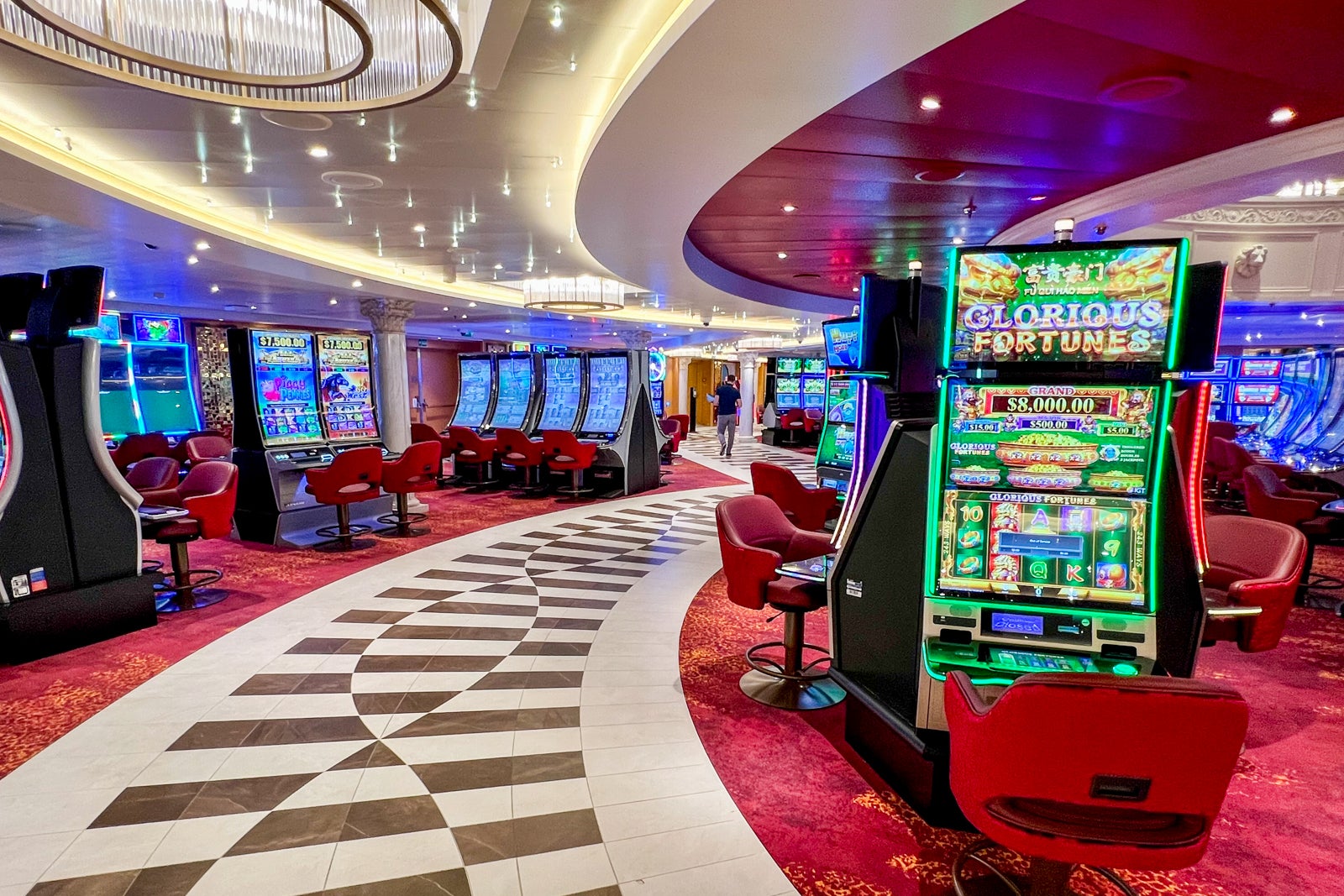
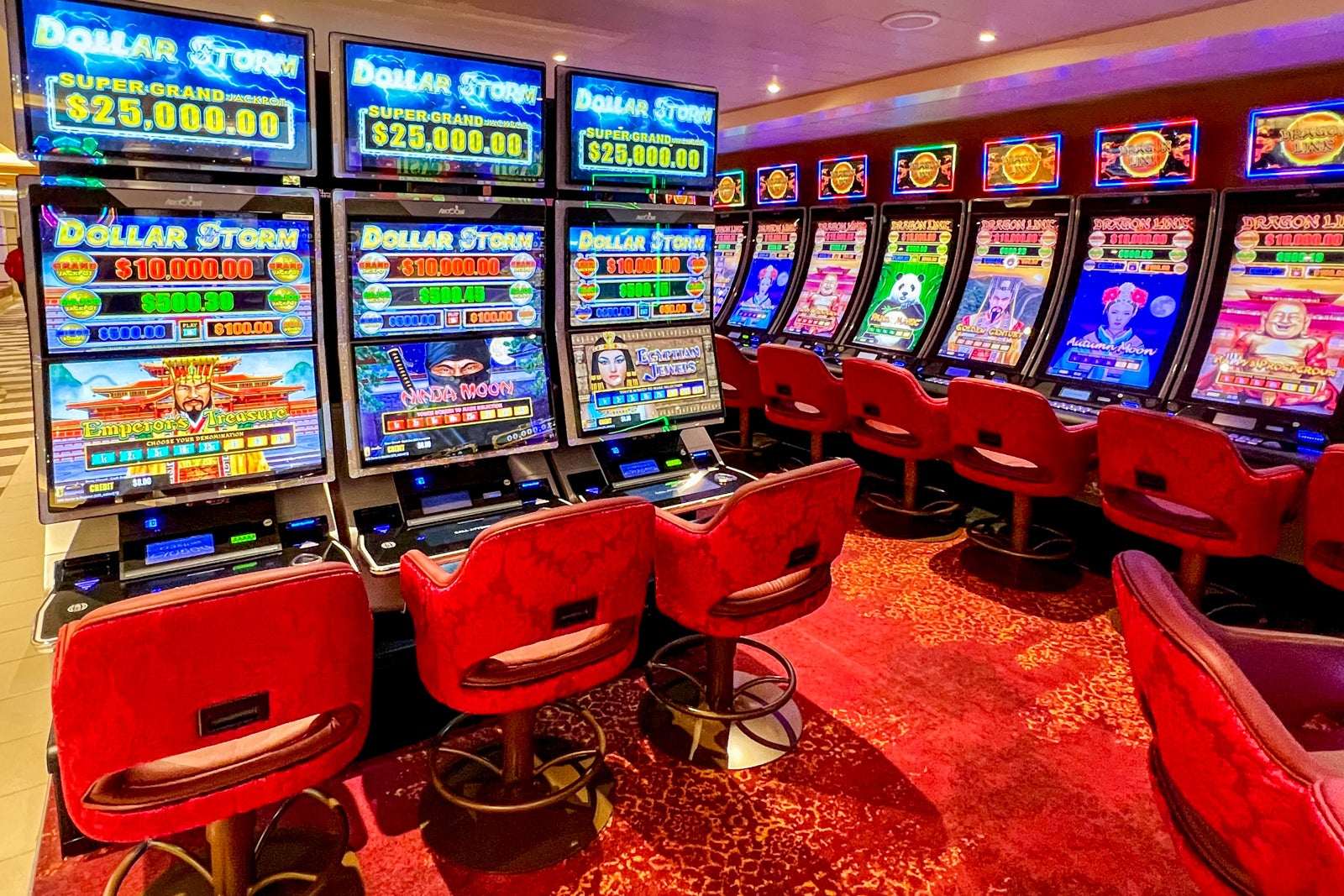
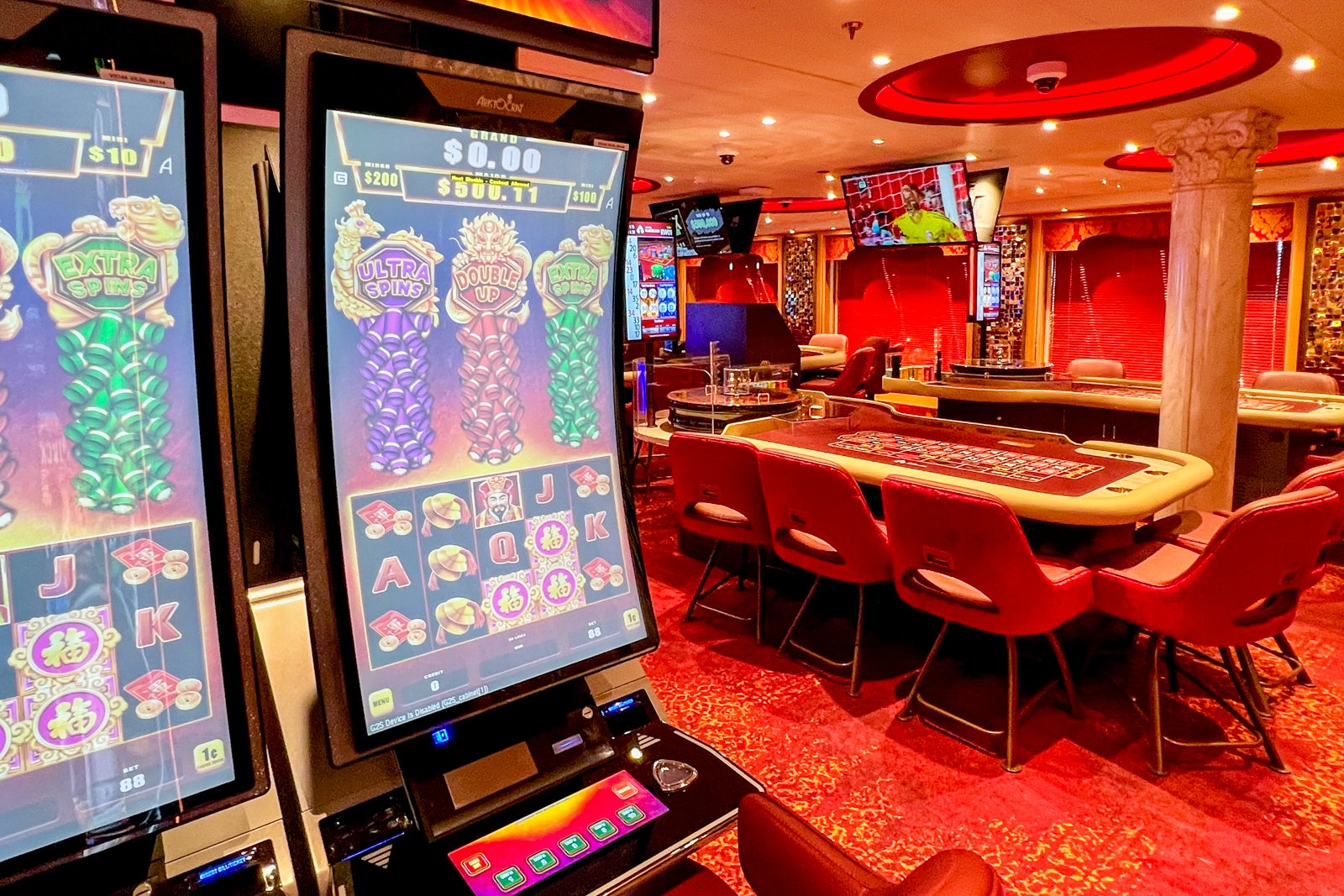
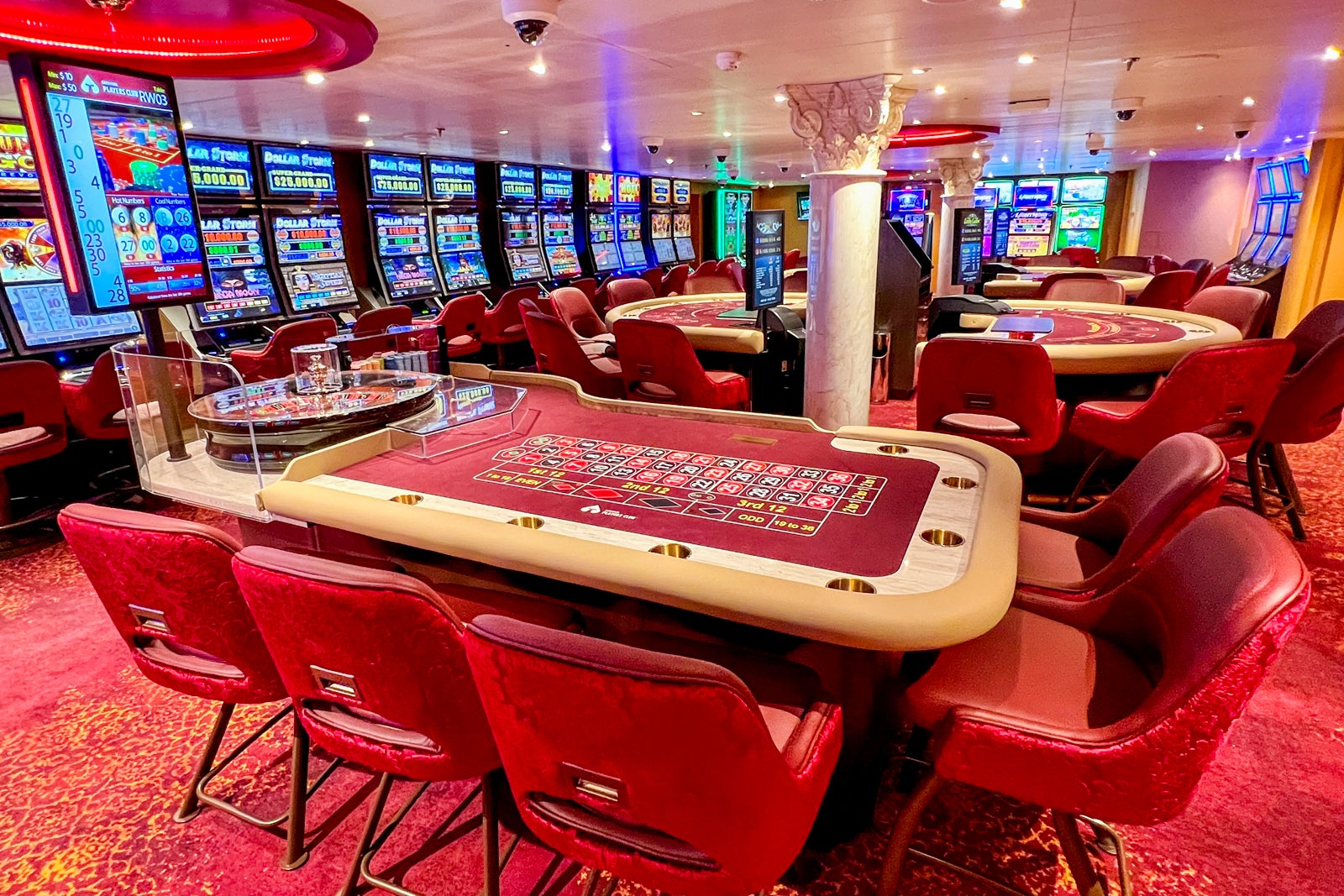
The ship also has multiple fun zones dedicated to children. The heart of the offerings is Camp Ocean, located on Deck 11. It offers free, supervised activities daily for children ages 2 to 11. The line splits children here into three age groups — Penguins (2-5 years), Stingrays (6-8 years) and Sharks (9-11 years). Each group has its own age-appropriate activities ranging from face painting to pirate adventures.
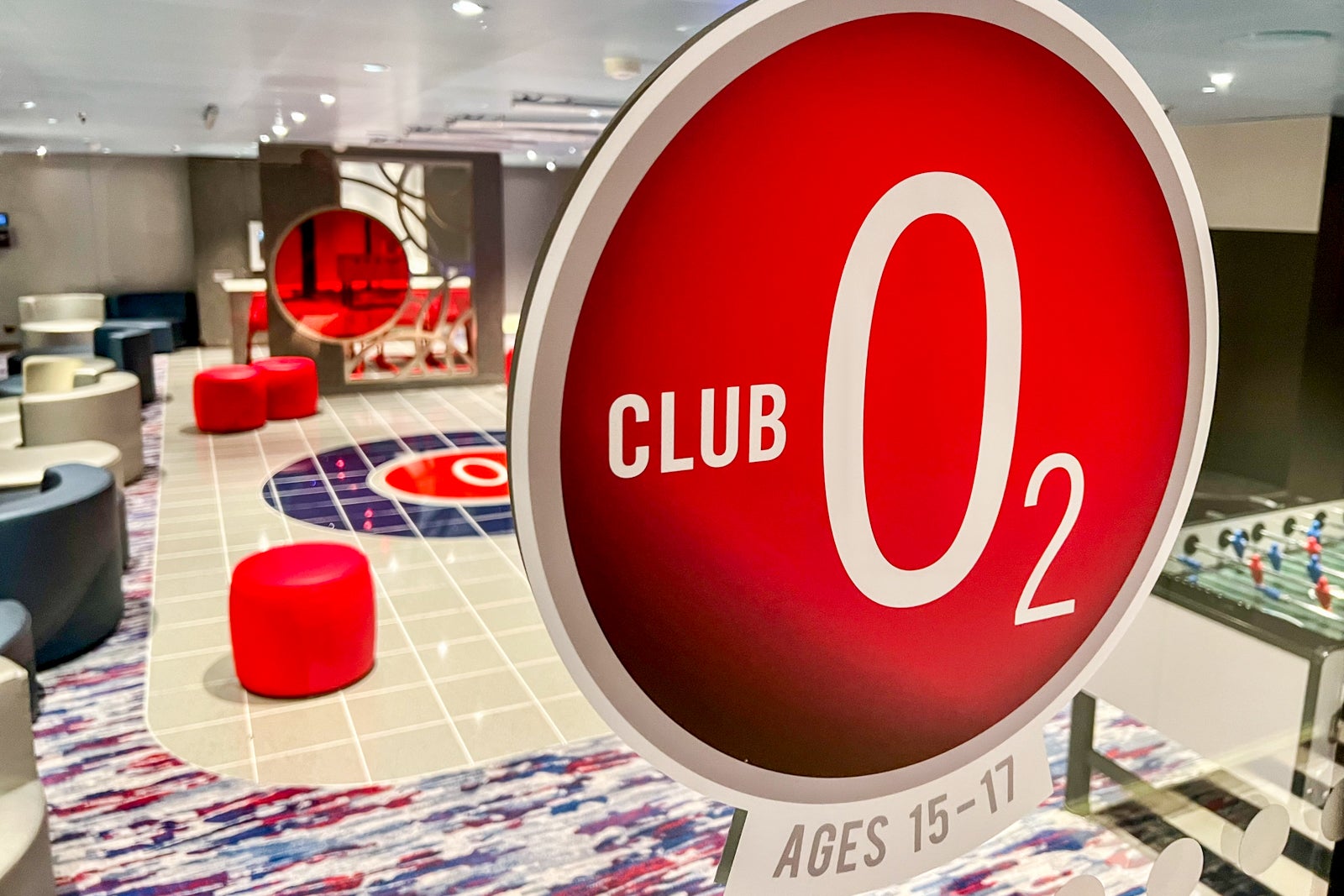
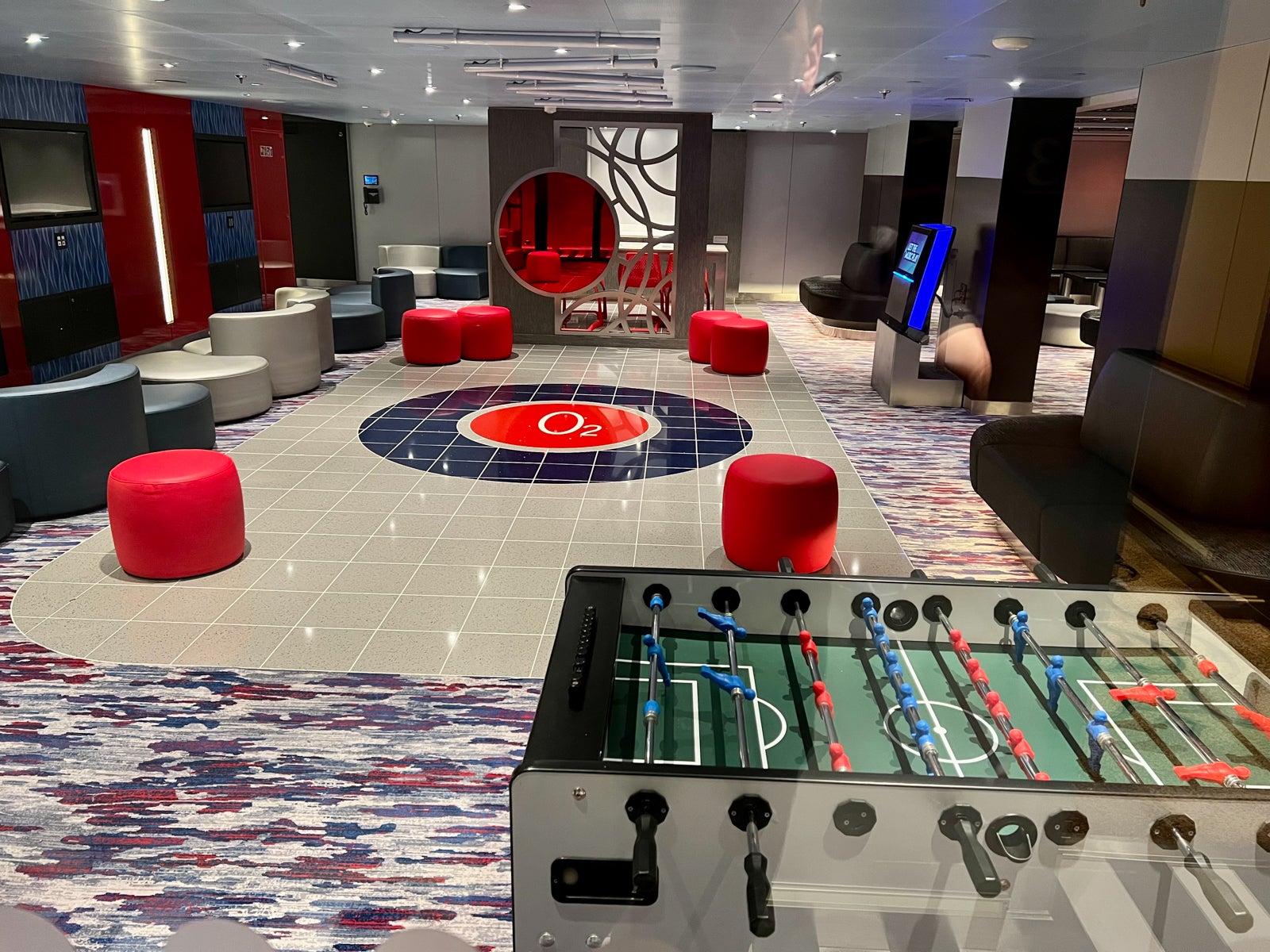
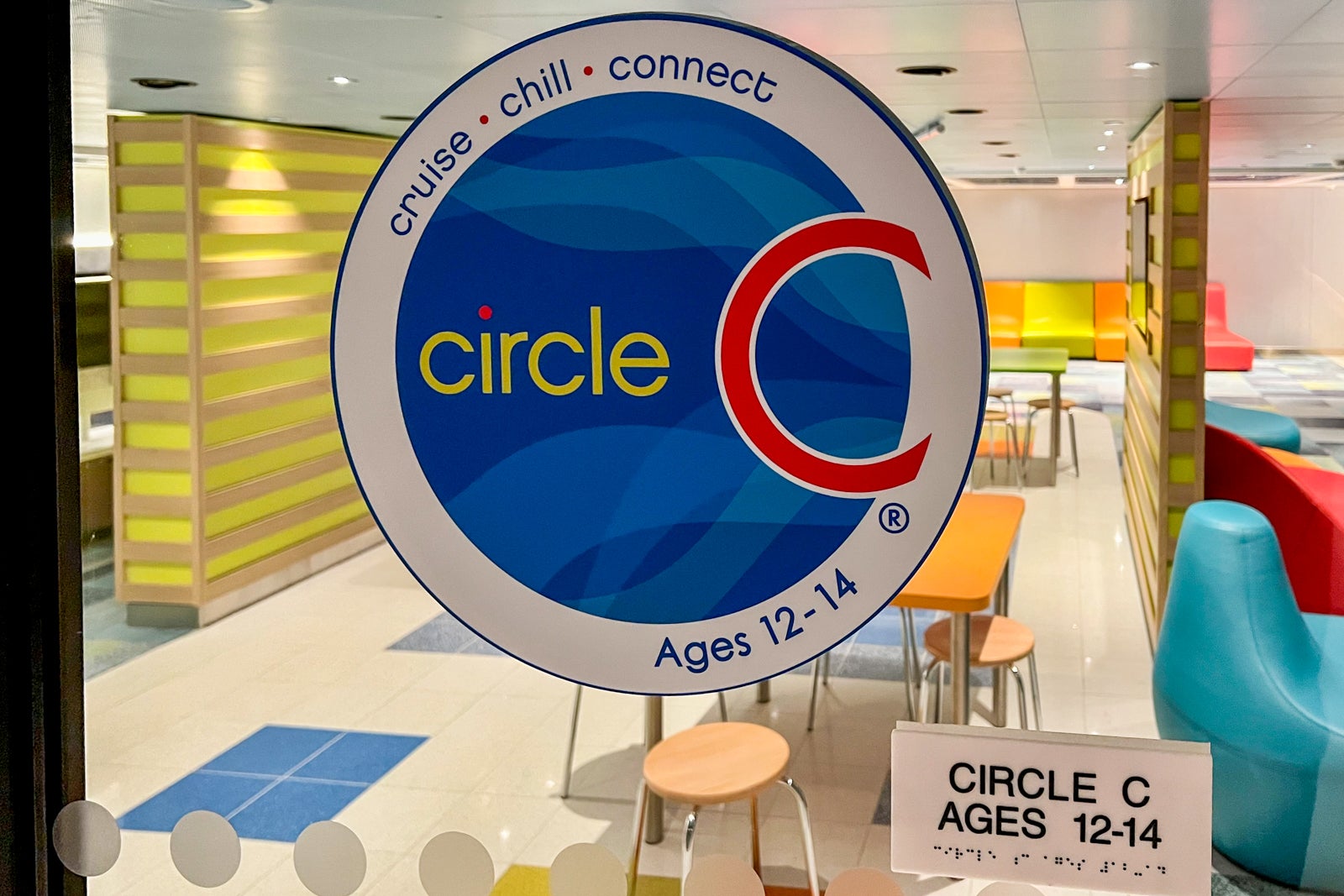
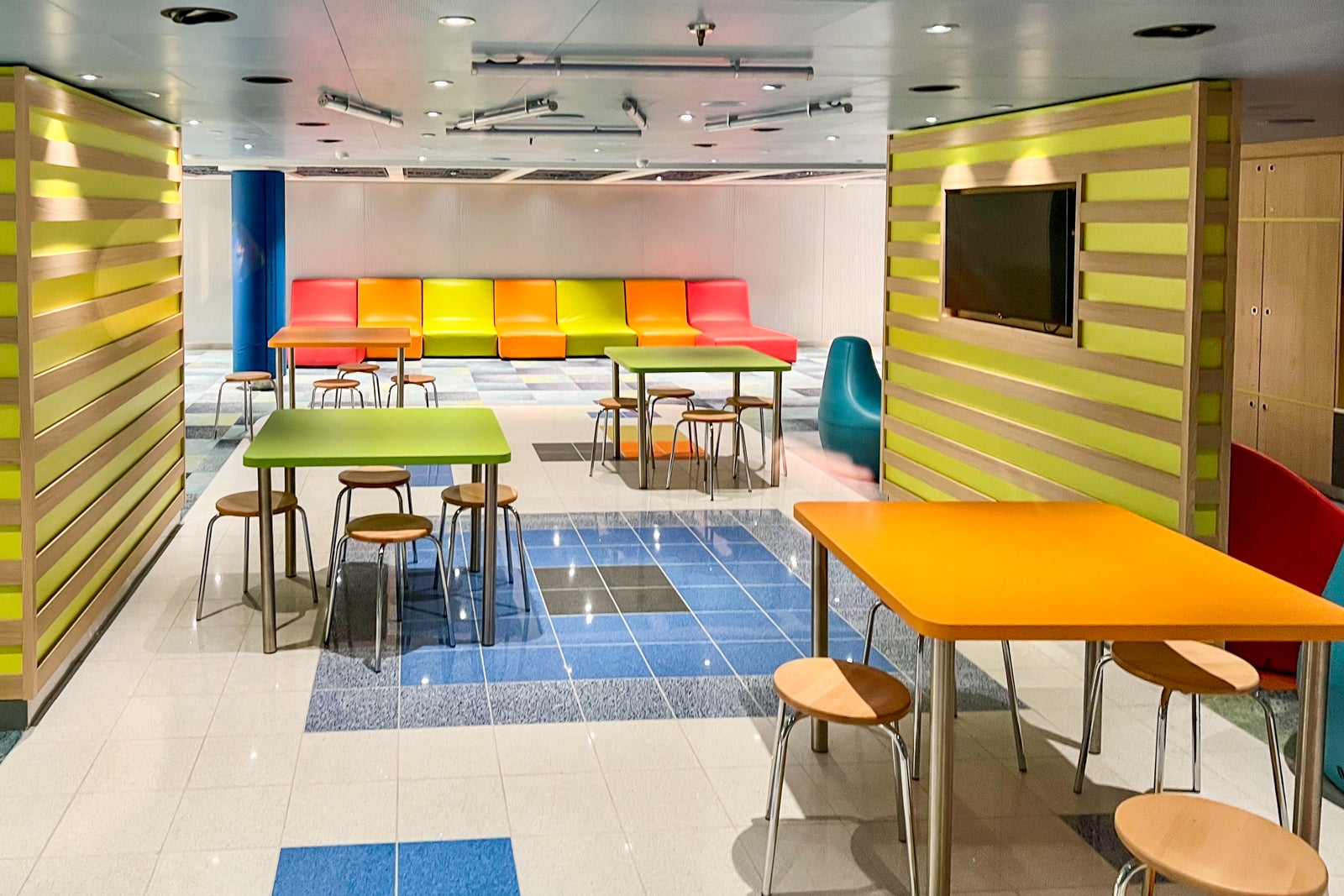
There’s also a hangout room called Circle C for tweens and teens ages 12 to 14 and a separate room for the older teen crowd (15 to 17) called Club O2. Both are tucked away at the front of the ship on Deck 3. If you wander toward them, you might come across a succession of no-longer-in-use small rooms built to be private karaoke rooms when the ship was destined for China. If you look closely, you can still make out what would have been the entrance and front desk for the karaoke area, now an oddly abandoned relic of what might have been for this ship.
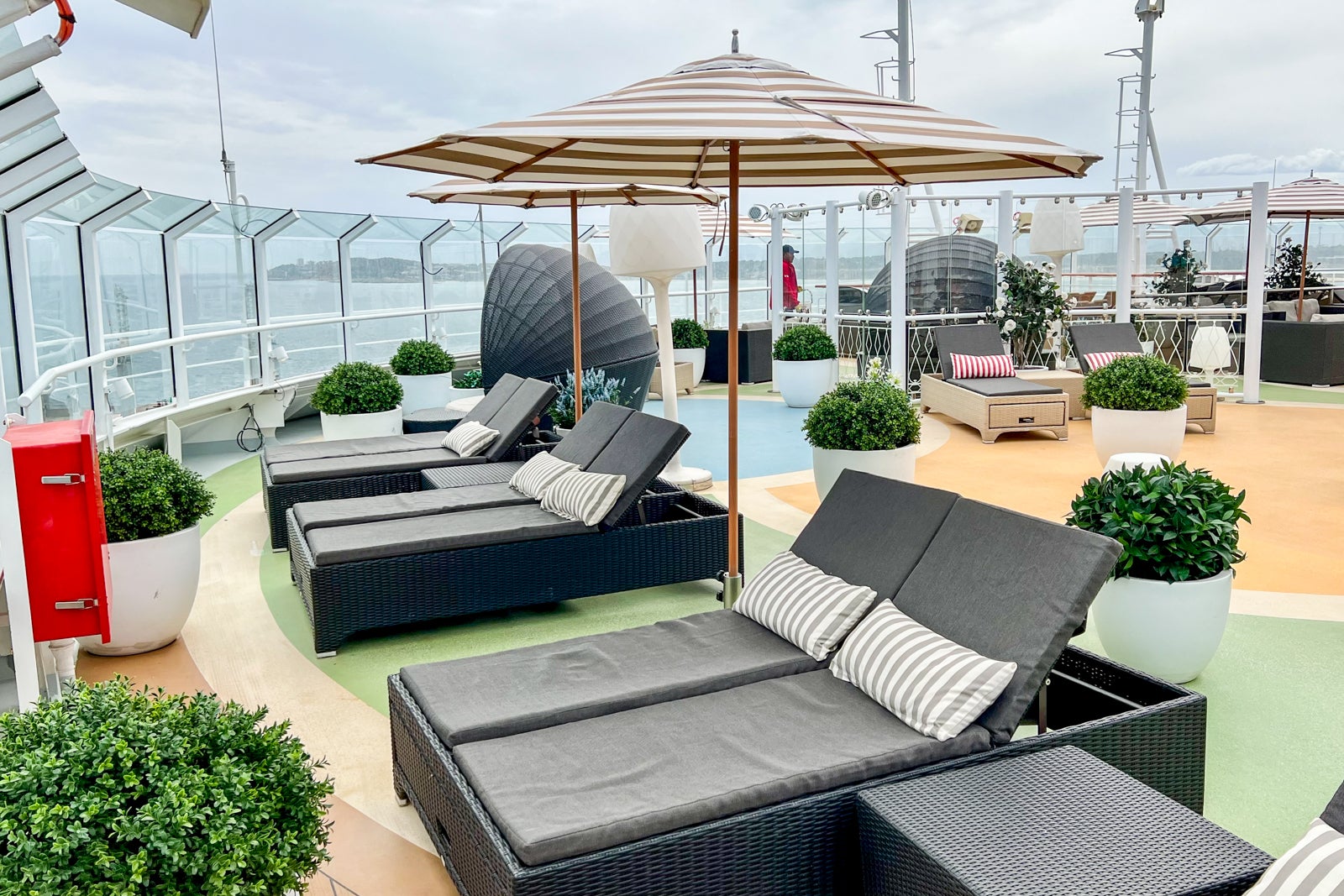
For adults looking to get away from the kids, meanwhile, the front of the ship’s top deck is devoted to an adults-only Serenity outdoor lounge area.
Carnival Venezia itineraries and pricing
Carnival Venezia will sail year-round out of New York through December 2024. After that, it’ll move to Port Canaveral, Florida, for sailings to the Caribbean.
The ship’s New York itineraries are unusually diverse, with 22 different routings available ranging from four to 15 nights in length. Destinations for the sailings out of New York include the Bahamas, the Caribbean, Bermuda, New England and Canada.
After moving to Port Canaveral, the ship will mostly sail seven-night Eastern and Western Caribbean voyages.
As of the publishing of this guide, fares for Carnival Venezia sailings were starting at $309 per person for the least expensive cabin on a four-night Caribbean sailing out of Port Canaveral. Seven-night Canada and New England sailings from New York start at $509 per person. Note that these fares are based on double occupancy and don’t include taxes, fees and port changes, which range from around $100 to $250 per person for most sailings.
What to know before you go
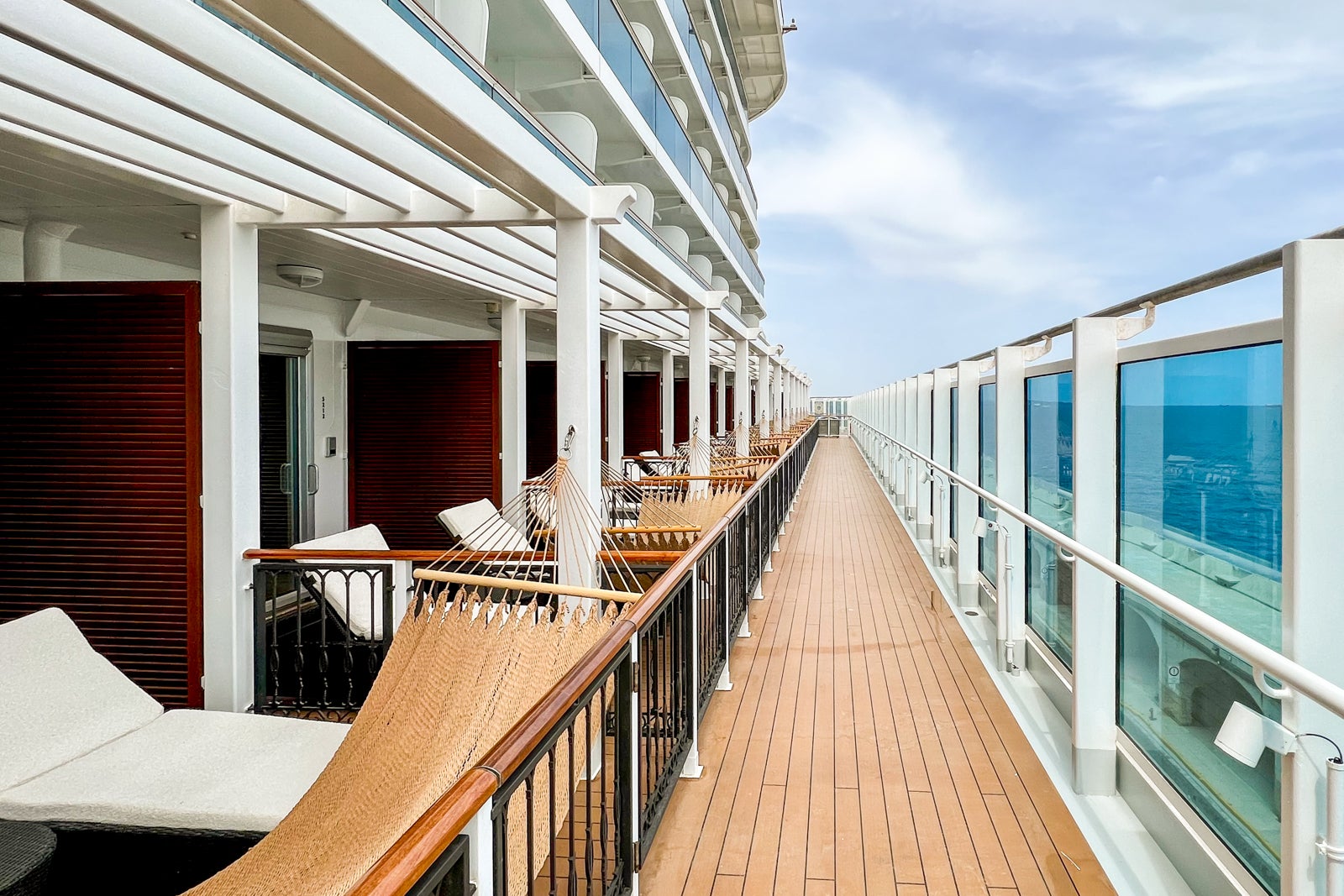
Required documents
If you’re a U.S. citizen, you’ll need a current passport or an official copy of your birth certificate and a driver’s license or other government-issued photo identification to sail. A few other forms of identification, such as a passport card, are also acceptable.
Passports must be valid for at least six months. Note that it is important that the name on your reservation be exactly as it is stated on your passport or other official proof of nationality.
Note that these are the rules for round-trip sailings out of U.S. ports of the sort Carnival Venezia will operate from New York and Port Canaveral over the next few years. If the ship eventually moves to another destination, these rules could change.
All this said, we recommend checking Carnival’s website before sailing for the latest on requirements.
Gratuities
Carnival adds an automatic service gratuity of $14.50 to $16.50 per person, per day to final bills, depending on the cabin category (children under the age of 2 are exempt). If you are unhappy with the service you receive, you can adjust this amount at the Guest Services desk before disembarking. Also, an 18% gratuity is added to bar bills and the cover charge of the Chef’s Table.
Wi-Fi
Wi-Fi service on Carnival Venezia is fast for a cruise ship. Carnival Venezia is one of a growing number of cruise vessels tapping into the new, super-fast Starlink satellite internet system developed by SpaceX, which has been revolutionizing internet speeds on ships.
However, you’ll pay a hefty premium to experience the fastest Wi-Fi speeds available on Carnival Venezia. On my sailing, the fastest “premium” service on the ship, which allowed for video streaming, was priced at $30 per person for a 24-hour pass. A full-cruise pass for the 15-night voyage cost $330 per person — or $22 a day.
Carnival Venezia also offers a less expensive “social” plan that only allows access to key social networking sites (Facebook, Twitter, Instagram, etc.) and messaging services such as WhatsApp. On my sailing, it was only available if bought for the entire cruise and cost $225 per person — or $15 per day.
A slightly more expensive “value” plan was also available at $22 per 24-hour period or $300 per cruise. The value plan adds access to email and most websites. Passengers who pay for a plan before sailing typically receive a discount.
Carry-on drinks policy
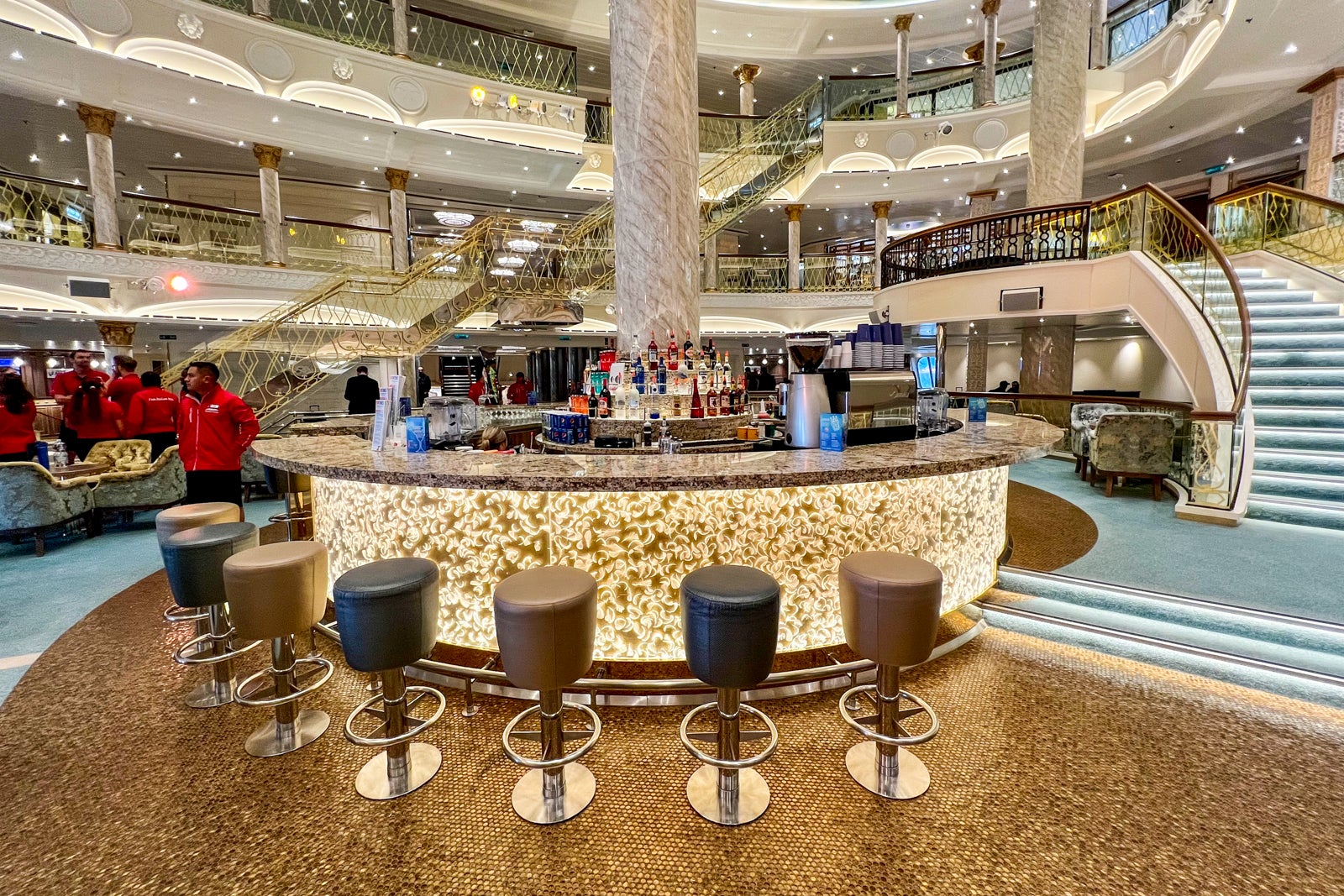
You can bring one bottle of wine or Champagne per person onto Carnival Venezia at boarding plus up to a dozen standard cans or cartons of nonalcoholic drinks such as sodas.
Nonalcoholic drinks in glass or plastic bottles are not allowed. You’ll be charged a $15 corkage fee if you want to bring your own wine or Champagne to an onboard restaurant or bar to drink. Drinks brought on board must be carried in your carry-on luggage.
Smoking policy
Cigarette smoking (including electronic cigarettes and personal vaporizers) is only allowed outdoors in designated areas on Deck 5 forward (starboard side) and Deck 11 aft (starboard side) and in the casino. You cannot smoke in the casino unless you are seated and playing; smoking is not allowed at the casino bar or in the entire casino area when the casino is closed.
Smoking is forbidden in cabins and on cabin balconies.
Cigar and tobacco pipe smoking is only permitted at the outdoor smoking area on Deck 11 aft (starboard side).
Laundry
Unlike most Carnival ships, Carnival Venezia does not have self-serve launderettes on cabin decks with washing machines, dryers, irons and ironing boards. You can pay to send out your clothes to be washed and/or pressed. As of the publishing of this guide, the cost for washing and pressing a dress shirt or blouse was $6; the cost for cleaning trousers was $6.50.
Electrical outlets
Carnival Venezia’s cabins and suites offer USB ports next to beds. You’ll find both U.S. 110V and European 230V outlets, as well as additional USB ports at built-in cabin desks. Americans may want to bring an adapter for charging devices in public rooms where the outlets are all European-style.
Currency
The onboard currency is the U.S. dollar.
As is typical for cruise ships, Carnival Venezia operates on a “cashless system,” with any onboard purchases you make posting automatically to your onboard account. You’ll receive a Sail & Sign card that you can use to make charges. This same card also gets you into your cabin.
Drinking age
You must be 21 or older to consume alcohol on Carnival Venezia.
Dress code
During the day, there is no specific dress code, and people dress casually. If it’s a sea day in a warm-weather destination, and you’re bound for the top deck, that means looking like you’re going to the beach. T-shirts, shorts and bathing suits (with a cover-up to go inside) are just fine.
During the evenings, the official dress code is pretty laid-back. Most nights are designated “cruise casual,” which means just that — khakis or jeans, polo shirts, sundresses, etc. Super casual items such as cutoff jeans, men’s sleeveless shirts, T-shirts and gym shorts aren’t permitted.
One or two nights a cruise, there will be a more formal “cruise elegant” night where men are expected to turn out in dress slacks and a dress shirt, preferably with a sports coat or even in a suit. The suggested attire for women on such nights is cocktail dresses, pantsuits, elegant skirts and blouses.
Related: The ultimate guide to packing for a cruise
Bottom line
Carnival Venezia is an affordable ship that will appeal to a wide range of vacationers including families, couples and friends groups looking for fun in a not-too-fancy, not-too-pretentious setting. It has a distinctively Italian vibe because it was originally built for Italy-based Costa Cruises, a sister brand to Carnival. But Carnival fans will find all of their favorite venues on board, thanks to updates to the vessel since it joined the Carnival fleet.
If anything, Carnival Venezia has a classier look than some Carnival ships, particularly the line’s older vessels. We found its Italian theming fun in a way that will fit right into the fun-focused Carnival fleet, and its new Italy-themed venues (Il Viaggio, Amari bar) are an upgrade for Carnival in our eyes.
Planning a cruise? Start with these stories:
- The 5 most desirable cabin locations on any cruise ship
- A beginners guide to picking a cruise line
- The 8 worst cabin locations on any cruise ship
- The ultimate guide to what to pack for a cruise
- A quick guide to the most popular cruise lines
- 21 tips and tricks that will make your cruise go smoothly
- 15 ways cruisers waste money
- The ultimate guide to choosing a cruise ship cabin

Leave a comment